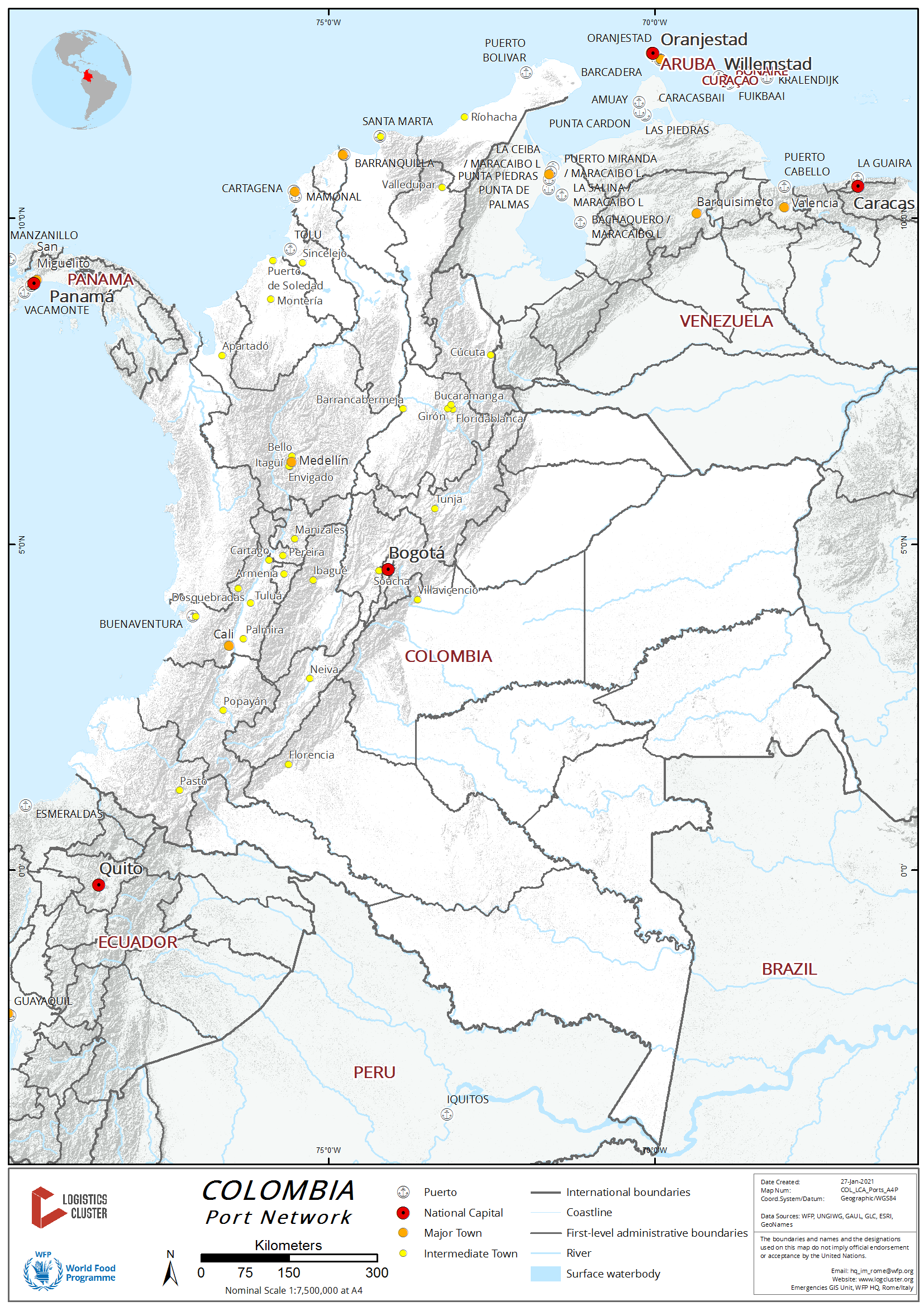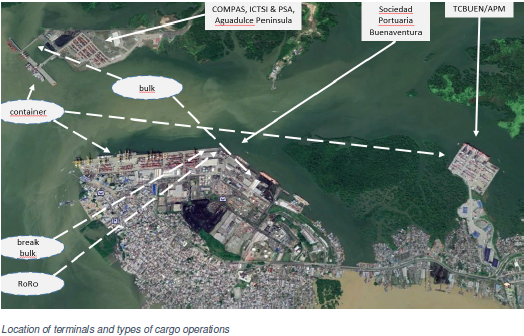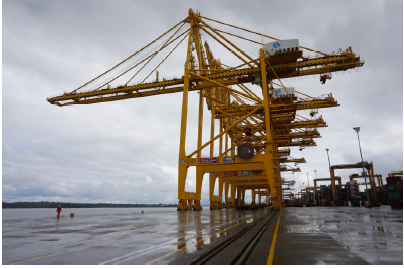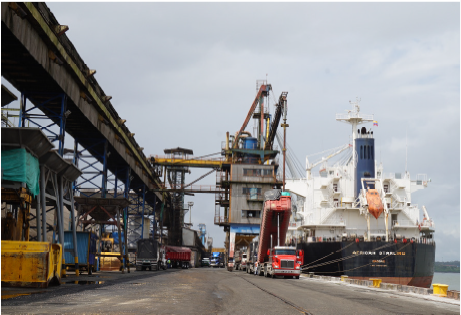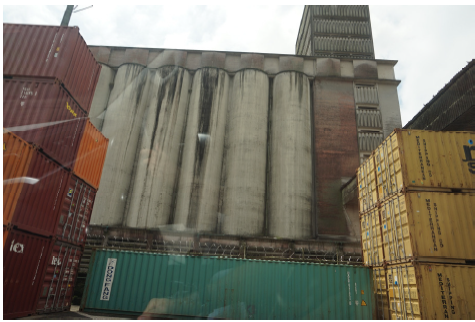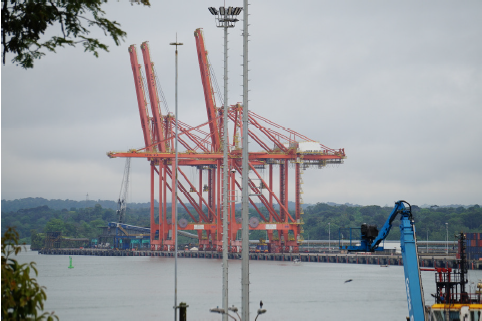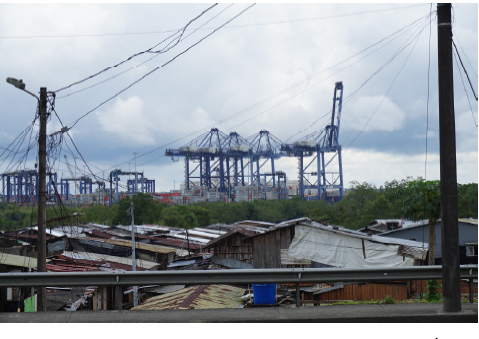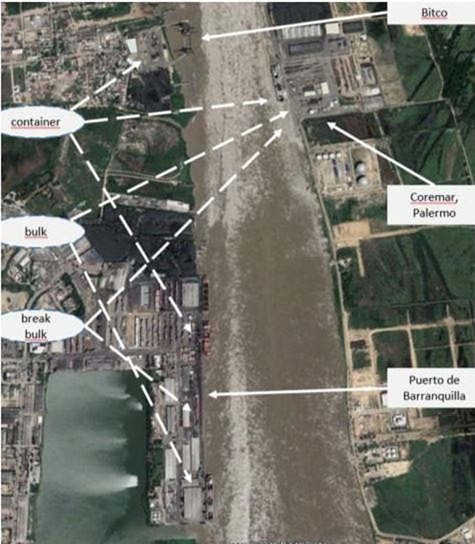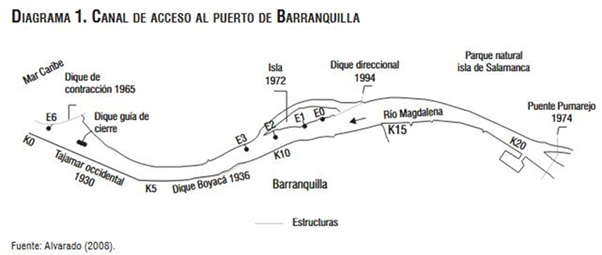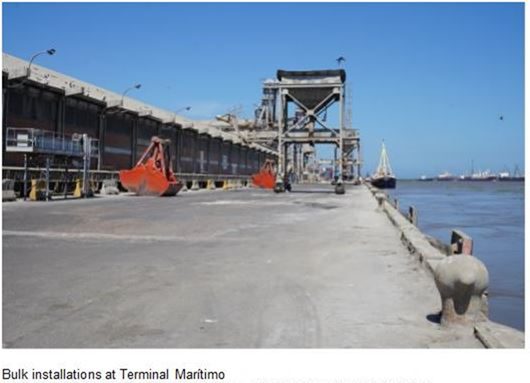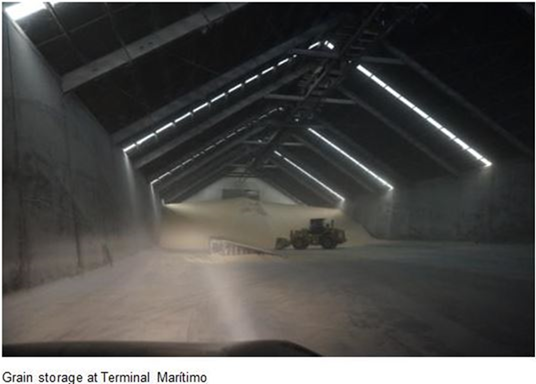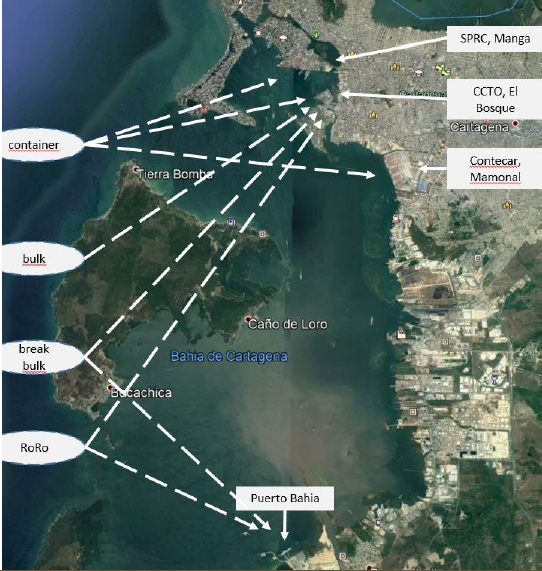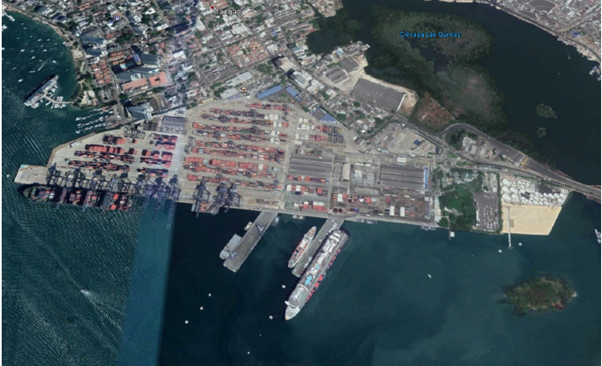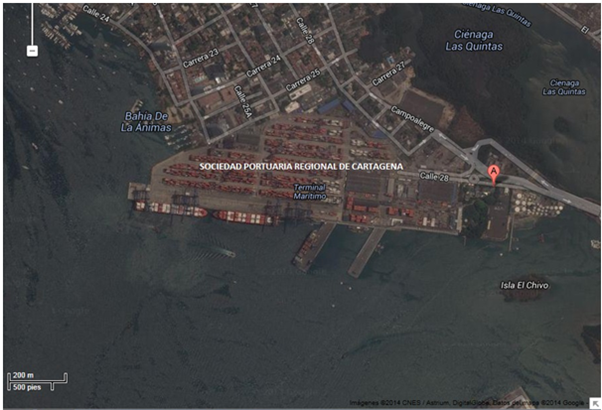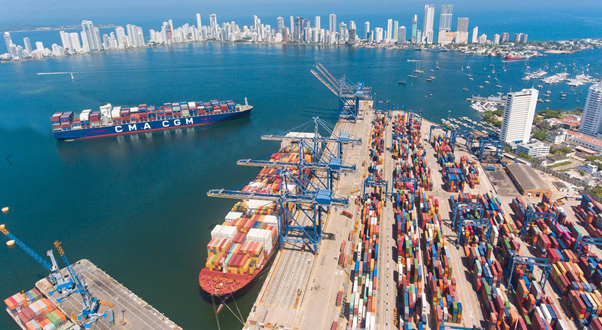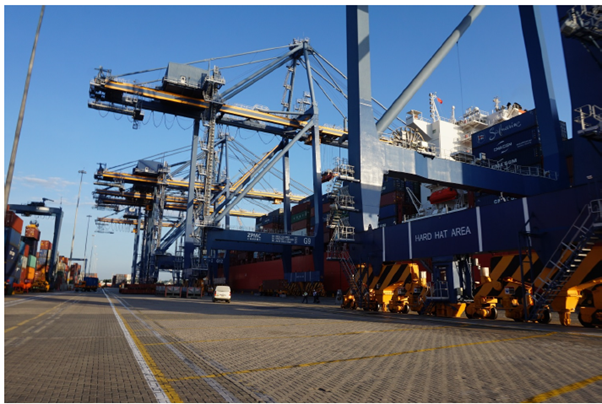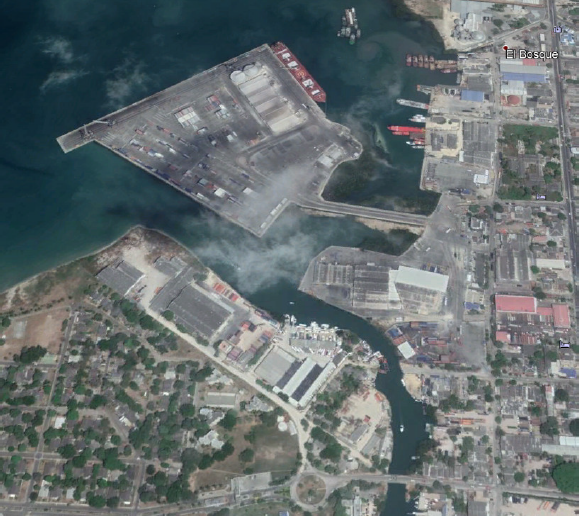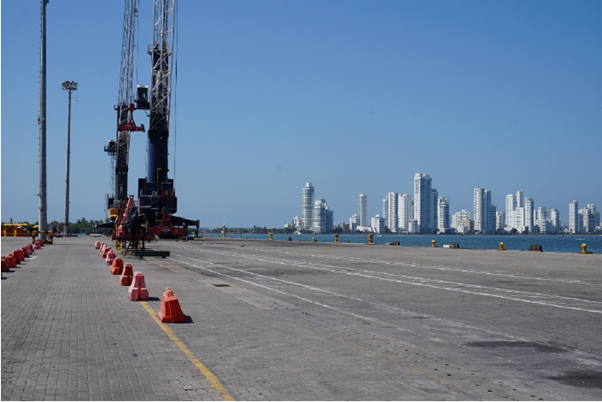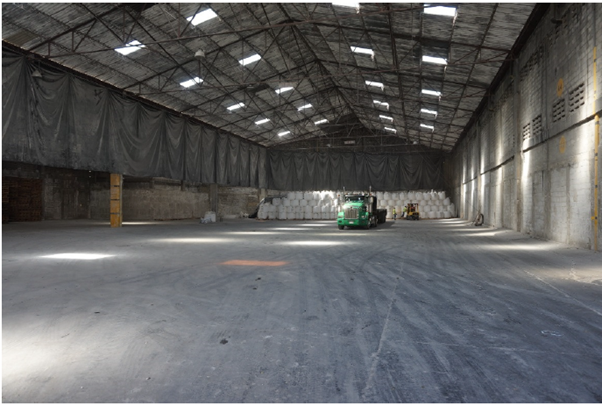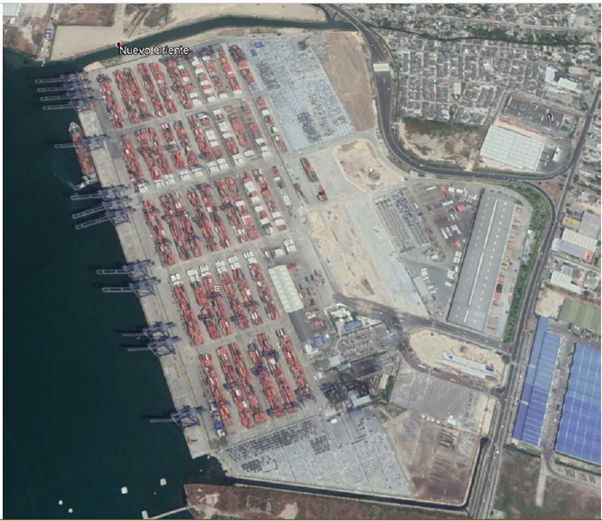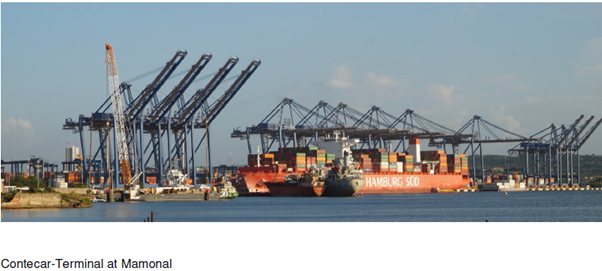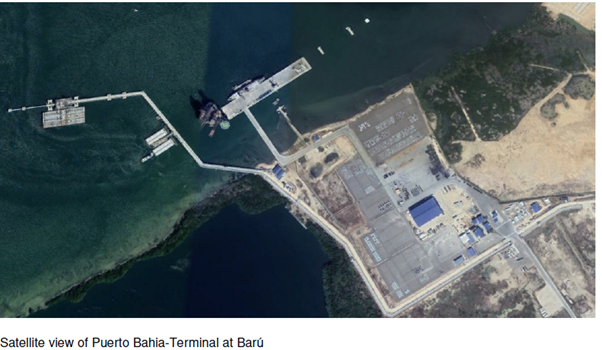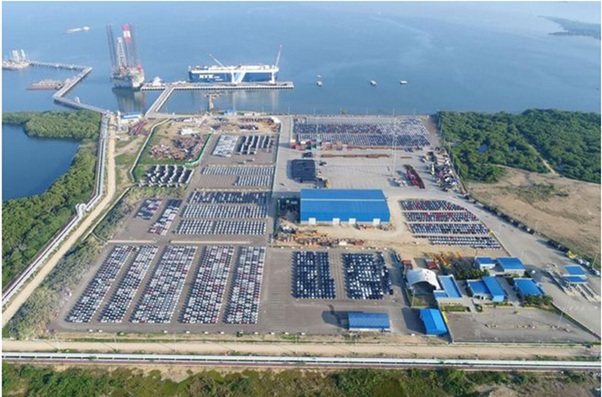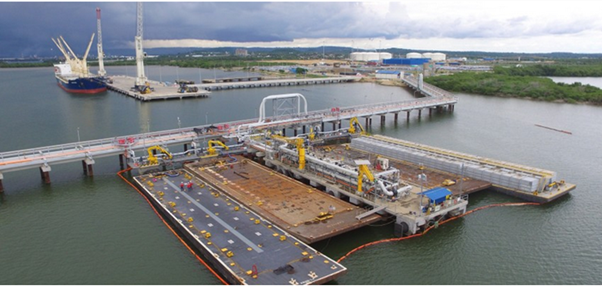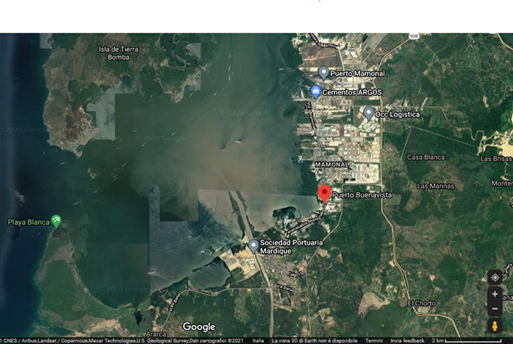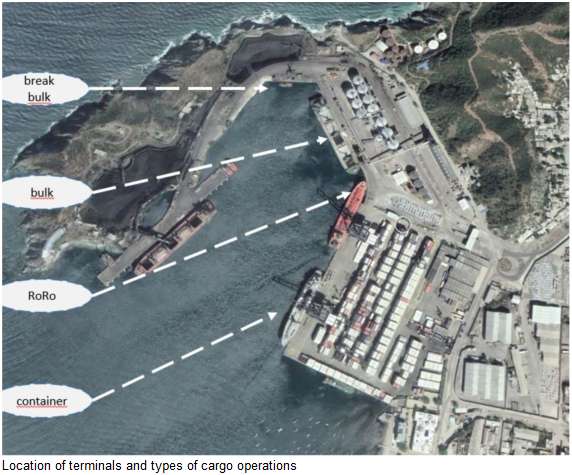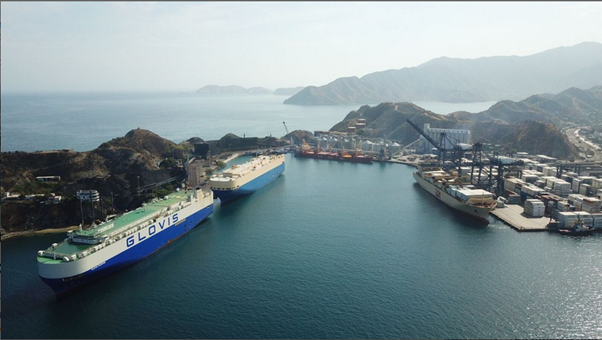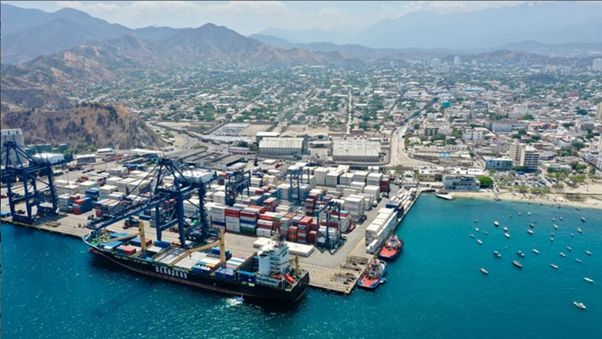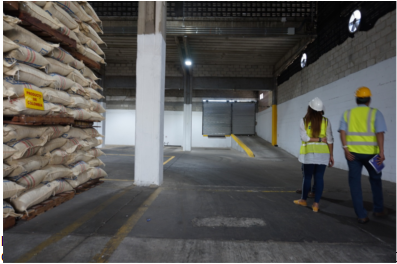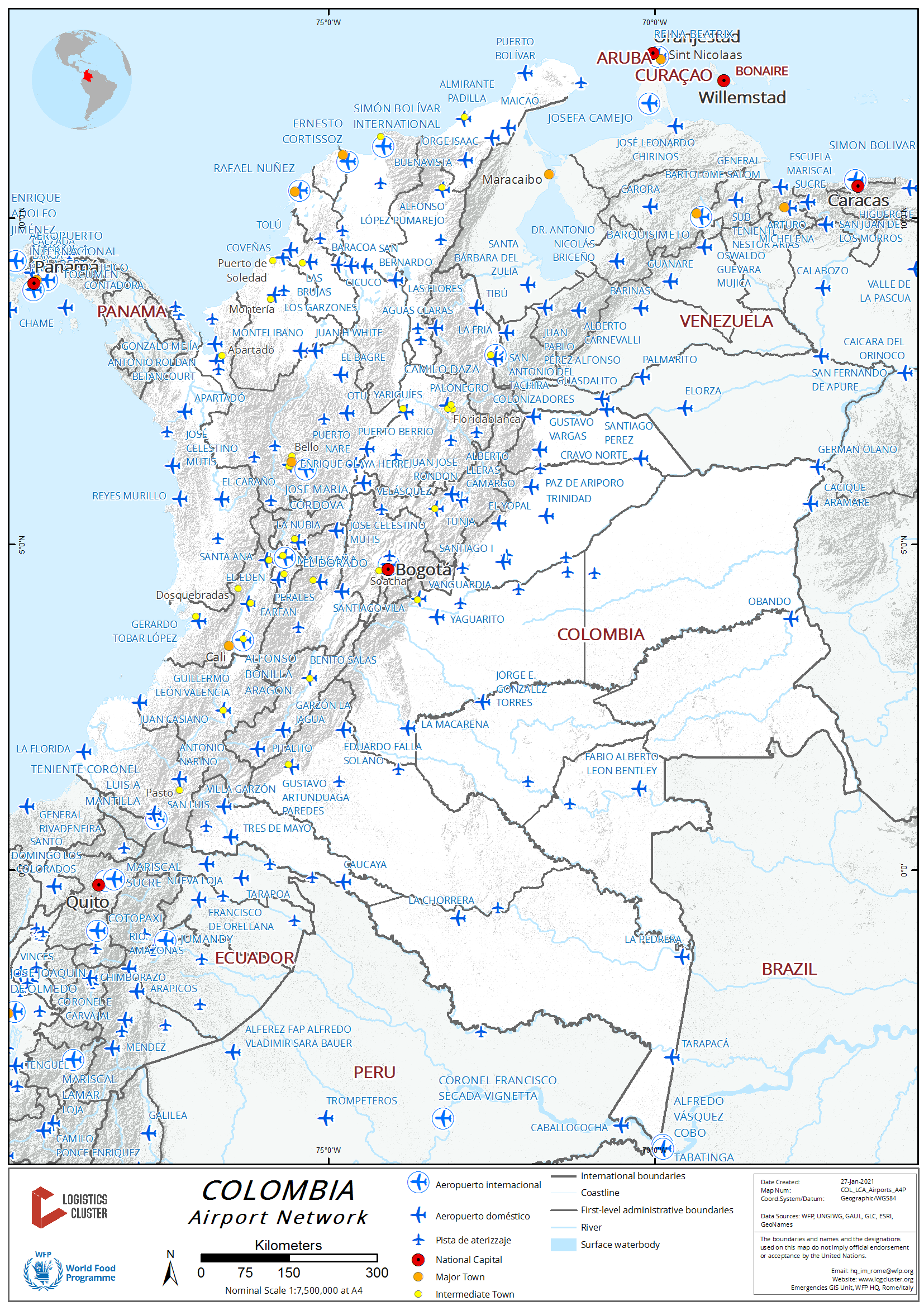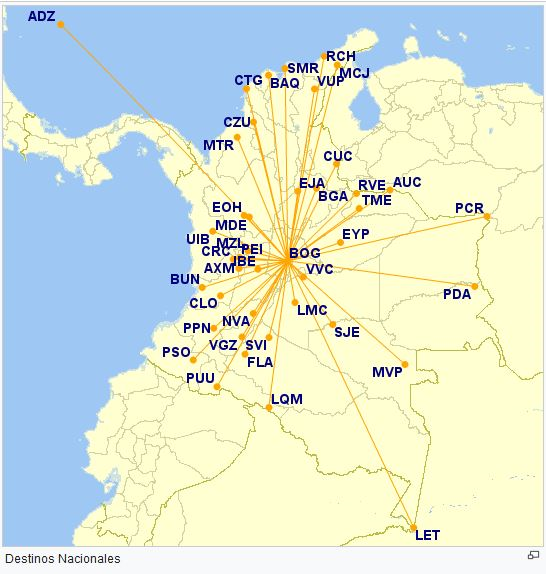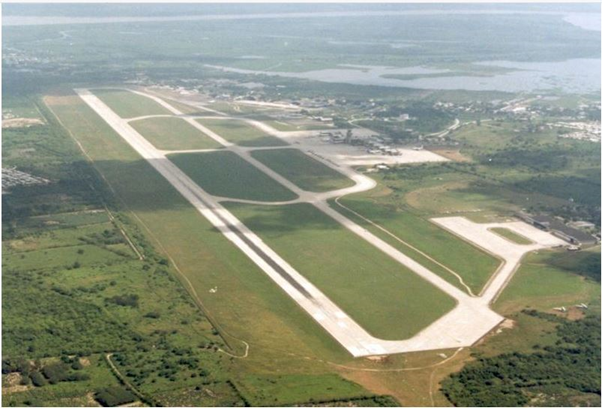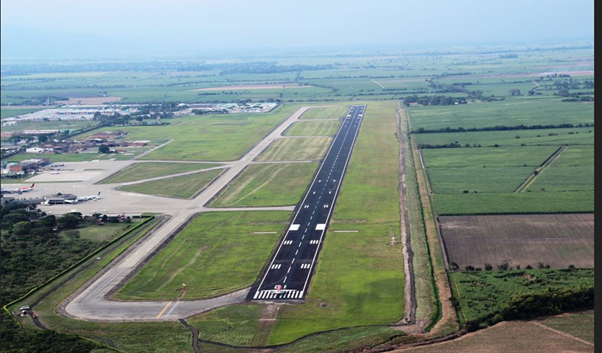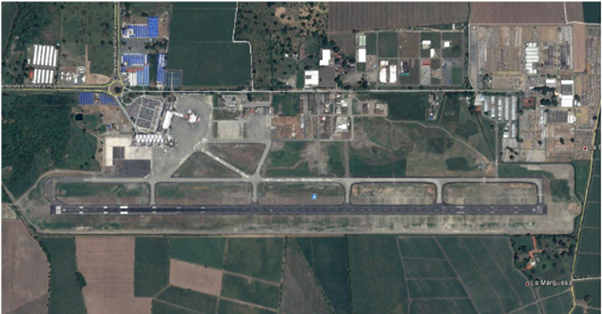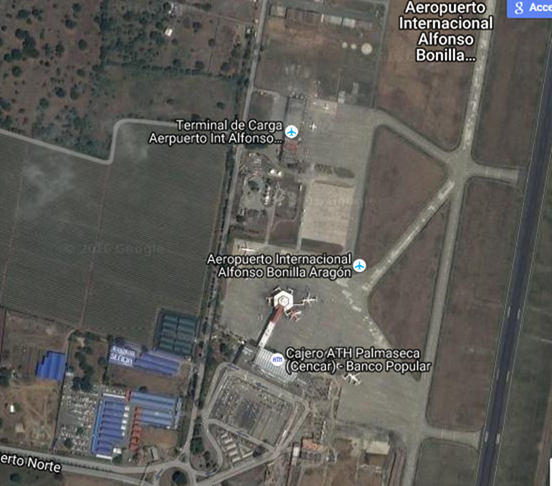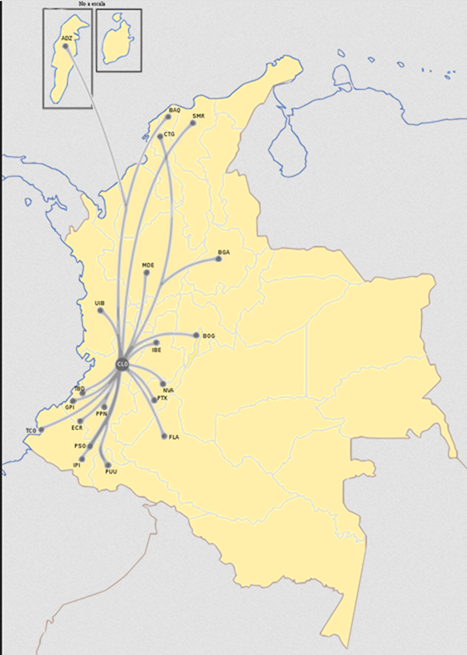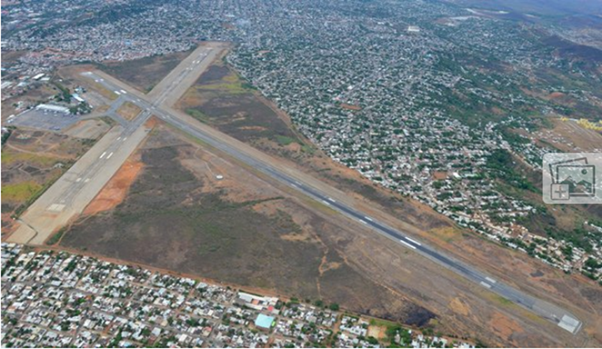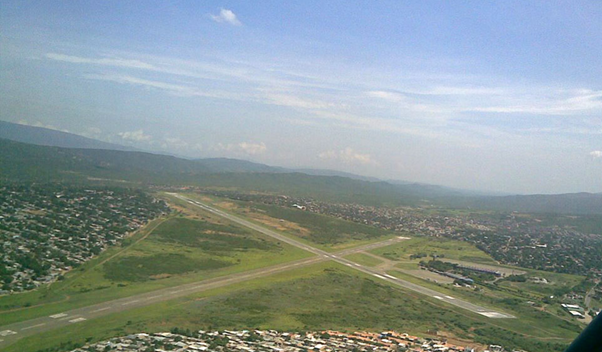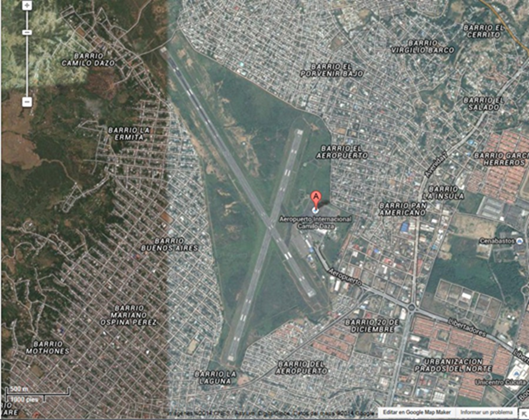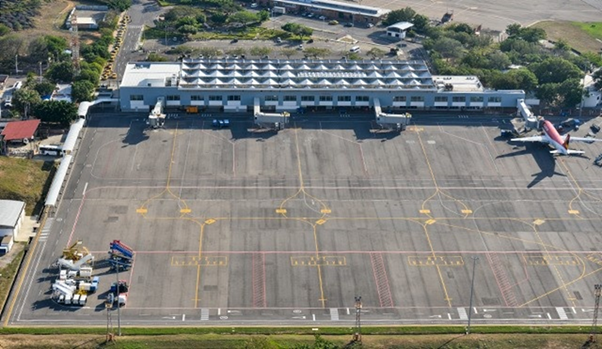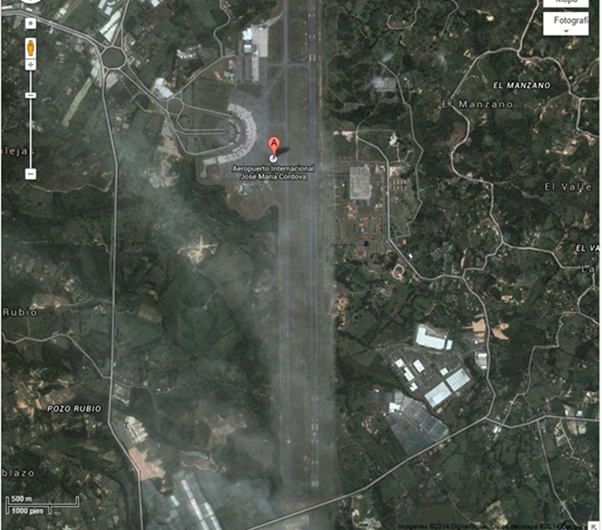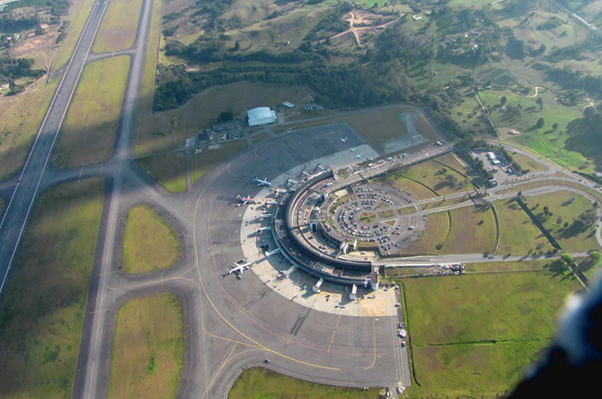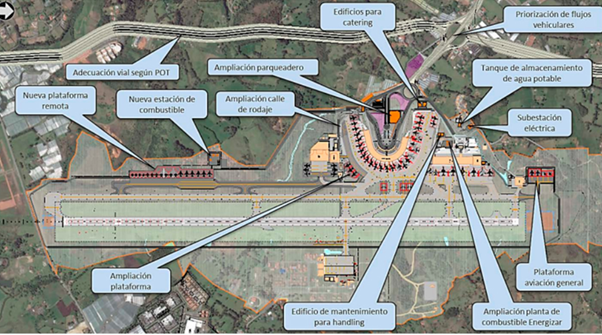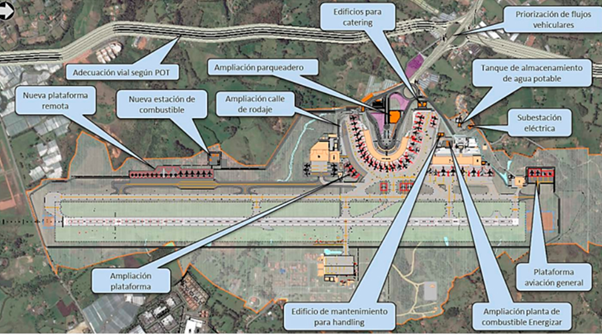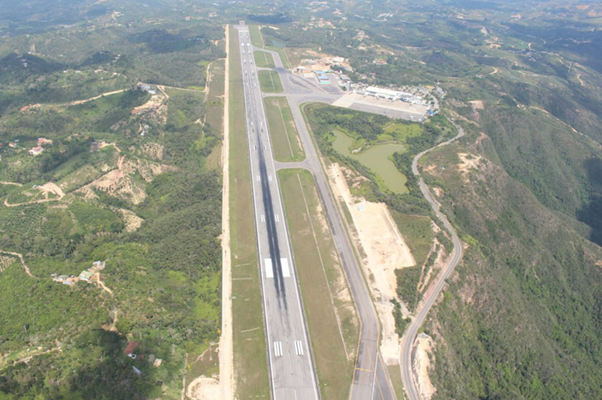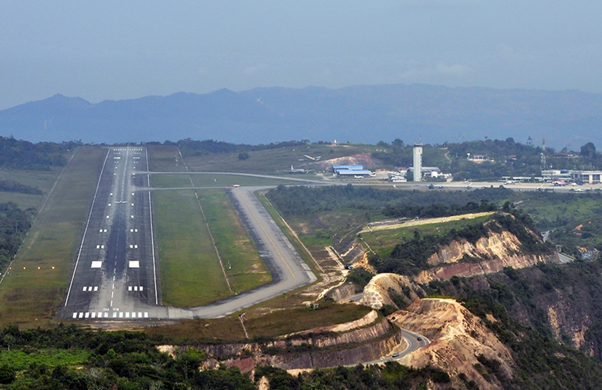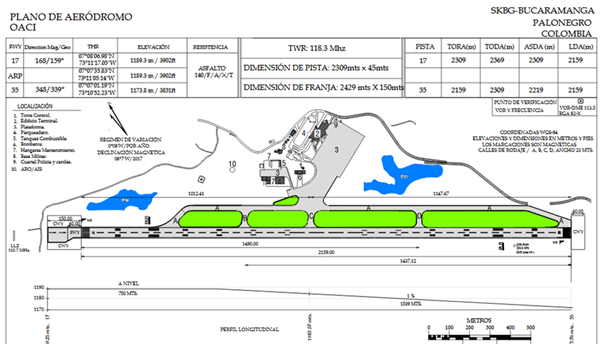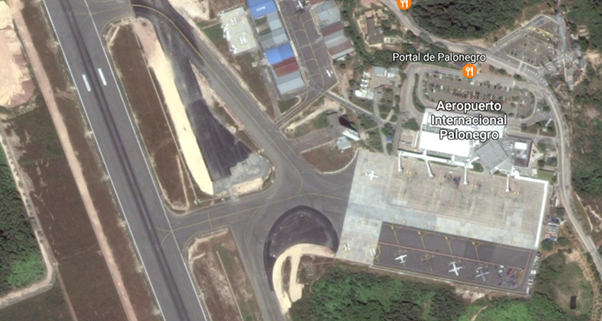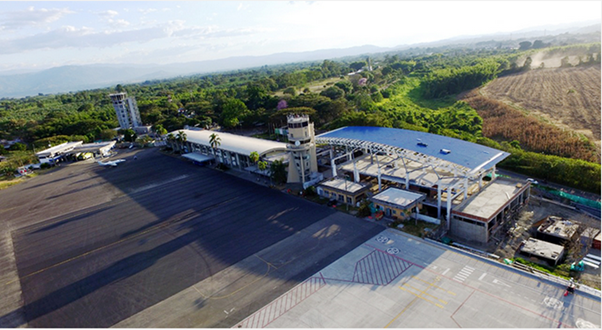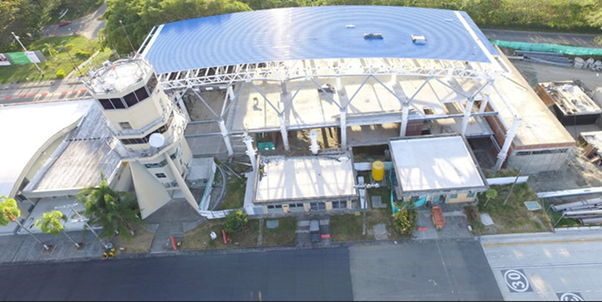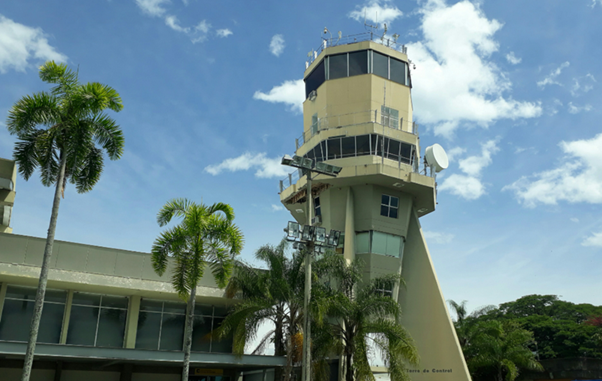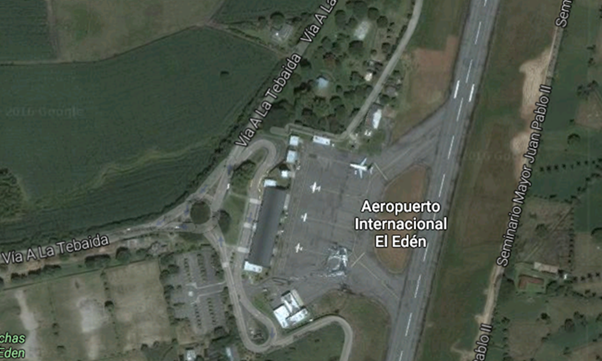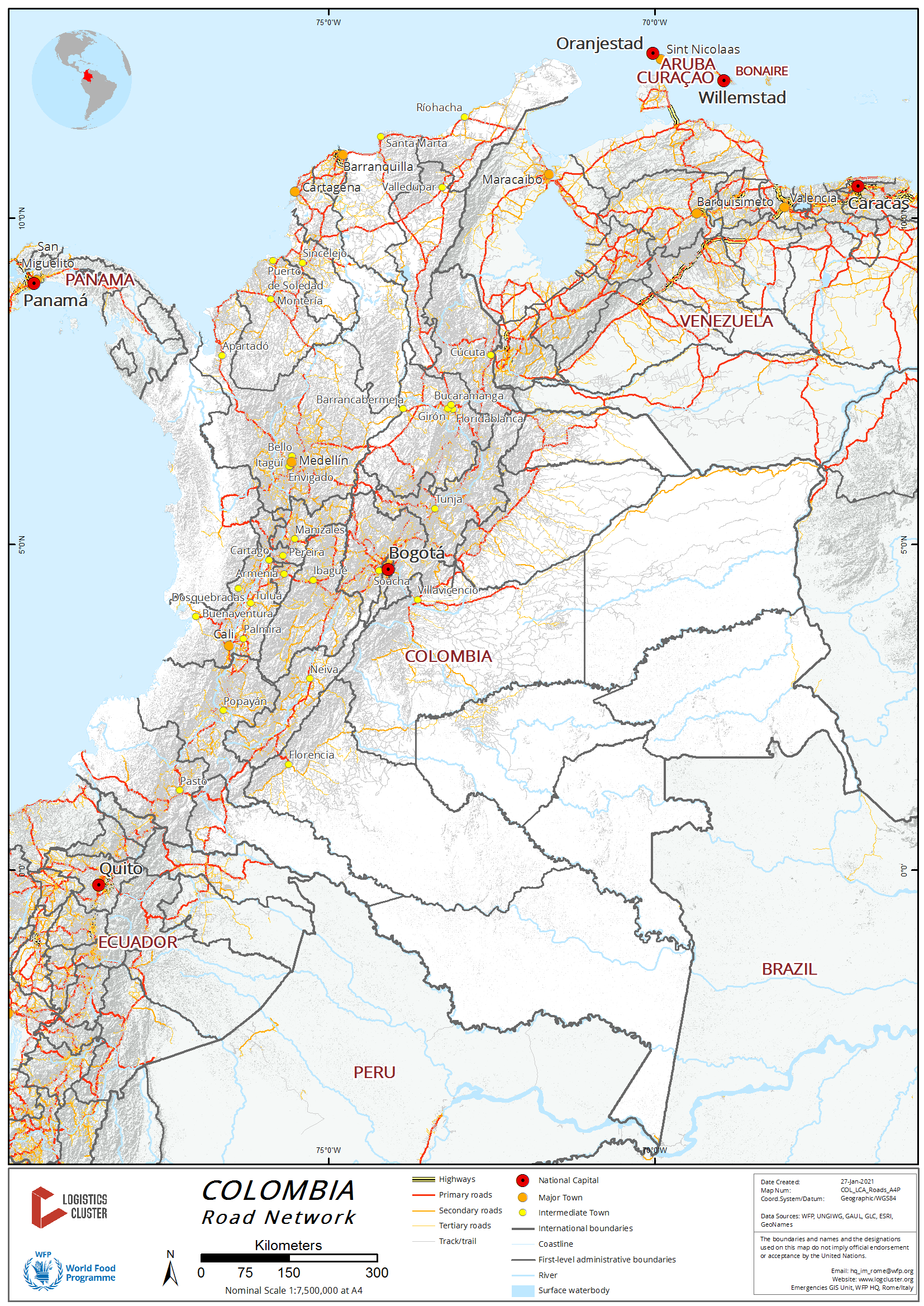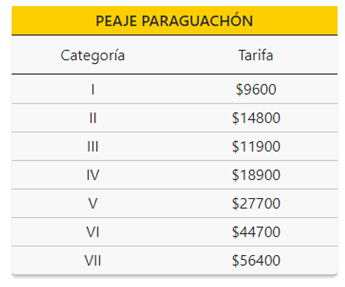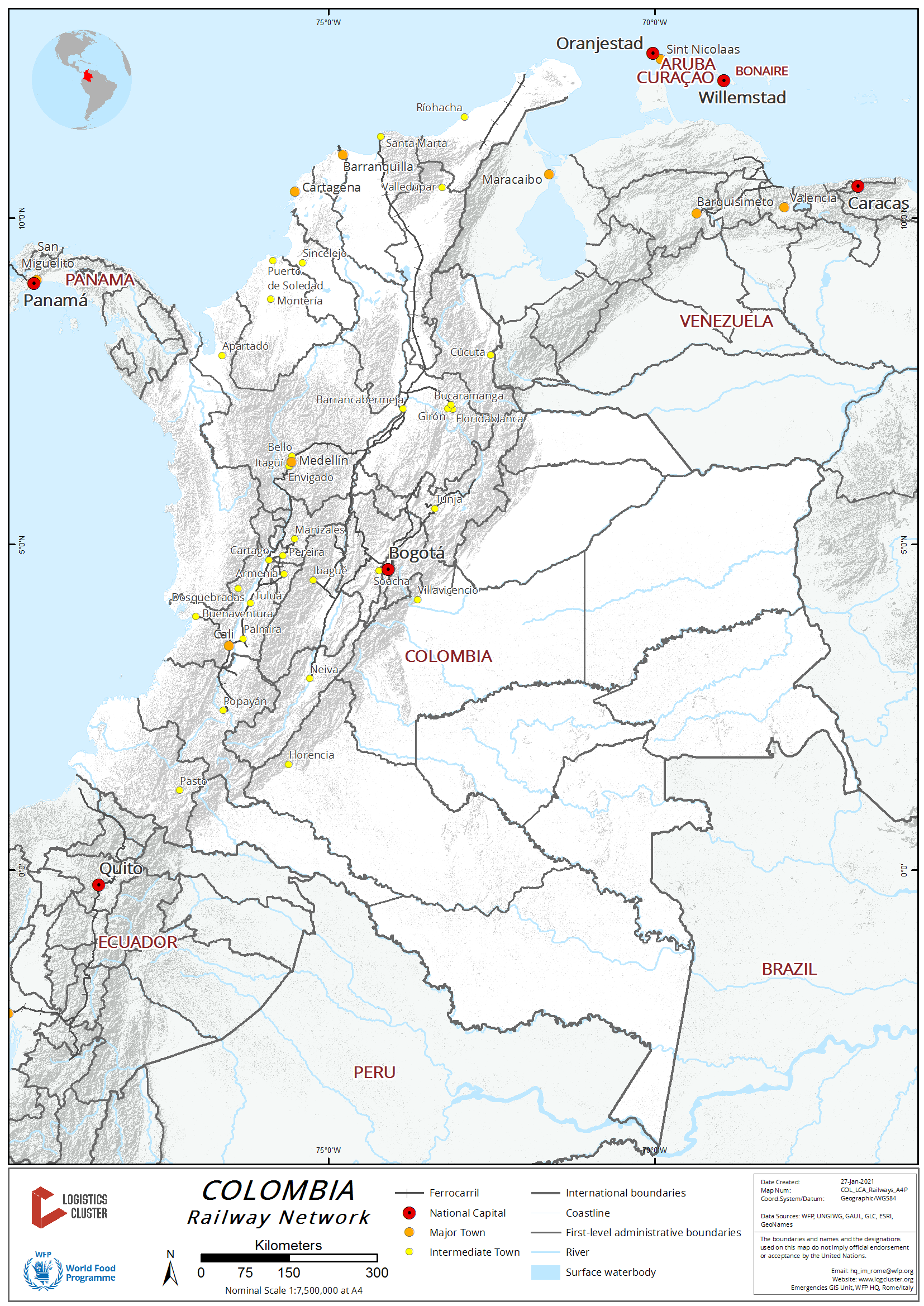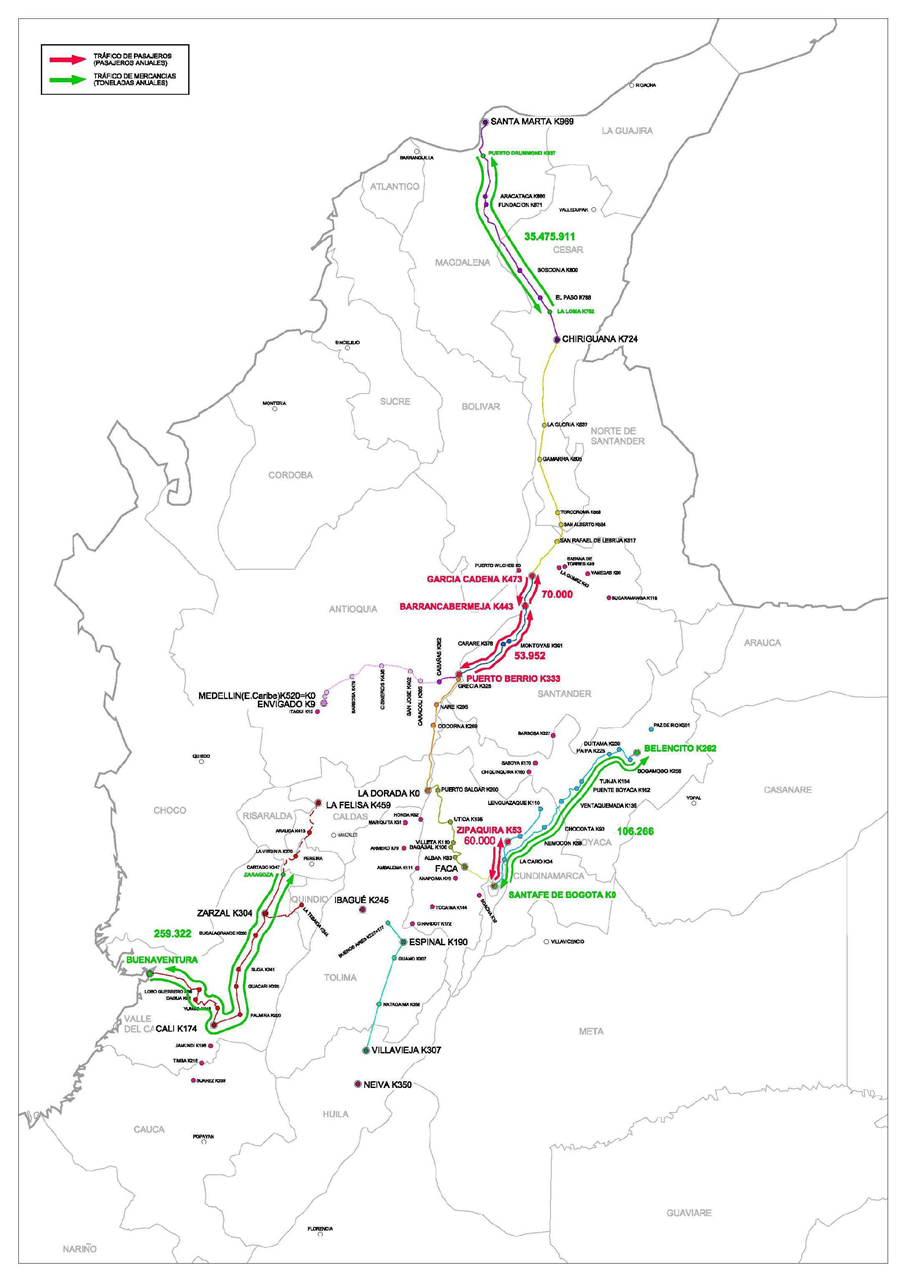2 Colombia Logistics Infrastructure
Colombia ranks 57th in global competitiveness among 141 WEF countries.
Logistics performance has improved in recent years, as indicated by the most recent data from the World Bank's Logistics Performance Index (LPI)*. In 2018, as the study shows, Colombia rose 36 positions in this matter, going from 94 to 58, among 160 nations.
Colombia, however, can improve its competitiveness by optimizing the times and costs of mobilizing products, from the supply phase to their arrival at the final consumer. One of the ways is through multimodal transport facilitating the movement of goods in a fluid way, efficiently using the shipping, air or land transport infrastructure, such as rail, barge trucks and other logistics assets.
The logistics operators sector is characterized by a series of factors such as the strong trend towards globalization, the demand for the provision of new and better services, the consolidation of alliances, mergers and acquisitions between organizations, the need to have better levels of service to customers and the search to reduce logistics costs, among other elements.
Regarding port infrastructure, Colombia has 9 port areas; 7 of them on the Caribbean coast and 2 on the Pacific coast with a fundamental role in foreign trade. Currently, more than 90% of the country's exports and imports are made through this route. The main ports located in Barranquilla, Cartagena, Santa Marta and Buenaventura have adequate facilities and equipment to handle large ships and to handle different types of cargo (Containers, Bulk, General Cargo). Likewise, these ports have adequate storage facilities.
In reference to river transport, Colombia has 4 navigable basins: Magdalena, Meta, Amazonas and Atrato with 29,498 navigable km. Of those kilometers, 38% can be used by ships of more than 25 tons of capacity and the remaining 62% by ships of less than 25 tons of capacity. Unfortunately, the river transport modality has a very low use; it represents only 1.23% of the internal movement of cargo.
The national road network presents significant delays due to the very low investment in this area. The following can be verified: only 8.5% of the road network (204,855 km) belongs to the primary network, while 22% and 69.5% belongs to the secondary and tertiary network, respectively. The main corridors are: "Magdalena Medio Corridor" that connects the Caribbean Coast with the central region of the country (Bogotá capital and surroundings); "Corredor del Llano" that connects Bogotá with the eastern area ("Llanos Orientales"); "West Corridor" that connects the downtown area with the port of Buenaventura, and finally the "Pan American Corridor" that connects the southwest region (including the city of Cali) with the border with Ecuador.
The railway line is made up of 3,338 km, of which 1,725 km (52%) are out of operation due to damage, invasions or illegal occupations. The remaining 1,613 km have been given by the government to different private concessions for operation and maintenance. However, 1,203 km (36% of the total railway line) are only used for cargo transportation.
Finally, the country has 54 airports, of which 14 serve international operations. For the period 2015-2018, investments of 2.3 billion pesos are foreseen, for the modernization represented in the expansion of the facilities, additional landing strips and aeronautical devices due to the increase in the movement of passengers and cargo.
* https://lpi.worldbank.org/international/aggregated-ranking
2.1 Colombia Port Assessment
Colombia has four major ports, of which Barranquilla, Cartagena and Santa Marta are located on the Atlantic coast and Buenaventura at the Pacific. Atlantic coast ports connect the country with Central America, North America and Europe while Buenaventura serves the trade with the west coasts of the Americas and Asia. Cartagena qualifies as a transshipment hub for containers. The entrance channels to Barranquilla and Buenaventura are subjected to sedimentation, restrictions to vessels’ draft might apply.
Additionally, to the major terminals both Colombian coasts feature a large number of private jetties and small port facilities for (mostly) local trade, e.g.: Puerto Zuniga, Puerto Prodeco, Pozos Colorados, Puerto Bolivar, Cienaga, Turbo, Pindo, Tumaco, San Andres Island and Tolu.
2.1.1 Colombia Port of Buenaventura
Port Overview
Buenaventura offers one multi-purpose terminal including a container terminal - Sociedad Portuaria Buenaventura (SPB) – a bulk and a container terminal located to the north (Aguadulce) of SPB and a container terminal east (TCBUEN) of SPB. The entrance channel faces constant sedimentation – different values were given for the draught restriction. Something like 9 m at low tide seems likely, a tidal range of approx. 4 m would permit vessels entering with up to 13 m draught at high tide. Prior to chartering a vessel present conditions must be verified with the pilots. Pilotage is compulsory for all ships of more than 200 tons and available on a 24-hour basis.
The pilot will board the vessel one mile from shore sea buoy #1; Approx. Duration of whole maneuver: 2 hours. The access channel to all three terminals has a length of 31.5 kilometers, equivalent to 17 nautical miles. It is recommended to take special care in navigation during transit of the inner bay, since it is common to find large trunks in the canal, which may hinder maneuvers. During the rainy season the visibility decreases, so is important to take a special care because there is a high traffic of fishermen.
Buenaventura handles the largest cargo volume of all Colombian ports. Most of the port services areprovided by private companies.
As road access might be an issue: Cargo movements through the Aguadulce terminal do not have to traverse the town of Buenaventura.
Port website: http://www.sprbun.com/
Key port information can also be found at: http://www.maritime-database.com/port.php?pid=3603
|
Port Location and Contact |
|
|---|---|
|
Country |
Colombia |
|
Province or District |
Valle del Cauca |
|
Nearest Town or City with Distance from Port |
Buenaventura (0 km) |
|
Port's Complete Name |
Sociedad Portuaria Regional De Buenaventura S.A. |
|
Latitude |
3.892923 |
|
Longitude |
-77.067902 |
|
Managing Company or Port Authority |
Sociedad Portuaria Regional De Buenaventura S.A. |
|
Management Contact Person |
Juan Pablo Cepeda (Manager) |
|
Nearest Airport and Airlines with Frequent International Arrivals/Departures |
Alfonso Bonilla Aragón International Airport in Cali. American Airlines, TAME, KLM & United Airlines. |
Port Picture
Description and Contacts of Key Companies
The following passages refer to Buenaventura’s multi-purpose terminal operated by Sociedad Portuaria Buenaventura (SPB).
In the SPB a container terminal, with a docking line of 1,050 m; equipped with six (6) gantry cranes, one terminal with reach stakers on post-Panamax ship to shore rails and three (3) multipurpose mobile cranes, with forklifts of different capacities for container movement with a 525 m berthing line; 2 multipurpose terminals, one with a 204 m berthing line equipped with 3 mobile cranes with the capacity to move up to 104 tons, and another multipurpose, for the handling of solid bulk (coal), liquid bulk and general cargo with a berthing line 190 m.
The two terminals Aguadulce (container, bulk) and TCBUEN (container) are described at the end of this chapter.
COMPAS: Grupo Argos and Southern Port Holding Corp. created on December 1, 2012 COMPAS S.A., the only network of multipurpose public ports in Colombia. With two port terminals in Cartagena, one in Buenaventura, one in Barranquilla, one in Tolú and two in Panama and Houston U.S.A. This terminal has a public operation, is located on the Island of Cascajal and has the possibility of accessing the Pacific railway corridor. It has the most efficient transfer machining system in the country, with 37,676 square meters of concession area, a draft of 10.5 meters of BW and a storage capacity of 47,200 tons. It specializes in the mobilization, efficient storage and dispatch of bulk solids, grains and by-products, while preserving their quality.
ALMAGRARIO: port operator with experience and track record for handling all types of cargo, bulk or general cargo. It is qualified as the port's primary operator, with a storage capacity of 32,000 tons in each silos plant. The unloading is done through suction, spoon and / or hopper methods. The port has 4 bulk docks, 48 silos and 28 mezzanines, a MIAG suction tower with two pumps, with a capacity of 200 tons / hour. It has two 80 ton truck scales each and two electronic step scales.
OPERCAR: Authorized port and logistics operator for cargo handling in the public and private ports of Barranquilla, Cartagena, Santa Marta and Buenaventura. It has a diversified portfolio of services for the handling of general cargo, iron products andsteel, containers, solid bulk, project cargo, rolling cargo, among others. Specialists in the management of oil and gas pipelines, including the supply of lifting equipment, specialized hooks (shoes), inspection tables and lumber for storage.
For more information please see this link: 4.4 Colombia Port and Waterways Company Contact List.
Port Performance
The main port of Buenaventura handles containers, bulk and general cargo on 14 berths - of which 12 are operated by Sociedad Portuaria Buenaventura (SPB) and 2 under concession (COMPAS). SPB’s dock has a length of 2,000 meters. The port shares its location with the city center on an island – connected to the mainland by one bridge (Puente el Piñal, 3 lanes in each direction) only.
The Port has a regulation for humanitarian aid where humanitarian cargo will have priority in the event of a declared national emergency.
|
Seasonal Constraints |
||
|---|---|---|
|
Occurs |
Time Frame |
|
|
Rainy Season |
Yes |
April to May; October to November, although this can vary considerably. |
|
Major Import Campaigns |
No |
Increased volumes of consumer goods during October and November. |
|
Other Comments |
N/A |
|
|
Handling Figures for 2019 |
|
|---|---|
|
Vessel Calls |
1,458 |
|
Container Traffic (TEUs) |
1’200,000 TEUs |
|
Handling Figures Bulk and Break Bulk for 2019 |
|
|---|---|
|
Bulk (MT) |
1,624,639 |
|
Break bulk (MT) |
4,370,861 |
Discharge Rates and Terminal Handling Charges
www.sprbun.com/web/portal/tarifas/Servicios Portuarios
www.sprbun.com/web/portal/tarifas/Servicios Logísticos
Berthing Specifications
|
Type of Berth |
Quantity |
Length (m) |
Maximum Draft (m) |
|---|---|---|---|
|
Conventional Berth |
2 |
204 m and 190 m |
9.14 |
|
Container Berth |
9.14 |
Total 1050 m |
9.44 |
|
Silo Berth |
3 |
Total 525 m |
7.62 |
|
Berthing Tugs |
Yes |
||
|
Water Barges |
Yes |
(Berths N°2 a N°8 for containers, N°10 a N°12 bulk, N°9 multicargo, N°14 liquid cargo , N°13 Under concession for Grupo Portuario S.A. y N°1 operated by Compass S.A.)
For further information on berths, please see the following link: http://www.sprbun.com/documentos/ventanas_de_atraque_en.pdf
General Cargo Handling Berths
|
Cargo Type |
Berth Identification |
|---|---|
|
Imports - Bagged Cargo |
9 to 12 |
|
Exports - Bagged Cargo |
9 to 12 |
|
Imports and Exports - RoRo |
9 to 12 |
|
Other Imports |
Cntrnrs 2 to 8 |
Port Handling Equipment
The private company or concessionaire manages the port concession granted by the government. The services offered are piloting, tugs, fuel, lubricants, supply of provisions, berthing. Boat services: repair of mechanical, electrical, hydraulic and cooling systems; Cargo handling (loading and unloading of ships), medical, dental and immigration services for ship crews, storage tanks, monitoring and control of containers for transshipment; consolidation and deconsolidation of LCL containers, solid waste and wastewater treatment, steel, containers, solid bulk, project cargo, rolling cargo, among others. Specialists in the management of oil and gas pipelines, including the supply of lifting equipment, specialized hooks (shoes), inspection tables and lumber for storage.
|
Equipment |
Available |
Total Quantity and Capacity Available |
Comments on Current Condition and Actual Usage |
|---|---|---|---|
|
Dockside Crane |
Yes |
2 (50 MT) and 2 (60 MT) |
Actual usage |
|
Container Gantries |
Yes |
13 (40 to 62 MT) |
3 Neo-Panamax and 10 Panamax, rail mounted |
|
Mobile Cranes |
Yes |
3 (100 & 104 MT) |
Multipurpose mobile cranes |
|
Reachstacker |
Yes |
16 (40 & 30 MT) |
Actual usage |
|
RoRo Tugmaster (with Trailer) |
No |
N/A |
N/A |
|
Grain Elevator with Bagging Machines |
Yes |
4 (1 for 700 MT / hour, 2 for 300 MT / hour and 1 for 220 MT / hour) |
Grain suction |
|
Transtainer |
Yes |
22 (60 MT) |
Rubber tire Gantry Cranes for yard handling |
|
Forklifts |
Yes |
10 |
Forklifts with different capacities for containers handling |
Container Facilities
Berths 2 to 8 (Containers) Berth Line: 1050 meters length; Equipped with 13 Gantry cranes (STS), 3 of those Post Panamax and 3 multipurpose mobile cranes, 22 transtainer (RTG), reachstacker and forklifts with different capacities for containers handling. SPB has a specialized container terminal (Buenaventura SA - TECSA). The Post Panamax STS can move 35 Containers / Hour. According to SPB the container terminal was working at approx. 60 % of its capacity in 2018.
SPB container operations
|
Facilities |
20 ft / 40 ft |
|---|---|
|
Container Facilities Available |
440 meters long quay, allows berthing for 2 large vessels simultaneously or 1 Panamax vessel, 14 meters depth at low tide. Attend up to 260,000 TEUS per year. |
|
Container Freight Station (CFS) |
Weighing system (with dynamic scales), Load / unloads (Updated technology for full and for empty containers) Storage (safe areas), cargo inspection and cargo movement, operations on line (conditions and status of cargo). 19 hectares for storage with a capacity to store up to 8,000 TEUS (in 2018 a figure of 26,800 TEU was given by SPB) simultaneously. Capacity 768 TEUS, Sortie Container service. |
|
Refrigerated Container Stations |
Monitoring technical conditions, connection and disconnection of reefer containers to the electrical net, power supply (Electrical voltage is handled for the different types of containers) |
|
Other Capacity Details |
N/A |
|
Daily Take Off Capacity |
347 |
|
Number of Reefer Stations |
384 |
|
Emergency Take-off Capacity |
N/A |
|
Off take Capacity of Gang Shift |
N/A |
Customs Guidance
DIAN is the main government customs entity in Colombia, when an import or export exceeds USD 1,000, use of a customs broker for this process is recommended.
Customs regulations per decree 2685 and Muisca regulations stipulate that:
- All cargo on board a vessel, with destination Colombia must be manifested.
- The manifest and bills of lading have to be registered to Customs systems (Muisca) 12 hours prior to ship's arrival.
- Cargo not covered by manifest may not be discharged. If discharged it will be immediately confiscated by Customs.
The processing by Customs may take 1-3 days maximum, depending on the level of inspection. In Colombia the customs authorities is the most influential institution in the process of nationalization, dustoms procedures can be affected by delays or technical problems by the DIAN system when making records, or documentary procedures unrealized by the importer / exporter. It is recommended to do constant cargo tracking and obey the instructions of the officials, as long as they are legal and fair.
DIAN have a special type of import procedure for emergencies, under this mode delivery to the end user may do without any prior processing.
For more information on Customs in Colombia, please refer to: 1.3 Colombia Customs Information.
Terminal Information
Multipurpose Terminal
Berth 9: (Multipurpose) Berthing line of 204 meters, Equipped with three multi-purpose mobile cranes with a capacity to handle 104 tons.
Berth14: Berthing line: 190 meters. Multipurpose terminal for handling bulk solids (Carbon), liquid bulk and general cargo, for handling coal stacking area is 4,500 m2 and 16,800 tons of weight.
The liquid bulk area is equipped with 14 independent and segregated lines for simultaneous pumping, with a modern fire extinguishing system and crane for handling all types of pipelines.
Grain and Bulk Handling
Grain elevator at SPB
Grain silos at SPB (outside port perimeter)
At berths 10 to 12 bulk cargo is handled by Almagrario. Equipped with mechanical and pneumatic bulk unloaders; Total efficiency: 1,520 tons per hour.
Equipment for bulk solids:
- Electro Hydraulic scoop; Capacity 35 m3, density of bulk material 0,8 Ton / m3, efficiency 450 Ton/hr. Dimensions: Open (Width 5.6 m x Length 4.72 m) Close (Width 4,44 mts x Length 4,72 mts).
- Dual gate hopper of 70m3. Discharging direct onto truck, or transfer to silos and / or storage warehouses at the port.
Main Storage Terminal
Service of provision of covered or open-air, warehousing space to store import, export, domestic or transit cargo within the port's facilities.
OPP Graneles S.A is operating a specialized warehouse for coffee (8,682 m2) and one for sugar (20,835 m2).
- Liquids Bulk Storage capacity: More than 230,000 cubic meters.
- Solids bulk warehousing capacity: More than 172,500 tons capacity in silos warehouses and covered areas.
- 20 Silos – Capacity 75000 MT
- 6 Warehouses – Capacity 50000 MT
- 2 Eco Warehouses – Capacity 5000 MT
Company: Almagrario
- 48 Silos – Capacity 600 MT & 550 MT
- 26 Silos – Capacity 39000 MT
|
Storage Type |
Number of Storage Facilities |
Area (m2) |
|---|---|---|
|
Bagged Cargo |
1 (Warehouse) 2 (yards) |
Warehouse (5515 m2) Yards (4200 m2) |
|
Refrigerated Cargo |
At the terminal container |
768 TEU's |
|
General Cargo |
10 (Warehouse) and shed |
Warehouse (69947) Shed (30235 m2). |
Stevedoring
Stevedoring operation is made by private companies, classified and regulated by the national government. The ratio and ranking of the operators is performed in accordance to the type of activities and services they provide to the terminals (cargo handling, pilotage, towage, dredging, port storage and other activities).
Hinterland Information
Land transporters arriving at the port of Buenaventura are offered the following services:
- Terrestrial Programming Center - CPT: It is an alternative by means of which a transport company requests the port by electronic means to load containers with imported loads, indicating the estimated date and time. Allows planning and scheduling of resources for trucks to enter the Maritime Terminal without waiting times, confirming the provision of the service also by electronic means.
- Scale service: For weighing loaded and empty trucks.
- Creation of A-check visits: Carried out by the Transport Companies for the entrance of the trucks to the Maritime Terminal.
- Container inspection: This activity is carried out on trucks that move full and empty containers.
- Operational equipment: Front lifts, reach staker and RTG for loading and unloading trucks.
- SISE: Integrated Electronic Security System for truck traceability.
Near the port can be found the free trade zone (Defined area of a country where it enjoys certain tax benefits, such as exemption from payment of import duties or certain taxes or regulation).
Port Security
|
Security |
|
|---|---|
|
ISPS Compliant |
Yes |
|
Current ISPS Level |
Level 1 |
|
Police Boats |
Yes |
|
Fire Engines |
Yes |
Access control system
Implemented to warranty persons entering the Port are fully identified and to hinder unauthorized access. This control is performed by 62 biometric readers, 18 full body and half-body rotating stands, 23 security fences at vehicle access points, all controlled by a server housing detailed data on the port population.
Perimeter Control System
Implemented in order to prevent intruders access through the outside perimeters of the port facilities, the system consists of 4,800 meters of sensor cable controlled by 23 processors that interpret the signals received, and then transmit information to the control center. The center immediately complements intruder detection with the video equipment available in the zone to immediately alert security personnel and make this information available to them.
Closed Circuit TV
The purpose of the system is to monitor and record all Port operations and activities, it has 370 fixed and panning cameras distributed throughout the port and 21 digital recorders to store, security events 24 hours/day. The system includes special equipment for monitoring the internal navigation channel under any visibility condition and includes 75-day average recording time.
Armed security personnel
As a complement to the Integrated Electronic Security System, the Port has a team consisting of 265-armed security guards and 6 patrol units, by land and sea. They are fully equipped with the necessary devices to maintain communication between the different systems and personnel monitoring security.
Terminal Aguadulce
Opposite the bay of Buenaventura the peninsula of Aguadulce features a jetty for dry bulk and container handling. The terminal was not assed in situ. An interesting aspect of Aguadulce is the access road that avoids Buenaventura city and Puente el Piñal.
Container terminal of ICTSI and PSA, Aguadulce Peninsula
Container Terminal
The container terminal is operated by ICTSI and PSA, currently equipped with 4 Post Panamax rail mounted gantry cranes (RMG's) and about 10 rubber-tired gantry cranes (RTG's) for yard movements. Depth along the 1,200 m long jetty is given with 14.5 m (low tide). Satellite imagery shows 9,000 m2 paved container yard and a container freight station.
Dry Bulk Terminal
Bulk operator COMPAS claims (http://www.compas.com.co/en/terminals/aguadulce) offering the capacity of receiving vessels of up to 80,000 tons and a depth of 15 meters at low tide. Apart from mechanized export of coal the terminal counts with a grain elevator, a mobile port crane, 4 vertical silos with a capacity of 6.500 ton each and 2 additional warehouses of 2.300 sqm each. Total storage capacity is given as 25,200 tons.
Container Terminal TCBUEN
Container terminal TCBUEN of APM
The container terminal is operated by APM, equipped with 4 Post Panamax RMGs (rail mounted gantry cranes) and 13 RTGs (rubber-tired gantry cranes for yard movements). Depth along the 440 m long jetty is given with 14 m (low tide) the entrance channel leading to the jetty being dredged to 12.5 m. Satellite imagery shows 112,000 sqm. paved container yard and 5 warehouses. Shipping lines calling TCBUEN include APL, HAPAG-LLOYD, K-LINE, MAERSK, MOL, NYK and SEALAND. The terminal is situated east of Buenaventura city centre, access avoids the possible bottleneck Puente el Piñal.
Commercial aspects
In the national context, the Bay of Buenaventura maintained leadership in the second half of 2019 with a 42% share in the total mobilization of tons with respect to the other ports in the country. Regarding the Buenaventura Regional Port Society, within the port node where it is located, its participation corresponds to 54%.
Containers
SPRBUN continues to lead the participation in container loading in Buenaventura Bay with a mobilization of 170,696 Teus, out of a total of 389,630 Teus mobilized in the Buenaventura port node. The loss of international transshipment cargo is noteworthy, as a result of differential conditions in the depth of the access channel to the Bay of Buenaventura, which came to be managed by the Posorja Terminal in Ecuador.
Information Technology Management
During the second semester of 2019, the Regional Port Society of Buenaventura, through its Information Technology Management, continued the strategic plan for digital transformation through innovative technological solutions, ensuring business continuity, management and security of IT services for its users and clients.
2.1.2 Colombia Port of Barranquilla
Port Overview
The facilities of the Port of Barranquilla are located along the Magdalena River. Most of the docks and piers are private and are not intended for cargo handling by third parties. The multipurpose Maritime Terminal and BITCO container terminal are operated by Sociedad Portuaria Regional de Barranquilla S.A. (SPRB). Both are located approximately 10 nautical miles (18 km) upstream on the west bank of the river. Additionally, a multipurpose terminal operated by COREMAR is located on the opposite coast near the Palermo settlement.
A spout at the mouth of the river reduces the depth to less than 9m, which currently must be constantly dredged to achieve the 11m depth required. Currently, the Panamax ships with 50,000 MT of cargo capacity can transport a maximum of 35,000 MT to reduce draft. Practical piloting and tugging is mandatory for all ships over 200 tons, both available 24 hours. The pilot will board the ship at the pre-established point approximately 3 nautical miles from the mouth of the river (Bocas de Ceniza). Another half mile upstream is the new Pumarejo Bridge (Length 3,237 m Width 38 m.) Inaugurated in December 2019 with this new infrastructure, the height of the ships that can pass underneath is 45 meters.
Port website: http://wwwpuertodebarranquilla.com/
Key port information may also be found at: http://www.maritime-database.com
|
Port Location and Contact |
|
|---|---|
|
Country |
Colombia |
|
Province or District |
Región Caribe, Atlántico |
|
Nearest Town or City with Distance from Port |
Barranquilla, 4 km |
|
Port's Complete Name |
Puerto de Barranquilla Sociedad Portuaria |
|
Latitude |
10.967273 |
|
Longitude |
-74.765456 |
|
Managing Company or Port Authority |
Sociedad Portuaria Regional de Barranquilla S.A. |
|
Management Contact Person |
René Puche Restrepo (Manager) |
|
Nearest Airport and Airlines with Frequent International Arrivals/Departures |
Aeropuerto Internacional Ernesto Cortissoz |
Port Picture
Description and Contacts of Key Companies
The companies operating within the port area are the largest and most active in the supply chain, most of them are private companies due to recent policies of the present administration. For more information on port contacts, please see the following link: 4.4 Port and Waterways Contact List.
Port Performance
The maritime terminal on the west bank is one of the largest multipurpose terminals in all of Colombia, operating a 1,000 m long pier. The containers are handled by mobile cranes in the main terminal and gantry cranes in the affiliated terminal BITCO CONTAINER TERMINAL, 500 m downstream. It has 5 of the 12 warehouses, connected to the automatic grain unloading system, 132,000 MT of storage capacity (plus 77,000 tons outside the port perimeter) for grain, with discharge rates of up to 8,000 tons / day. The Port of Barranquilla handled 1.6 Million tons of grain in 2017. Bagging operations are carried out regularly throughout the berthing area. At the Maritime Terminal, controlled temperature storage is available through a modern 3,200m2 refrigerated warehouse.
|
Seasonal Constraints |
||
|---|---|---|
|
Occurs |
Time Frame |
|
|
Rainy Season |
Yes |
From May to October |
|
Major Import Campaigns |
No |
The high season of trade, considered in the months of October and November, the operators are preparing for Christmas. |
|
Other Comments |
N/A |
|
|
Handling Figures for 2018 |
|
|---|---|
|
Vessel Calls |
737 |
|
Container Traffic (TEUs) |
Aprox. 100,000 TEUS |
For more information please go to: https://www.supertransporte.gov.co/
As historical, the year 2018 can be qualified for the Port of Barranquilla, Sociedad Portuaria, who report a cargo movement of 5,235,881 tons, a figure that it had never reached in its 82 years of operation.
Discharge Rates and Terminal Handling Charges
For information on port rates and charges, please see the following link: http://puertodebarranquilla.com/index.php/tarifas-2/
*Terminal Handling Charges (THC) calculation template by private Shipping Line Hamburg Süd: https://ecom.hamburgsud.com/ecom/es/ecommerce_portal/tariffs_and_surcharges/thc_calc/ep_thc_calculator.xhtml
Berthing Specifications
|
Type of Berth |
Quantity |
Length |
Maximum Draft |
Comments |
|---|---|---|---|---|
|
Conventional Berth |
2 (berths 3 and 4) |
Total 1,058 m. 6 positions |
8.80 m |
According to the operator |
|
Container Berth |
2 (berths 1 and 2) |
Total 1,058 m |
8.80 m |
According to the operator |
|
Silo Berth |
2 (berths 5 and 6) |
Total 1,058 m |
8.80 m |
According to the operator |
|
Berthing Tugs |
2 (berths 1 and 2) |
12.2 m |
According to the operator |
|
|
Water Barges |
2 (berths 2 and 3) |
8.2 m- 11.2 m |
According to the operator |
Additional dock for river operations, 550 m long, depth given 12 feet.
General Cargo Handling Berths
|
Cargo Type |
Berth Identification |
|---|---|
|
Imports - Bagged Cargo |
n/a |
|
Exports - Bagged Cargo |
n/a |
|
Imports and Exports - RoRo |
n/a |
|
Other Imports |
n/a |
Port Handling Equipment
|
Equipment |
Available |
Total Quantity and Capacity Available |
Comments on Current Condition and Actual Usage |
|---|---|---|---|
|
Dockside Crane |
Yes |
2 (100 tons ea.) |
Gottwald |
|
Container Gantries |
Yes |
3 (30 tons) |
Straddle Carriers |
|
Mobile Cranes |
Yes |
2 (124 tons) |
LIEBHERR LHM 420 |
|
Reachstacker |
Yes |
17 (7 a 18 tons) |
n/a |
|
RoRo Tugmaster (with Trailer) |
No |
n/a |
n/a |
|
Grain Elevator with Bagging Machines |
Yes |
1 (280 tons x hour) |
n/a |
|
Transtainer |
No |
n/a |
n/a |
|
Forklifts |
Yes |
n/a |
Service operated by private subcontractors. |
Container Facilities
|
Facilities |
20 ft / 40 ft |
|---|---|
|
Container Facilities Available |
12 hectares of container yard, capacity 6,064 TEUS, 116 inspection areas |
|
Container Freight Station (CFS) |
2,800 m2 |
|
Refrigerated Container Stations |
186 |
|
Other Capacity Details |
n/a |
|
Daily Take Off Capacity |
n/a |
|
Number of Reefer Stations |
186 |
|
Emergency Take-off Capacity |
n/a |
|
Off take Capacity of Gang Shift |
300 |
Customs Guidance
DIAN is the customs authority in Colombia. If the commercial value of an import exceeds USD 1,000.- it is recommended to hire the services of a customs agent for the procedure. The customs procedures, by decree 2685 and MUISCA regulations stipulate that:
- All cargo on board a ship bound for Colombia must be indicated on the cargo manifest.
- Manifests and BLs must be registered with the Customs system (MUISCA), twelve (12) hours prior to the arrival of the ship.
- Any cargo not indicated in the cargo manifest may not be landed. If it were, it would be immediately confiscated by the customs authority.
The customs procedure can take from 1 to 3 days, depending on the level of inspection assigned. In Colombia, the customs authority is the most influential institution in the nationalization process. Customs procedures may be affected by delays or technical problems in the DIAN system, verifying its statistics or verifying documentary procedures omitted by the importer / exporter. It is recommended to constantly monitor the cargo and obey the instructions of the customs officials as long as they are legal and correct.
DIAN foresees special import procedures in case of emergencies. Under this modality the load can be consigned to the final recipient without any process.
For more information on customs in Colombia, please see the following link: https://www.dian.gov.co/
https://muisca.dian.gov.co/WebArancel/DefConsultaEstructuraArancelaria.faces#
Terminal Information
Multipurpose Terminal
General cargo is handled through one (1) mobile port crane and self-supporting boom of the ship, especially at docks 3 and 4.
Grain and Bulk Handling
The grain can be maneuvered through the grain elevator, achieving up to 550 tons / hour, connected to the five (5) sheds or by collection. The unloading capacity using the four (4) spoons (crane) and delivery in truck hopper is up to 8,000 tons / day, as indicated. The terminal has 12 front loaders, 3 backhoe loaders, 12 Shute type equipment and 11 electrohydraulic spoons. In addition, there are six (6) warehouses with a total capacity of 77,000 tons located outside the port perimeter. Almagrario is the largest operator of bulk cargo within the terminal.
Main Storage Terminal
|
Storage Type |
Number of Storage Facilities |
Area (m2) |
|---|---|---|
|
Bagged Cargo |
12 |
Total warehouse area 40,384 m2 (includes 5 warehouses connected to the grain elevator by suction). |
|
Refrigerated Cargo |
1 Cold Warehouse |
3,200 m2 |
|
General Cargo |
4 Warehouses |
18,835 m2 covered, 35,000 m2 open |
Container Terminal BITCO, SPRB
Since October 2018, the BITCO Terminal is operated by SPRB, under the same administrative modality as the Maritime Terminal (http://www.bitco.puertoenlinea.com.co/other/WhoAreWE.xhtml). There are two (2) piers with a total length of 300m, north pier 180m long and indicated depth of 12m, southern pier 120m long with indicated depth of 12.5m. The unloading at the north quay is carried out by means of three (3) gantry cranes. The container yard has 37,000 m2 with a capacity of 2,900 TEU's and a 2,000 m2 warehouse.
Multipurpose Terminal COREMAR, Palermo
The Coremar terminal is operated by Sociedad Portuaria Palermo S.A. Its main activity consists of the movement of general cargo, containers and bulk. The cargo is handled by the ship's self sustained cranes and a mobile port crane.
Discharge Rates and Terminal Handling Charges (THC): http://www.palermosociedadportuaria.com/en/rates.cfm.
Stevedoring
Stowage and stevedoring operations are carried out by private companies, classified and regulated by the state. The ratio and ranking of operators is determined according to the type of activities and services they provide to the terminals (cargo handling, piloting, practical, tug, dredging stored in port and others)
Hinterland Information
Thanks to the Magdalena River, the country's goods can be transported to and from the Barranquilla port to leave or enter the country. The port and surrounding industries provide the majority of employment opportunities in the city. From Barranquilla there is an immediate road connection to the main cities of the country and to the main cities of Venezuela. The city is located in the enclave of the two main trunk roads in the country: the Troncal del Magdalena, which begins in Bogotá and ends in Barranquilla, and the Troncal del Caribe, which begins in Paraguachón (border with Venezuela) and ends in Medellín , a road that passes through the city. Both trunks also connect to Cali and the west of the country through the Troncal de Occidente (also called Vía Panamericana), which ends at the border with Ecuador.
Port Security
A 24-hour surveillance along the entire length of the river between the mouth and the terminal, allows local authorities to provide a better security service to ships in the port, as well as pilot scheduling, when navigating within the navigation channel. and, finally, it also helps to reduce any possible piracy to vessels anchored in the middle of the current. The Port of Barranquilla acquired the first non-intrusive inspection equipment inside a terminal, these high-tech devices consist of a cargo scanner, a pallet and package scanner, and a trace scanner (explosives and chemicals detection device). With the use of scanners, inspection times by supervisory authorities are expected to exceed 24 hours, which takes an average physical inspection of 15 minutes, making the inspection non-intrusive.
|
Security |
|
|---|---|
|
ISPS Compliant |
Yes |
|
Current ISPS Level |
1 |
|
Police Boats |
No |
|
Fire Engines |
No |
2.1.3 Colombia Port of Cartagena
Port Overview
Located in the north-western part of Colombia Bahía de Cartagena is the largest port on the Caribbean coast. It is very close to the major transoceanic routes through the Panama Canal, several container shipping lines use Cartagena as transshipment hub. The port facilities of Cartagena are situated at the shores of a natural bay, sheltered from all directions and surrounded by the city. Minimum depth in the Bocachica entrance channel to the bay is 14.7 m (low tide). Tide range approx. 0.3 m.
Note: Pilotage is compulsory for all ships of more than 200 tons. Pilotage is available on a 24-hour basis. The pilot will board the vessel one (1) mile from Sea Buoy. Distance from pilot station to the port is 9 miles. Maneuvers of large vessels are subject to previous authorization from the harbor master office, the authorization must be requested at least 48 hours in advance.
The three mayor terminals handling cargo in Cartagena are:
Contecar and Manga are container and cruise terminals operated by Grupo Puerto del Cartagena at international operational standards and are equipped to handle Post-Panamax vessels. 3 Mil. TEUs were handled in 2017 by the two terminals – mostly transshipment cargo with a local percentage of only 25% thus creating low gate throughput relatively to terminal activity.
Cartagena Container Terminal Operator CCTO (http://www.ccto.com.co) is the new joint venture between APM Terminals, a world-renowned company in the port industry, and the Colombian-based port and terminal operator, Compañía de Puertos Asociados S.A. (Compas S.A.) www.compas.com.co. CCTO manages and operates Compas S.A.'s existing multipurpose facility. in Cartagena, Colombia, which includes an annual production capacity of 250,000 TEU and 1.5 million tons of general cargo.
Port website: https://www.puertocartagena.com/
http://www.apc.es/webapco/
In the southern part of the bay of Cartagena, a large-scale multipurpose terminal began operating in 2015 - Puerto Bahía https://www.puertobahia.com.co/
Key port information may also be found at: http://www.maritime-database.com
|
Port Location and Contact |
|
|---|---|
|
Country |
Colombia |
|
Province or District |
Bolivar |
|
Nearest Town or City with Distance from Port |
Cartagena (4.8 km) |
|
Port's Complete Name |
Sociedad Portuaria Regional de Cartagena |
|
Latitude |
10.406309 |
|
Longitude |
-75.528388 |
|
Managing Company or Port Authority |
Group Puerto de Cartagena |
|
Management Contact Person |
Alfonso Salas Trujillo (Manager) |
|
Nearest Airport and Airlines with Frequent International Arrivals/Departures |
Aeropuerto Rafael Nuñez Airport - Cartagena Latam, Avianca American Airlines, Air Italy, Jet Blue, Spirits, Can Jet, Air Pullmantur, Finnair, Blue Panorama Airlines, Tame. |
Port Picture
Layout of Cartagena Port
Description and Contacts of Key Companies
Companies inside the port are major contributors in the supply chain, most of them are private. Services provided: container handling, loading and unloading of vessels, pilots’ services, vehicles, customs agency, port operators, support catering vessels, safety and inspection of goods.
Note: Pilotage is compulsory for all ships of more than 200 tons. Pilotage is available on a 24-hour basis. The pilot will board the vessel one (1) mile from Sea Buoy. Distance from pilot station to the port is 9 miles.
4.4 Colombia Port and Waterways Company Contact List
Port Performance
Cartagena’s dedicated container terminals are equipped to meet international performance standards. The Port has a regulation for humanitarian aid, in the event of a national emergency declared, humanitarian cargo vessels will have priority in the terminal.
|
Seasonal Constraints |
||
|---|---|---|
|
Occurs |
Time Frame |
|
|
Rainy Season |
Yes |
August to November |
|
Major Import Campaigns |
No |
Increased volumes of consumer goods during October and November. |
|
Other Comments |
n/a |
|
Container Terminal SPRC, Manga
Homepage: https://www.puertocartagena.com/
Located at the north shore of the inner harbour, the SPRC terminal of Sociedad Portuaria Regional Cartagena is closest to the city centre. The main berth is used to handle containers, 2 finger jetties are used for cruise vessels and auxiliary vessels.
Satellite view of SPRC-Terminal at Manga
Satellite view of SPRC-Terminal at Manga
View of Terminal at Manga, Cartagena
Gantries and transtainer at SPRC-Terminal at Manga
The terminal is operated at international operational standards and are equipped to handle Post-Panamax vessels. Containers handled are mostly transshipment cargo with a local percentage of only 25% thus creating low gate throughput relatively to terminal activity. Shipping lines using the terminal to link Pacific and Atlantic trade include Hamburg Süd, Maersk, Hapag Lloyd, CMA-CGM and Cosco. Warehouse spaces are presently rented out or in use; large scale container stripping would likely have to take place outside the terminal.
|
Handling Figures for 2019 |
|
|---|---|
|
Vessel Calls |
1,187 |
|
Container Traffic (TEUs) |
845,938 TEUs |
|
Handling Figures Bulk and Break Bulk for 2019 |
|
|---|---|
|
Bulk (MT) |
- |
|
Break bulk (MT) |
1,446 |
Discharge Rates and Terminal Handling Charges
For information on port rates and charges, please see the following link: https://www.puertocartagena.com/en/cargo-services
Berthing Specifications
|
Type of Berth |
Quantity |
Length (m) |
Maximum Draft (m) |
Comments |
|---|---|---|---|---|
|
Conventional Berth |
4 |
4 x 190 m |
n/a |
According to operator |
|
Container Berth |
1 |
700 m |
15.50 m |
According to operator |
|
Silo Berth |
|
|||
|
Berthing Tugs |
|
|||
|
Water Barges |
|
General Cargo Handling Berths
|
Cargo Type |
Berth Identification |
|---|---|
|
Imports - Bagged Cargo |
|
|
Exports - Bagged Cargo |
|
|
Imports and Exports - RoRo |
|
|
Other Imports |
Port Handling Equipment
|
Equipment |
Available |
Total Quantity and Capacity Available |
Comments on Current Condition and Actual Usage |
|---|---|---|---|
|
Dockside Crane |
No |
- |
- |
|
Container Gantries (STS) |
Yes |
6 |
6 x 21 Rows outreach 20 x 20’ Twin lift Super Post Panamax 42 m underspreader to berth 65 MT under spreader 85 MT under hook |
|
Mobile Cranes |
Yes |
2 |
100 MT at 21 m outreach 23 MT at 50 m outreach |
|
Reachstacker |
Yes |
6 |
5 Full cntnr Reach Stacker 1 Mty cntnr Reach Stacker |
|
RoRo Tugmaster (with Trailer) |
Yes |
89 |
02 x 20’ carry |
|
Transtainer |
Yes |
28 |
6 + 1, single lift |
|
Forklifts |
Yes |
6 |
4 x 3 MT 1 x 7 MT 1 x 12 MT |
Container Facilities
|
Facilities |
20 ft and 40 ft |
|---|---|
|
Container Facilities Available |
Yes, International standards (15 hectares) |
|
Container Freight Station (CFS) |
Yes 10,692 m2 |
|
Refrigerated Container Stations |
One station, cold room, 3 platforms |
|
Yard Capacity Details (Slots 20’) |
28,500 TEUs |
|
Daily Take Off Capacity |
3,542 |
|
Number of Reefer Stations |
1,140 |
|
Emergency Take-off Capacity |
35 moves / hour / gantry |
|
Off take Capacity of Gang Shift |
1,771 |
The terminal is handling container and bulk cargo using mobile cranes and vessel’s gear.
Customs Guidance
DIAN is the main government customs agency in Colombia, when an import or export exceeds USD1000, importer / exporter should use a customs broker for this process. Customs regulations as per decree 2685 and Muisca regulations stipulate that:
- All cargo on board a vessel, with destination Colombia must be manifested.
- The manifest and bills of lading have to be registered to Customs systems - Muisca, 12 hours prior to ship's arrival.
- Cargo not covered by manifest may not be discharged. If discharged it will be immediately confiscated by Customs.
Customs may take 1-3 days maximum in the process, depending on the selectivity of inspection which goods was subjected. In Colombia the customs authorities are the most influential institution in the process of nationalization. Customs procedures can be affected by delays or technical problems by the DIAN system when making records, or documentary procedures unrealized by the importer / exporter. It is recommended to do load tracking every time and obey the instructions of the officials, as long as they are legal and fair.
DIAN have a special type of import procedure for emergencies, under this mode delivery to the end user may do without any prior processing.
For more information on customs in Colombia, please see the following links: https://www.dian.gov.co/andhttps://muisca.dian.gov.co/.
Terminal Information
Multipurpose Terminal
Cartagena Container Terminal Operator (www.ccto.com.co)
On the east coast of the inland port, the terminal of CCTO (Operador de Terminal de Contanedores de Cartagena S.A.S), a joint venture of COMPAS and APM TERMINALS is located on an artificial island. In 2016, APM Terminales, a world-renowned company in the port industry (member of the MAERSK group) and the Colombian-based port and terminal operator, Compañía de Puertos Asociados S.A. (Compas S.A.) formed Cartagena Container Terminal Operator (CCTO). The joint venture manages and operates the multipurpose terminal at the second busiest container port in Colombia.
With a planned investment of US $ 200 million, CCTO has three Ship-to-Shore cranes, increased the draft from 12 to 14.5 meters and has automated its operations for maximum efficiency. This allows the terminal to handle new Panamanian vessels of up to 13,000 TEU capacity, which can now transit through the Panama Canal after its lock expansion project completed in the summer of 2016.
CCTO institutional video: https://www.youtube.com/watch?v=d3OgWgKpEJ4
Satellite view of CCTO-Terminal at el Bosque
Mobile harbour cranes at berth of CCTO-Terminal
Warehouses and silos at CCTO-Terminal
Big bag storage at warehouse of CCTO-Terminal
Grain and Bulk Handling
The terminal handles CONTAINER cargo, FRACTIONAL cargo, PROJECT cargo, BULKS, COKE and VEHICLES, using both: mobile cranes and ship equipment.
Main Storage Terminal
The CCTO – multipurpose terminal offers 65,000 tons silo capacity for grains and 7,000 m2 warehouse space.
|
Storage Type |
Number of Storage Facilities |
Area (m2) |
|---|---|---|
|
Bagged Cargo |
5 warehouses |
7.000 m2 warehouse space (plus 4.000 sqm adjacent to the terminal) |
|
Refrigerated Cargo |
n/a |
110 connection points for reefer containers |
|
General Cargo |
See “bagged cargo” |
See “bagged cargo” |
Other capabilities:
• Dock storage, filling and dewatering, and last mile delivery (estimated savings of up to US $ 150 per container)
• Efficient cargo dispatch process in 12 hours
• Optimized door process with truck turn time of 23 minutes
• Well-connected hinterland serving the automotive and petrochemical industry
Total area: 22 Hectares
Operating capacity: Handling 4 million tons / year
Annual container capacity: 250,000 TEU
Access lanes tracks: 5
Refrigerated Container Connections: 110
Berth length: 660m
Handling Equipment
Mobile harbor cranes: 4 (capacity of 100 tons each)
Reach Stacker: 5
Top Loaders: 5
Access channels
North Channel, with a maximum depth of 12 meters BW. and channel width 80 meters Canal Sur, with a maximum depth of 11.5 meters BW. and channel width of 100 meters.
CONTAINER TERMINAL Contecar, Mamonal
Homepage: http://www.puertocartagena.com
https://www.puertocartagena.com/en/companies-withinorganization/contecar
Located in the north-east part of Cartagena Bay, the Contecar terminal (Terminal de Contenedores de Cartagena) of Sociedad Portuaria Regional Cartagena is handling container and RoRo cargo.
Satellite view of Contecar-Terminal at Mamonal
The terminal is operated at international operational standards and are equipped to handle Post- Panamax vessels. Containers handled are mostly transshipment cargo thus creating low gate through put relatively to terminal activity. Warehouse spaces are presently rented out or in use; large scale container stripping would likely have to take place outside the terminal.
Additional Information:
- CONTECAR It is prepared to receive the largest ships in the world.
- It has the capacity to mobilize 3.2 million TEUs per year.
- It functions as a connection center (hub) for shipping companies and as an International Logistics Distribution Center (CDLI) for multinationals.
- It has the latest technology infrastructure and equipment to offer high-quality services.
- It has infrastructure to mobilize self-rolling cargo (Ro-Ro) and is a specialist in car cargo for the national and regional market.
- Handles project loads: heavy or oversized parts (over gauge)
- It has connectivity to direct routes in global trade networks.
Discharge Rates and Terminal Handling Charges
https://www.puertocartagena.com/en/cargo-services
Berthing Specifications
|
Type of Berth |
Quantity |
Length (m) |
Maximum Draft (m) |
Comments |
|---|---|---|---|---|
|
Conventional Berth |
n/a |
|
||
|
Container Berth |
1 |
970 m |
16.50 m |
According to operator |
|
Silo Berth |
n/a |
|
||
|
Berthing Tugs |
n/a |
|
Container Handling Equipment
|
Equipment |
Available |
Total Quantity and Capacity Available |
Comments on Current Condition and Actual Usage |
|---|---|---|---|
|
Dockside Crane |
No |
- |
- |
|
Container Gantries (STS) |
Yes |
13 |
3 x 17 Rows Outreach 2 x 20’ Twin Lift Panamax 38 m under spreader to berth 65 MT under spreader 70 MT under hook 10 x 23 Rows outreach 2 x 20’ twin lift Panamax 45 m under spreader to berth 65 MT under spreader 80 MT under hook |
|
Mobile Cranes |
Yes |
2 |
100 MT at 21 m outreach 23 MT at 50 m outreach |
|
Reachstacker |
Yes |
12 |
10 Full cntnr Reach Stacker 2 Mty cntnr Reach Stacker |
|
RoRo Tugmaster (with Trailer) |
Yes |
143 |
02 x 20’ carry |
|
Grain Elevator with Bagging Machines |
No |
- |
- |
|
Transtainer |
Yes |
42 |
6 + 1 Single lift |
|
Forklifts |
Yes |
7 |
4 x 3 MT, 1 x 7 MT, 2 x 16 MT |
Container Facilities
|
Facilities |
20 ft and 40 ft |
|---|---|
|
Container Facilities Available |
Yes, International standards. 29 Ha |
|
Container Freight Station (CFS) |
Yes 50,673 m2 |
|
Refrigerated Container Stations |
1 station, cold room, 12 plattforms |
|
Yard Capacity Details (Slots 20’) |
45,000 TEUs |
|
Daily Take Off Capacity |
6,552 |
|
Number of Reefer Stations |
1,512 |
|
Emergency Take-off Capacity |
35 moves / hour / gantry |
|
Off take Capacity of Gang Shift |
3,400 |
Puerto Bahia, Barú Multi-purpose Terminal
Website: www.puertobahia.com.co
The multipurpose terminal Puerto Bahía was inaugurated on August 28, 2015, it is the youngest port in the region. Puerto Bahía, being a new terminal, has always seen a growth in its volumes, equipment and facilities. In 2018, after three years of its inauguration in the bay of Cartagena, the Puerto Bahía multimodal maritime terminal met the objective of covering the deficit in hydrocarbon export and storage capacity in Colombia and managed to mobilize 118 million barrels. Currently the hydrocarbons business mobilizes 85% of total revenues, 10% are vehicles and 5% project cargo (machinery and materials) and others. Added to these figures are accumulated exports of more than 128,000 tons and imports that exceed 195,000 tons in general cargo since 2015.
Puerto Bahía is located on the southern coast of Cartagena Bay and is adjacent to a liquid bulk terminal. Known today as the first mobile cargo terminal in the Caribbean, the port specialized in hydrocarbons will enable an additional 10 hectares to transport merchandise without the need for cranes.
Container storage yard at the Puerto Bahía terminal, Cartagena. Courtesy Puerto Bahía
Multipurpose Terminal
Puerto Bahía has a specific area for the transport of general cargo, specialized in handling extra-heavy, oversized and rolling cargo (Roll On - Roll Off), in addition to having a state-of-the-art logistics system.
In its first phase, this terminal includes a 300-meter dock and 27 hectares of storage yards. Once the Port is completed, this pier will increase its capacity by another 300 meters, thus completing 600 linear meters and 18 meters of natural draft along the pier line.
General Cargo Terminal
The general cargo terminal will supply a great need in Cartagena's port transport, handling loose cargo, which includes shipping with unique specifications and that generally do not adhere to container transport processes. Without a doubt, Puerto Bahía will become the first departure from Cartagena for this type of cargo, with a personalized service that adjusts to the needs of each customer and their shipments.
Ro-Ro Terminal
Puerto Bahía is the only port terminal specialized in Roro cargo in the Caribbean, providing its users with ample spaces for cargo storage (10,000 parking lots), value-added services and cargo handling facilities such as designated areas in the port for centers. of distribution.
Liquid Terminal
The Puerto Bahía Port Society houses the first fully automated bulk liquid handling dock in the country, which has the highest technology for loading and unloading of hydrocarbons and a direct transfer capacity to the dock of up to 1.2 million barrels per ship in less than 36 hours. The liquids terminal has two berthing positions, a depth of 22 meters, a dock for loading and unloading barges, and a station for dispatching and receiving cargo by land. In terms of liquid transportation, Puerto Bahía is the first terminal in Latin America with the capacity to receive Suezmax and Panamax type tankers.
In its first phase, there are eight storage tanks with a capacity of 333,000 barrels each. Once all expansions are completed (which includes a total of 12 additional tanks), the capacity will be increased to 3.33 million barrels. The storage and transportation of the liquids terminal will be managed by the Oiltanking company, one of the world's leading organizations in the storage of oil, chemicals, gases and dry bulk products, with more than 40 years of experience in the sector.
Puerto Bahía Liquid Terminal, Cartagena
Puerto Buenavista Multi-Purpose Terminal
https://www.puertobuenavista.com/es/la-empresa
Puerto Buenavista S.A. was created in August 2009 with the need to improve efficiency in the import of raw materials for the company Yara Colombia S. A. in the city of Cartagena. In November 2012, and visualizing the opportunities to orient itself to new customers and markets, it was consolidated as a multipurpose terminal in the Mamonal industrial zone. Therefore, Compas and Saam join this company, who contribute their extensive experience in the development and management of port activities in Latin America.
Main Partners:
- Yara Colombia S. A.
- Compas S. A.
- Saam Puertos S. A.
Infrastructure
Number of docks - (1) -221m
Operating Draft - 10.2 m
Maximum Heel - 190 m
Maximum Beam - 32m
Max Airdraft -14m WLTHC
Hours of Operation -24 hours
Photo Puerto Buenavista- Cartagena
Satellite view of Terminal Puerto Buenavista, Cartagena
Hinterland Information
All port terminals of Cartagena are linked to the national road network. Traffic from and to Puerto Bahia does NOT have to traverse the city center.
Port Security
The Sociedad Portuaria Regional de Cartagena has a special security department to protect the integrity of the persons, goods and port operations, with all the policies established by: ISPS, Customs Trade Partnership against Terrorism and a Container Security Initiative.
|
Security |
|
|---|---|
|
ISPS Compliant |
Yes |
|
Current ISPS Level |
1 |
|
Police Boats |
Yes |
|
Fire Engines |
Yes |
2.1.4 Colombia Port of Santa Marta
Port Overview
Located on the Caribbean Sea, the Port of Santa Marta is a major commercial port importing grain and general cargo and exporting coal, bagged coffee, containerized fruit, fuel oil and palm oil. Santa Marta moves the third largest cargo volume in Colombia. Its modern container terminal uses two Post-Panamax gantry cranes (STS) and transtainers (RTG). The terminal claims to be presently operating at 60 % of its capacity. 90 % of import containers are stripped in the port.
Automated bulk discharge into silos (600 – 800 mt/h) for one hatch. Additional or alternative discharge by grabs to trucks possible. An external operator is offering bagging operations at the jetty. The berthing preference of cruise vessels and perishables export might – in single instances - cause delays for container imports. The port is operated by Sociedad Portuaria Regional de Santa Marta S.A..
Port website: http://www.spsm.com.co/
Port of Santa Marta Institutional video: https://www.youtube.com/watch?v=wC7foJl-H3Y
Key port information may also be found at: http://www.maritime-database.com
|
Port Location and Contact |
|
|---|---|
|
Country |
Colombia |
|
Province or District |
Magdalena |
|
Nearest Town or City with Distance from Port |
Santa Marta (6 km) |
|
Port's Complete Name |
Puerto de Santa Marta Sociedad Portuaria |
|
Latitude |
11.250146 |
|
Longitude |
-74.213396 |
|
Managing Company or Port Authority |
Sociedad Portuaria de Santa Marta |
|
Management Contact Person |
Mauricio Suarez Ramirez |
|
Nearest Airport and Airlines with Frequent International Arrivals/Departures |
International Airport Simon Bolivar Avianca, Latam, solar Cargo, Aero Sucre, other Southamerican Region Airlines |
Port Picture
Sociedad Portuaria de Santa Marta
Description and Contacts of Key Companies
Companies inside the port are major contributors in the supply chain, most of them are private. Services provided: container handling, loading and unloading of vessels, pilots services, vehicles, customs agency, port operators, support catering vessels, safety and inspection of goods. Note: Pilot assistance compulsory for vessels going in/out of the port as well for shifting between piers. Pilot station/boarding position 0.5 nautical mile at the light: Morro Grande. Santa Marta port control station and pilots can be contacted on VHF channels 11, 16 and 74. A pilot ladder shall be rigged on the starboard side of each Vessel unless otherwise instructed.
Santa Marta International Terminal Company S.A. (SMITCO), is a company incorporated under a partnership between SSA International and Sociedad Portuaria de Santa Marta. It is constituted as a port operator; however, it is committed to managing, controlling and marketing the Container Terminal of the Port of Santa Marta. SMITCO has a wide portfolio of services for the handling of containerized cargo. The services provided are: Maritime operation, land operations, containers and container emptying, authorities inspection services, 24-hour sentry box service, areas for handling refrigerated cargo, connection and monitoring of refrigerated containers 24 hours, covered warehouse storage. for loose cargo handling, cargo traceability.
4.4 Colombia Port and Waterways Company Contact List
Port Performance
Port of Santa Marta Institutional video: https://www.youtube.com/watch?v=wC7foJl-H3Y
Port extension: 336,356 m2, port connected to hinterland by both road and rail. 7 berths of a total length of 1070 m. Due the last investment, the port increase the annual capacity of the container terminal, plus Santa Marta Port is the only one in the Atlantic Coast with rail service, offering the possibility of direct upload and download at docks, but to exploit this advantage, port is awaiting that government authorized the construction of a railway cargo variant of 17.5 km, which would allow the terminal to be connected with the centre of the country.
The Port has a regulation for humanitarian aid, in the event of a national emergency declared, humanitarian cargo vessels will have priority in the terminal.
|
Seasonal Constraints |
||
|---|---|---|
|
Occurs |
Time Frame |
|
|
Rainy Season |
Yes |
June to October |
|
Major Import Campaigns |
No |
The high season of commerce, is considered in the months of October and November, traders are preparing for Christmas. |
|
Other Comments |
n/a |
|
|
Handling Figures for 2017 |
|
|---|---|
|
Vessel Calls |
n/a |
|
Container Traffic (TEUs) |
208,000 TEUs |
|
Handling Figures Bulk and Break Bulk for 2018 |
|
|---|---|
|
Bulk (MT) |
n/a |
|
Break bulk (MT) |
n/a |
Discharge Rates and Terminal Handling Charges
http://www.spsm.com.co/SIPEN/Servicios/TarifasPuerto.aspx
Berthing Specifications
http://www.spsm.com.co/SIPEN/Puerto/Plano.aspx
|
Type of Berth |
Quantity |
Length (m) |
Maximum Draft (m) |
|---|---|---|---|
|
Conventional Berth |
1 |
94 m |
7.6 m |
|
Container Berth |
2 |
160 m; 165 m |
14.6; 13.1 m |
|
Silo Berth |
1 |
240 m |
11.6 m |
|
Berthing Tugs |
Yes |
||
|
Water Barges |
Yes |
General Cargo Handling Berths
|
Cargo Type |
Berth Identification |
|---|---|
|
Imports - Bagged Cargo |
1 to 6 |
|
Exports - Bagged Cargo |
1 to 6 |
|
Imports and Exports - RoRo |
2 to 6 |
|
Other Imports |
7 coal export |
Port Handling Equipment
A private company manages Santa Marta Port by a concession granted by the government. Santa Marta port offers an excellent infrastructure and logistic services for solid grain imports in the country.
|
Equipment |
Available |
Total Quantity and Capacity Available |
Comments on Current Condition and Actual Usage |
|---|---|---|---|
|
Dockside Crane |
Yes |
1 |
operational |
|
Container Gantries |
Yes |
2 |
Post-Panamax |
|
Mobile Cranes |
Yes |
1 (50 MT) |
n/a |
|
Reachstacker |
Yes |
4 (45 MT) + 3 |
4 Toploader and 3 Sideloader for empties |
|
RoRo Tugmaster (with Trailer) |
No |
33 / 20 |
33 tractors, 20 reinforced container trailers |
|
Grain Elevator with Bagging Machines |
Yes |
1 (400 to 600 to/hour). |
Suction equipment, bagging equipment available |
|
Transtainer |
Yes |
4 |
stacking 1 over 6 |
|
Forklifts |
Yes |
29 |
6 Electrical |
Container Facilities
Terminal Container is managed by Santa Marta International Terminal Company S.A., a cooperation between the port and SSA International.
PUERTO DE SANTA by tatianatrujillo1808
Sociedad Portuaria de Santa Marta
Sociedad Portuaria de Santa Marta
|
Facilities |
20 ft and 40 ft |
|---|---|
|
Container Facilities Available |
8.7 hectares for storage and operation. Container cleaning and repair available. Attend up to 300000 TEUs / year. Land transport, staffing and stripping of containers. |
|
Container Freight Station (CFS) |
Area service for inspection with 24 hours security, storage, and tracking cargo service. |
|
Refrigerated Container Stations |
Connections and tracking at storage zone. Transfer units to keep cold chain during inspection or cross docking. |
|
Other Capacity Details |
n/a |
|
Daily Take Off Capacity |
408 |
|
Number of Reefer Stations |
576 |
|
Emergency Take-off Capacity |
n/a |
|
Off take Capacity of Gang Shift |
n/a |
Sociedad Portuaria de Santa Marta
Customs Guidance
DIAN is the government customs agency in Colombia. If import or export value exceeds USD1,000, a custom’s agency should be employed. Customs regulations per decree 2685 and Muisca regulations stipulate that:
- All cargo on board a vessel, with destination Colombia must be manifested.
- The manifest and bills of lading have to be registered to Customs systems – Muisca, 12 hours prior ship's arrival.
- Cargo not covered by manifest may not be discharged. If discharged it will be immediately confiscated by Customs.
Customs may take 1-3 days maximum in the process, depending on the selectivity of inspection which goods was subjected. In Colombia the customs authorities is the most influential institution in the process of nationalization, Customs Procedures can be affected by delays or technical problems by the DIAN system when making records, or documentary procedures unrealized by the importer / exporter. It is recommended to do load tracking every time and obey the instructions of the officials, as long as they are legal and fair.
DIAN have a special type of import procedure for emergencies, under this mode delivery to the end user may be affected without any prior processing.
Import and export procedures: http://www.spsm.com.co/Servicios/Procedimientos.aspx
For more information on customs in Colombia, please see the following link: https://www.dian.gov.co/
Terminal Information
Multipurpose Terminal
General cargo terminal operated by Sociedad Portuaria’s affiliate Operlog. Operations by MHC (mobile crane) and vessel’s gear.
Grain and Bulk Handling
Sociedad Portuaria/Operlog and Almagrario are the main port operatorsfor bulk cargo. About 100,000 tons can be stored in warehouses and silos within the port, additional 50,000 in the vicinity. The automated suction grain elevator has a capacity of 400 to 600 tons/h and is connected to the port’s silos. Additionally 4 shutes (45 m³), 6 grabs, excavators and trucks are available for operations with vessel’s gear.
Bagging equipment can be rented locally.
Main Storage Terminal
|
Storage Type |
Number of Storage Facilities |
Area (m2) |
|---|---|---|
|
Bagged Cargo |
Warehouse |
Existing warehouses behind berth 2 and 3 were dismantled for the container yard. No information was supplied regarding which percentage of the approx. 90,000 sqm warehouse space for bulk cargo would be also available for break bulk. |
|
Refrigerated Cargo |
n/a |
At SMITCO terminal containers. |
|
General Cargo |
n/a |
n/a |
Stevedoring
Private, Main Port operators: Coremar S.A.S.; Estinorte; Intertug S.A.; Operlog and Almagrario, handling the main cargo types: Bulk, container, general cargo. They offer modular storage, all certified under ISO 9001-2000, and provide equipment and a range of services.
Hinterland Information
Among the advantages offered by the capital of Magdalena, its geographical location stands out. It is the Caribbean city closest to the center of the country compared to cities like Barranquilla and Cartagena, which is why its land freight is cheaper and more competitive compared to other terminals in the Colombian Caribbean. It is also the only port on the Atlantic coast with a railway, which is why it is able to offer loading and unloading services directly at the docks.
Close to the port operates the free trade Tayrona Zone.
Port Security
Santa Marta port have a security regulation for personal protection, industrial and environmental activities. They have an emergency plan that divide the port in 7 zones. The port has a special security lounge with the last generation in security equipment’s, long distances cameras with night vision and infrared detection as well as modern communication equipment.
|
ISPS Compliant |
Yes |
|---|---|
|
Current ISPS Level |
Level 1 |
|
Police Boats |
Yes |
|
Fire Engines |
Yes |
2.2 Colombia Aviation
Aerocivil is the Special Administrative Unit of Civil Aeronautics (Spanish: Unidad Administrativa Especial de Aeronáutica Civil), is a government agency of the Colombian Ministry of Transport. It is in charge of regulating civil aviation, the aviation industry, and managing the Colombian airspace; deals with civil aviation and general aviation as a whole, excluding military aviation which falls under the Colombian Air Force branch of the Colombian Military.
The agency also operates two agencies of its own, the Corporation of the Colombian Aeronautic Industry SA or CIAC, which is in charge of construction, repair and maintenance of planes and jets, and the Centre for Aeronautic Studies or CEA, which creates programs for training and education in the field of aeronautics. The aviation sector in Colombia has grown significantly in airport infrastructure and air cargo terminals. Colombia has 590 airports and airfields of which 74 are owned by Aerocivil (Government), 14 by departments, 94 by municipalities, 9 military, 185 fumigation, and 214 private airfields. 13 are certificated as international airports, located in Bogotá, Armenia, Barranquilla, Bucaramanga, Cali, Cartagena, Cúcuta, Leticia, Medellín, Pereira, Riohacha, Santa Marta y San Andrés Isla. Only five of these considerably move passengers and cargo abroad.
The most influential in the economy is the Bogota Airport - El Dorado, move the 50% of the passengers and the 70% of the cargo followed by Cali and Medellin.
Aeronautica civil concessioner 17 of the 74 air terminals operated by the government, the main objective for this issue is looking for increase the commercial use of the terminals, modernize, expand and improve administration.
The focal challenge for this sector is the investment in technology, improve the assistance for the passengers, and progress in equipment for handling cargo.
For more information on government agency and airport company contact information, please see the following links: 4.1 Government Contact List and 4.5 Airport Companies Contact List.
Contact:
Hugo Moreno Cano
Head of the Aeronautical Registry Office (E)
General Management
Email: hugo.moreno@aerocivil.gov.co
Tel: (571) 425 1000 - (571) 594 8600
Procedures for Foreign Registered Aircraft
Each flight to, from or on and landings in Colombian territory will be subject to Colombian official regulations related to civil aviation. Aircraft arriving or leaving Colombian territory must make their first landing or final departure from an international airport.
Regular Flights
Scheduled international flights operated by, or in transit through, foreign airlines to Colombia must meet the following requirements:
- A) When there is a treatment or agreement with the flag of nationality it holds, the designation, the operating permit and other administrative matters will be governed mainly by the provisions established in the treatment or a valid agreement and then in Colombian laws and regulations.
- B) When there is no treatment or agreement with the flag state, the operating permit will be granted or not, taking into account the national interest, public safety, the economic interests of air transport and the conclusion of international agreements, treatments or pacts signed by the Colombian government and simply provided by the principle of real and effective reciprocity.
- C) The application for an operating permit to establish international public transport that there is a treatment or agreement, or not with the state of the flag, must be submitted to the Special Administrative Unit of Civil Aeronautics.
The aircraft of the contracting states of the agreement on International Civil Aviation signed in Chicago in 1944, on regular international flights without traffic rights in the country, can fly over and scale in Colombian territory for non-commercial purposes, for which they must process the plan of respective flight. Any stopover must take place at an international airport. It does not require prior permission from the Colombian aviation authority.
The arrival, operation and permanence of foreign aircraft in commercial air services, scheduled or not, as well as state aircraft will be subject to prior authorization in valid bilateral and multilateral agreements on the specific subject or condition of reciprocity. When said flights involve commercial traffic rights, the corresponding authorization will be granted by the Air Transport Office.
Documentation requirements for aircraft approval
In the case of aircraft registered abroad operated by Colombian commercial public air transport operators, they must obtain the required authorization from the Aviation Registry Office to operate the aircraft registered abroad in Colombia, before registering the certificate or contract in accordance to which it is acquired as operator in the same and the fulfillment of the demanded requirements. This authorization will be carried on the aircraft with the other documents on board.
To obtain permission for the arrival and departure of their aircraft to and from Colombia, airline operators must present the aircraft documents listed below. All the documents listed must comply with the ICAO standard format established in the relevant appendices that correspond to ICAO appendix 9 and are acceptable when they are in Spanish, and must be completed legibly. The visa is not required in terms of such documents. Required aircraft documents (arrival / departure):
- Immigration Police: Passenger Manifesto.
- Customs: General Declaration, Passenger Manifest and Cargo Manifest (When cargo is transshipped at the same airport, four (4) copies are required).
- All Colombian or foreign aircraft at the time of arrival or departure from the country, must be presented to the Customs and Immigration authorities.
Note:
Customs endorses and returns a copy of the general declaration, authorizing the release.
If the passenger is not embarked or disembarked and if the cargo is loaded or unloaded, it is not necessary to present the aircraft documents to the authorities mentioned above, with the exception of the General Declaration.
Unscheduled Flights
Procedures
If an aircraft operator intends to launch a flight (or a series of non-scheduled flights) to Colombia to board or disembark passengers, cargo or mail, it must request it from the Air Navigation Services Directorate of the administrative unit. .
Special Administrative Unit of Civil Aeronautics for permission to carry out such operations no less than 24 hours before the planned landing. The request must contain the following information in the order shown below:
- Name of the operator.
- Aircraft types and registration marks.
- The dates and times of arrival (International Airport) and departures thereof.
- The place or places of embarkation and disembarkation of passengers and / or cargo abroad, as the case may be.
- The purpose of the trip and the number of passengers and / or the nature and amount of the charge.
- The name, address and line of business of the charterer, if applicable.
Unscheduled flights without commercial rights
The aircraft of the contracting states of the Convention on International Civil Aviation signed in Chicago in 1944 can fly over Colombian territory and make stops for non-commercial purposes (technical scale) for which they must organize a flight plan in a timely manner. Any stopover must take place at an international airport. It does not require prior permission from the Colombian aviation authority.
- Documentation requirements for aircraft authorization
- The same requirements as scheduled flights.
Private Flights
Overflight, entry and exit of foreign private aircraft: private aircraft registered in any of the contracting states of the Convention on Civil Aviation, signed in Chicago in 1944, can fly over and enter Colombian territory, for which they must timely process the flight plan. All arrivals and departures must take place at an international airport. It does not require prior permission from the Colombian aviation authority. The following flight categories do not need permission either:
- Any flight for humanitarian or urgent need.
- Sporadic aero taxis from abroad.
Aircraft that require prior authorization
Aircraft from abroad require prior authorization to fly over the territory and make stops. The respective requests must be submitted to Aerocivil, with adequate notice. Regarding the flights and landings of foreign state airplanes, it is regulated by Decree 1692 of October 15, 1992. When the foreign operator planned to carry out a frequent series of charter flights, must obtain a prior operating permit, to do so. which must submit an application containing:
- Name of the company and legal representative, address and domicile.
- Permission granted by the flag country for flight references.
- Equipment with respect to its identification and ownership.
- Insurance
Surety or civil liability insurance in charge of the aircraft operator
Aircraft operators must guarantee the civil liability referred to in Article 1900 of the Commercial Code, in an amount sufficient to cover the compensation amounts corresponding to the liability limits established therein, or in the international agreements in force for Colombia on the matter, according to is applicable; which must remain in force as an indispensable requirement for the operation, according
- A) Colombian companies operating commercial public transport air services, must guarantee with respect to each aircraft they operate, civil liability for damage to third parties on the surface, for boarding and for damage (death or injury of passengers, loss or damage of goods ) derived from the air transport contract, in accordance with the provisions of Chapters VI, VII and XII of Part Two of the Fifth Book of the Commercial Code. Colombian international public transport companies must also provide guarantees for the same concepts, up to the limits of liability indicated by the international agreements to which Colombia is a party and with respect to international operations. The operators of commercial aircraft referred to in this literal, must provide the National Aeronautical Registry Office, the insurance certificate, or document that proves the constitution of the surety, at the time of requesting registration of the act or contract by virtue of which they access such an exploiter.
- B) Foreign companies that operate to and from Colombia, must establish a bond for an amount not less than the limits established in the International Agreements in force for Colombia on the matter; or failing that, to the provisions of the Commercial Code, to protect civil liability for damages to third parties on the surface, for boarding and for damages (death or injury of passengers, loss or damage of goods) derived from the transport contract aerial. The document that certifies the constitution and validity of this bond, will be provided to the Air Transport Office among the necessary requirements for the initiation of operations.
- C) The other civil aircraft that fly over Colombian territory, whether national or foreign, must guarantee liability for damage to third parties on the surface and by boarding, up to the limits indicated in the Commercial Code. If such aircraft were registered in Colombia, or if, having foreign registration, they receive authorization to stay in the country for more than fifteen (15) days and up to six (6) months, their operators must submit to the National Aeronautical Registry Office, the certificate of insurance, or document that proves the constitution of the surety at the time of requesting registration of the act or contract by virtue of which they access such status of operator or requesting the authorization of permanence. In the case of aircraft with foreign registration, authorized to remain in the country, the corresponding bond must also be provided (see Colombian Aeronautical Regulations, RAC) to guarantee compliance with the obligations derived from the permanence authorization. Foreign general aviation aircraft that have to stay in the country for up to fifteen (15) days, will send the Directorate of Services to Air Navigation, with the request for entry and stay, a copy of the corresponding insurance certificate, which also must stay on board
Stay of foreign aircraft in Colombia
Aircraft registered abroad, operated by general aviation (non-commercial) for Colombians or foreigners who enter Colombian territory, in accordance with articles 5 and 24 of the Chicago Agreement of 1944 that refers to international civil aviation, paragraph 3.6 .3.5.1.1. From the Aeronautical Regulations of Colombia, it will be admitted temporarily and without special authorization, up to a term of forty-eight (48) hours, only if they enter and leave through the same airport without operating other Colombian airports.
Authorization for non-commercial aircraft
In accordance with the provisions of the preceding paragraph, general aviation or non-commercial aircraft require a special permit to arrive and stay in Colombian territory, in the following cases:
- When they must stay more than forty-eight (48) hours in Colombian territory.
- When they are on flights that do not belong to the airport of arrival in Colombia.
The corresponding authorization will be granted by the Directorate of Air Navigation Services, who is delegated in the fact, for which the operator must submit a request to that office with no less than forty-eight (48) hours in advance through a AFS message, fax, mail or email.
The application must include:
- Identification of the aircraft by its nationality and registration marks.
- Make, model and serial number of the aircraft and its engines and propellers.
- Name of the requesting operator, including its telephone number and AFS address, email or postal code, where the response is sent.
- Names of the crew in charge, along with their number of licenses issued or validated by the State of registration of aircraft.
- Number of occupants who do not belong to the crew entering and leaving the country on the aircraft.
- Airport (s) of entry and exit to and from Colombia (to be international airports) and deadlines for this purpose.
- Approximate dates and times scheduled for entry and exit.
- Place or places (city and airport) where the aircraft will remain or operate.
- Place (address and telephone number) where you can find the crew in Colombia.
- Reason for the stay. If the reason is to perform demonstration flights, they must know the names or be interested in the demonstration. In the case of repair or maintenance, indicate the name of the workshop, the type of work and its approximate duration.
To the application it must be attached
- Copies of the air force registration and airworthiness certificates.
- Copies of current crew licenses, issued or validated by the competent authority of the State of the aircraft registry, indicated above.
- Copies of insurance policies that protect the operator's liability in relation to public liability and the collision surface that the aircraft could cause in Colombia.
When the arrival of foreign aircraft is intended to carry out repairs or maintenance, or if during its stay it is necessary to perform services other than traffic, such work must be carried out in workshops approved by the UAEAC Special Administrative Unit for Civil Aeronautics and certified for the type and / or aircraft service. in question and must have the due authorization of the aeronautical authority of the State of the registry of aircraft. Likewise, the Office of Aviation Safety and Control must give its approval before the execution of the works and give its consent when they are going to carry out test flights.
Titles, acts and documents subject to registration
They must register in the National Aeronautical Registry:
A.- Articles of ownership of aircraft.
B.- Transferring acts of ownership over aircraft.
C.- Acts that encumber or limit, in general, control over aircraft.
D.- Acts or contracts that deal with aircraft, celebrated abroad and that have effects in Colombia.
E.- Seizures and other precautionary measures decreed on a civil aircraft.
F.- Aircraft under construction for the purpose of establishing taxes on them.
G.- Acts that constitute, transfer or terminate the status of operator over aircraft of an aircraft.
H.- Aircraft contracts.
Titles, acts and documents granted abroad.
The acts and contracts on aircraft validly celebrated in a foreign country must be submitted in original or authenticated photocopy and officially translated into Spanish (Castilian) if they were written in another language so that they can be registered in the National Aeronautical Registry and have effect in the Country. ; Said acts or contracts granted abroad will be recorded in the respective document and will be covered by the formalities required according to the laws of the State in which they were granted. Such documents will also be authenticated by the consul or diplomatic agent of the Republic of Colombia and, failing that, by that of a friendly nation, which makes it presume that they were granted in accordance with the laws of the respective country. The signature of the consul or diplomatic agent will be paid by the Ministry of Foreign Affairs of Colombia and if it is a consular agent of a friendly country, it will be previously authenticated by the competent official of the same and that of the latter by the Colombian Consul, in compliance with the ordered in article 480 of the Commercial Code.
Short-term stay approval
The authorization of the preceding paragraphs will be granted for a period not exceeding fifteen (15) days. If the term is shorter than originally granted, the extension may be allowed to complete.
If the aircraft had entered without special authorization for a period of less than 48 hours and it was required to extend its stay, they can request permission for an additional time not to exceed 15 days. In this case, the request must contain the information and evidence provided in the previous paragraph. If the extension was not obtained, the aircraft will not be allowed any flight that does not correspond to its departure.
If the initial fifteen days have expired, you can request an extension up to an additional 15 days. In all cases, the stay of the plane in Colombia for more than 30 days.
If the aircraft were to carry out consecutive inbound and outbound flights, it would be indicated in the initial application, in which case, its total stay in Colombia may not exceed fifteen days in the respective month.
However, if the established deadline expires, demonstrating technical difficulties related to the maintenance, repair or operation of the aircraft, or weather conditions or other circumstances that strictly prevent its departure, a special extension may be requested to remain in the country, until these difficulties are overcome, not to exceed thirty (30) days.
In this case, the aircraft will be suspended from any flight while it is in Colombia and only the test flight will be authorized (in the case of repair or maintenance) or whatever corresponds to the final departure from the country. Similarly, when the reason for the entry and stay of the aircraft is to carry out maintenance or repair tasks, this stay will be authorized only for the time required for the work, and the aircraft will not allow any operation other than conducting test flights or flight for departure In any case, once after the period of stay and / or authorized extension, the aircraft must leave the country and must not be allowed to return within ninety (90) days. However, if the aircraft does not leave the country within the specified period, no operation other than that of the departure flight will be allowed and that fact will be reported to the customs authorities, within their competence, without affecting the sanctions that may be required, by the aviation authority.
Special authorization to stay long term
If it does not affect what is mentioned in the previous paragraph, the Special Administrative Unit of Civil Aeronautics + UAEAC may authorize the retention of aircraft registered abroad, used in corporate or executive aircraft for periods of up to six (6) months, extendable, only when the operator was a national or foreign legal entity that certifies permanent business in Colombia and abroad, to deserve frequent entry and exit of the aircraft to and from Colombian territory or to stay for long periods. The request for proper authorization must also contain the requirements and schedules established in the previous section, the activities that require the development of corporate and executive activities, provided in sections 3.6.4.2. Colombian Aeronautical Regulations and the following:
- Description of the company's permanent business in Colombia and abroad.
- Type of operations carried out in Colombia (company equipment or personnel transport, etc.).
- Colombian airports where operations with the aircraft were mainly expected.
- Certificate of existence and legal representation of the company, if it is a Colombian subsidiary in Colombia if it is foreign.
- Guarantee (real, bank or insurance company) in an amount equal to 10% of the market value of the aircraft, in effect for the time the aircraft spends in the country to guarantee compliance with the authorization obligations and its departure after the expiration of the permit term or its extension.
The corresponding deed or lease that the person acquires the position of operator of the aircraft must be registered in the National Aeronautical Registry in accordance with Article 1798 of the Commercial Code, with compliance with all applicable requirements in accordance with the Law and this Regulation .
The crew must request and obtain approval for their commercial pilot licenses issued by the country of registration of the aircraft, for which the provisions of paragraph
- a) If they were foreigners or have a Colombian commercial pilot license if they were Colombian.
The Aviation Registry Office will issue the corresponding authorization for the operation of the aircraft in corporate or executive aviation activities in Colombia. This document will remain on the aircraft, along with other documents on board.
Conditions of authorization
Without prejudice to the prior authorization or approval that will be granted to foreign aircraft, the Air Transport Office (which practices traffic rights), the Aviation Registry Office (to Colombian operators to operate foreign aircraft) The Security Office and Aviation Control (to repair, maintenance or test flights), the Air Navigation Services Directorate will grant authorization for arrival and departure flights to and from the country, and the flight test or demonstration in all cases . Aircraft should not begin their arrival flight until they have expressly granted said permission.
The Air Navigation Services Directorate informs the Aviation Security and Control Office about each foreign aircraft authorized to stay in the country for more than forty-eight (48) hours.
In accordance with the provisions of Section 16 of the Convention on International Civil Aviation, UAEAC reserves the right to inspect aircraft registered abroad that are located in Colombia, and to inspect the certificates and other documents thereof, as prescribed in the Agreement, without prejudice to the jurisdiction of other assisting authorities.
In accordance with Section 11 of the Convention on International Civil Aviation, once the arrival and / or stay of any foreign aircraft in Colombia has been authorized, the aspects related to the entry or exit, or its operation and navigation, will be subject to the Laws and Colombian Aeronautical Regulations, particularly paragraphs 4.10.11.1. And 4.23.1. A 4.23.21.1. of these regulations.
Public health measures applied to the aircraft
When aircraft enter Colombian territory, public health measurements are not normally implemented, and vaccination certificates will only be required when the health authority deems it necessary.
When the aircraft come from places that have been declared epidemic, if the health authority considers it necessary, disinfection will be applied immediately after the arrival of the aircraft. In general, sanitary inspections must be carried out with respect to the cargo carried by the aircraft when it contains food, biological or pharmacological products.
International civil aviation signed in Chicago 1944: http://www.icao.int/publications/Pages/doc7300.aspx
Updated documentation according to the type of aircraft: http://www.aerocivil.gov.co/TServicios/EAeronauticas/Paginas/Inicio.aspx
2.2.1 Colombia El Dorado International Airport
Airport Overview
El Dorado International Airport is the main airport in Colombia. It is located 13.35 kilometers to the west of El Centro (Plaza de Bolívar) Bogota, between the towns of Fontibón and Engativá. At the El Dorado Airport there are 30 international airlines, 6 domestic airlines and 18 cargo airlines. Currently the airport handles an average of 36 million passengers and 820 thousand tons per year.
In rainy seasons, there are phenomena such as fog and incidents with some aircraft, which generates temporary closures in operations, for this reason, authorization was requested from the National Environmental Licensing Agency (ANLA) for the expansion of the operation of the El Dorado airport after eleven o'clock at night in the west - east direction, to allow a greater number of takeoffs.
El Dorado Airport is the one that transports the most cargo in the country with 820 thousand tons per year and is currently the airport with the highest cargo movement in Latin America.
|
Airport Location and Contact |
|
|---|---|
|
Country |
Colombia |
|
Province or District |
Bogotá D.C. Cundinamarca |
|
Nearest Town or City with Distance from Airport |
Bogotá (5 km) |
|
Airport’s Complete Name |
Aeropuerto Internacional El Dorado |
|
Latitude |
4.701389 |
|
Longitude |
-74.14694 |
|
Elevation (ft and m) |
2.548 m / 8.360 feet |
|
IATA Code |
BOG |
|
ICAO Code |
SKBO |
|
Managing Company or Airport Authority |
Grupo Operadora Aeroportuaria internacional S.A. (OPAIN) |
|
Management Contact Person |
Andrés Ortega Rezk |
|
Open From (hours) |
24H |
|
Open To (hours) |
24H |
Airport Picture
Description and Contacts of Key Companies
The main Colombian entities and authorities operating at the El Dorado Airport are:
- Civil Aviation. Civil Aeronautics works to guarantee the orderly development of civil aviation, the airline industry and the safe use of Colombian airspace, facilitating intermodal transportation and contributing to the improvement of the country's competitiveness.
- Aero health. Airport Health, the place where medical emergencies at El Dorado Airport are treated.
- ITRC. The ITRC agency oversees the integrity of the collection process and the administration of assets, income, taxes and parafiscal contributions made by DIAN, UGPP and COLJUEGOS. In turn, this agency is in charge of protecting the money and resources of Colombians, strengthening the three monitored entities, in order to generate greater income for the Nation.
- DIAN. The Special Administrative Unit Directorate of National Taxes and Customs,
- Anti-narcotics Directorate.
- Fontibón Hospital. The new and modern facilities of approximately 56m², has two basic areas: the first, vaccination for travelers, and the second, offices for the personnel in charge of carrying out the inspection, surveillance and control work at the Airport.
- Instituto Colombiano Agropecuario (ICA). The procedures with the Institution will be carried out in the Cargo Administrative Center (CAC), pets in crates in office 23 and the Phyto and zoosanitary inspections in the cargo holds.
- Migration Colombia.
- OPAIN S.A. is a company incorporated with the sole objective of managing, modernizing, commercially developing, expanding, operating and maintaining the El Dorado International Airport.
Some of the private companies that provide services at El Dorado Airport are:
- Avianca It is the commercial brand that represents the Latin American airlines integrated in Avianca Holdings S.A., which has been highlighted for its excellence in service. With airlines specialized in passenger and cargo transport, it directly serves more than 100 destinations in 28 countries in America and Europe aboard a modern fleet of 180 short, medium and long-range aircraft. Additionally, it flies to 1,300 destinations in 192 countries on five continents.
- Avianca Cargo, formerly Tampa Cargo, is a Colombian cargo airline with operations in the American continent, which it operates mainly from Bogotá and Miami. Currently Avianca Cargo operates as a subsidiary of Avianca previously called Tampa Cargo and has a codeshare agreement on all routes where it operates for the use of its aircraft holds.
- Copa Airlines. Panama international airline, flies to 74 destinations in 31 countries in North, Central, South America and the Caribbean. In addition, the airline maintains a strategic alliance with the American company United Airlines. Copa Airlines has a strategic business unit in Colombia that will provide logistics solutions in cargo transportation, safely, efficiently and with high quality standards in processes.
- LATAM It is a Colombian commercial passenger airline and a subsidiary of LATAM Airlines that covers national and international destinations from its headquarters at the El Dorado International Airport in Bogotá and from the main cities of that country. It is the second largest airline in Colombia by total passenger traffic with about 23% of the domestic market as of December 2015.3 It has a large presence in Latin America, one of its most desired attributes being the capillarity of its network. This allows the company to offer a great connection to, from and within the region. The portfolio includes highly specialized treatments, such as PHARMA, for the transport of pharmaceutical products; ALIVE, for the transport of live animals; o PROTECT, for vulnerable shipments ”.
Passenger and Cargo Performance Indicator
El Dorado is the largest airport in the country, there are mobilized 50 thousand passengers daily, with an average of 800 flights. In addition, 48% of the total passenger mobilization in Colombia is concentrated in this air terminal. El Dorado is the most critical hub in Colombia because it handles 33% of air operations, which means that 40% of Colombia's domestic passengers pass through Bogotá daily and approximately 78% of internationals also pass through the capital city.
|
Performance for 2019 |
|||
|---|---|---|---|
|
Per Year |
Per Month |
Per Day |
|
|
Total Aircraft Movements |
312,087 (take off + landings) |
26,007 (+-) |
867 |
|
Total Passengers |
17’819,479 (Intl + domestic) |
1’484,956 |
49,489 |
|
Total Capacity of the Airport (MT) |
n/a |
||
|
Current Activity of the Airport (MT) |
n/a |
||
|
Current use by Humanitarian Flights (UNHAS) |
No |
- |
- |
El Dorado International Airport has a huge infrastructure divided into several sectors: cargo terminals TC1 (24,797 square meters), TC2 (23,624 square meters), and TC3 (18,129 square meters) are the main buildings, to which it is added the Administrative Center of Cargo (6,328 square meters). In total, there are 72,880 square meters of construction.
Inside are the space holders, companies that lease the area offered by OPAIN. Today they number 69 and make use of 10 cold rooms that total 9,350 square meters, 16 warehouses and 214 vehicle docks. The Bogotá cargo terminal has occupied 100% of its warehouse space and 80% of its office space, which is a reflection of how this enormous building has a high strategic value for the national economy.
Runways
The runway is fully paved and with excellent signaling and lighting conditions.
|
Runway #1 13L/31R |
|
|---|---|
|
Runway Dimensions |
3,800 m x 45 m |
|
Orientation |
134 / 314 |
|
Surface |
Paved |
The runway is fully paved and with excellent signaling and lighting conditions. Takeoffs and landings are restricted between 03:01 am and 10:59 am because this runway is very close to a residential neighborhood.
|
Runway #2 13R/31L |
|
|---|---|
|
Runway Dimensions |
3.800 x 45 m |
|
Orientation |
134 / 314 |
|
Surface |
Paved |
Helicopter Pad(s)
There are currently no heliports at El Dorado Airport. Therefore, for the takeoff maneuver or for the culmination of the approach maneuver, helipoints (called: Alpha, Beta, Charlie, Delta and Echo) are established within the movement area. from the airfield. The airspace of the city of Bogotá maintains visual corridors for the routing of traffic and on helicopter flights called KOPTER. (KOPTER 1, 2, 3, 4, 5). Due to Civil Aeronautics regulations, helicopters may only fly during the day, that is, from 6:30 in the morning to 5:00 in the afternoon.
At El Dorado International Airport, the taxiways and / or security zones are used for landing helicopters on VFR flights, likewise the taxiways are planned for both airplanes and helicopters in order to allow the taxiing on the surface of helicopters by their own motive power, therefore the specifications regarding taxiways, taxiway margins and taxiway strips that appear in the Colombian Aeronautical Regulations also apply to helicopters, in addition to the operating restrictions of the same.
Take-off and landing procedures
Helicopters departing:
- The pilot will call on the corresponding Surface Control frequency to request towing instructions from the respective hangar or parking position to the nearest SPOT.
- Established in the SPOT, it will request taxi instructions or air taxi to the nearest helipoint in order to carry out the takeoff maneuver.
- The taxiing will be carried out following taxiways and without overflying other aircraft, vehicles or infrastructure.
Note: Each helicopter operator / operator is responsible for establishing the procedures for air displacements when applicable, according to the existing dimensions of the taxiways and access roads to parking positions, as well as determining the minimum separation margins between their helicopters. in a parking space and an object or any aircraft.
Helicopters landing:
- Upon settling down at the helipoint, the pilot will establish contact on the corresponding Surface Control frequency to request air taxi instructions to the closest SPOT to the destination parking post or hangar.
- It will proceed towing from the SPOT, to the respective hangar or parking place.
Likewise, it is forbidden for civil helicopters to stay overnight at the aerodrome except those authorized with MEDEVAC, SAR, HOSP, STATE, among others that have the authorization to operate based at El Dorado Airport.
Airport Infrastructure Details
|
Customs |
Yes |
JET A-1 fuel |
Yes |
|---|---|---|---|
|
Immigration |
Yes |
AVGAS 100 |
Yes |
|
Terminal Building |
Yes |
Single Point Refueling |
Yes |
|
Passenger Terminal |
Yes |
Air Starter Units |
Yes |
|
Cargo terminal |
Yes |
Ground Power (mobile) |
Yes |
|
Pax Transport to Airfield |
Yes |
Ground Handling Services |
Yes |
|
Control Tower |
Yes |
Latrine Servicing |
Yes |
|
Weather Facilities |
Yes |
Fire Fighting Category (ICAO) |
Yes |
|
Catering Services |
Yes |
De-icing Equipment |
No |
|
Base Operating Room |
Yes |
Parking Ramp Lighting |
Yes |
|
Airport Radar |
Yes |
Approach & Runway Lights |
Yes |
|
NDB |
Yes |
VOR |
Yes |
|
ILS |
Yes |
Airport Operating Details
|
Operating Details |
|||
|---|---|---|---|
|
Maximum Sized Aircraft that can be Offloaded on Bulk Cargo |
ICAO Category C or lower. Category E, F (with takeoff limitation). |
||
|
Maximum Sized Aircraft that can be Offloaded on Pallet |
ICAO Category C or lower. Category E, F (with takeoff limitation). |
||
|
Total Aircraft Parking Area (m²) |
373,600 m² |
||
|
Storage Area (m3 and MT) |
142,000 m² |
||
|
Handling Equipment |
|||
|
Elevators / Hi Loaders |
Yes |
Max Capacity (MT) |
14.96 |
|
Max Height (m) |
|
||
|
Loading Ramps |
Yes |
||
|
Other Comments |
The new cargo terminal comprises: 207,000 m2 of platforms and access roads; 71,000 m2 for warehouses and offices; 63 docks for aerial operation; 25 parking positions for any type of aircraft that can be loaded or unloaded simultaneously; 50,000 m2 in consolidation areas; 1,000 m2 for quarantine areas of the Colombian Agricultural Institute - ICA, and 7,000 m2 for the administrative cargo center. |
||
Customs Guidance
In accordance with Article 90 of Decree 2685 of 1999, all means of transport that reach the national customs territory must arrive at the places authorized by the National Tax and Customs Directorate (DIAN). The transporter or airport agent that has warehouses in the places of arrival for the transitory handling of cargo must obtain the respective authorization of the place by the DIAN in accordance with the provisions of Decree 390 of 2016. Once the merchandise arrives, the travel documents are received and registered, the merchandise is presented to the customs authority. It is understood by merchandise presented, that of foreign origin related in the cargo manifest (air waybill) that have the authorization of entry made by the Civil Aeronautics. The Information of the Cargo Manifest is presented through the Electronic Computer Services and must correspond at least to the following data:
- Identification of the means of transport
- Travel data, such as:
- Origin of the goods.
- Destination place.
- Weight and total quantity of cargo units to be transported.
- Transport document numbers.
- Number of packages, weight.
- The indication of consolidated cargo,
The information of the transport documents that is presented through the electronic computer services, regarding the transport documents and consolidators, must contain at least the following data:
- NIT of the consignee (other than that of the temporary or customs warehouse)
- Tariff subheading
- Type of load
- Number and date of the transport document or the consolidating document
- Quantity of packages, weight and volume, as appropriate
- Identification of the load unit, when applicable
- general description of the merchandise
- Other characteristics of the transportation contract as required by DIAN.
The carrier must deliver the information of the travel documents, through electronic computer services, with a minimum anticipation of 3 hours before the arrival of the means of transport, by air.
At the time of the arrival of the means of transport to the national customs territory, the transporter or his representative will report such fact, through electronic computer services. Upon receipt of the arrival notice, DIAN will authorize the unloading of the merchandise. For customs purposes, the date of arrival of the merchandise to the national customs territory will be that of the acknowledgment of receipt of the arrival notice through electronic computer services.
The merchandise unloaded at the airport will remain under the responsibility of the carrier or the international freight agent, as the case may be, until its delivery to the multimodal transport operator or to the consignee, either the authorized warehouse, the declarant, the customs agency, or the user operator of the free zone in which the user whose name is registered is located, or to whom the transport document is endorsed.
Finally, in the recognition procedure, the conformity between the cargo and the information contained in the travel documents and the documents that support the commercial operation will be verified, as well as compliance with the requirements set forth in special regulations, without prejudice to the power to practice the diligence of gauging on the merchandise, when the Directorate of National Taxes and Customs determines it.
Once the unloading completion report has been submitted, the goods are delivered to a temporary warehouse or a free zone where the user in whose name it is consigned is located or the transport document is endorsed within the following 2 business days .
At that time, the import declaration (DUA) is presented in the DIAN computer system and acceptance is given; Next, customs taxes are settled and paid in bank or by electronic transfer. Subsequently, with the confirmation of payment of the declaration in the system, the release of the merchandise is requested in this same medium. The lift can lead to physical or automatic inspection; if it is the first, the DIAN inspector must confirm that the physical merchandise agrees with what is stated in the documents to finally issue the release and free disposal of the merchandise. If it is automatic, the release and free disposition are obtained immediately.
Storage Facilities
The airport has 3 warehouse areas in the cargo terminals, TC1 with 24,797m2, TC2 has 23,624 m2, and TC 3 with 18,129 m2 additionally adds the Administrative Center of Cargo with 6,328 m2, in total they are 72,880 square meters of construction.
Inside are the space holders, companies that lease the area offered by OPAIN. Today they number 69 and make use of 10 cold rooms that total 9,350 square meters, 16 warehouses and 214 vehicle docks. The Bogotá cargo terminal has occupied 100% of its warehouse space and 80% of its office space
Airfield Costs
Navigation Charges
|
Charges |
Aircraft Weight - MTOW (kg)* |
||
|---|---|---|---|
|
0 - 7,000 |
7,001 - 136,000 |
136,001 and over |
|
|
Navigation (per journey) USD - $ |
80 |
370 |
0.00058/kg |
|
Landing USD - $ |
Included in airfare rates |
Included in airfare rates |
Included in airfare rates |
|
Night Landing USD - $ |
5% surcharge from 18:00 to 06:00 |
5% surcharge from 18:00 to 06:00 |
5% surcharge from 18:00 to 06:00 |
|
Night Take-Off USD - $ |
5% surcharge from 18:00 to 06:00 |
5% surcharge from 18:00 to 06:00 |
5% surcharge from 18:00 to 06:00 |
|
Parking |
1.95 after 3 hrs. |
1.95 after 3 hrs. |
0.00029 after 3 hrs |
|
Handling Charges |
n/a |
n/a |
n/a |
* Prices are referential, values may vary
Fuel Service Charges
Refueling at El Dorado Airport is carried out by a fuel hydrant system with a supply capacity of 100 gallons per minute, in national, international and cargo platforms. In addition, it has a supply system with tank vehicles, with capacities of 10000-9600-6000-5000-3000 and 2500 gallons. The fuel supply is carried out by private companies such as Terpel and Energizar Aviación and operates 24 hours a day.
|
Price per US Gallon USD - $ |
|
|---|---|
|
Jet A-1 |
US 3,57* |
|
Avgas |
US 3,77* |
* Prices are referential, values may vary
Cargo Terminal Charges
|
Import Charges |
||
|---|---|---|
|
Type of Charge |
Rate USD - $ per kg |
Comments |
|
Handling Charge |
0.78 /kg |
Min. rate US$ 35 |
|
Break Bulk Fee |
1.8/kg |
n/a |
|
Diplomatic Mail |
n/a |
n/a |
|
Strong Room – per consignment |
n/a |
n/a |
|
Cold Storage Fee |
n/a |
n/a |
|
Delivery Outside Normal Working Hours |
0.1/kg |
n/a |
|
Preparation of substitute AOA – Invoice – Receipt |
40 |
n/a |
|
Storage per Day |
n/a |
48 hrs grace period |
|
Export Charges |
||
|
Handling Charges – Un-palletized Cargo |
45 |
n/a |
|
International Air Waybill |
35 |
n/a |
|
Local Air Waybill |
25 |
n/a |
|
Air Way Bill Amendment – Cancellation |
28 |
n/a |
|
Air Way Bill Documentation |
n/a |
n/a |
|
Diplomatic Mail |
0.20 /kg |
Min US$ 40 |
|
Storage Charges per Day |
n/a |
n/a |
Air-bridge Charges
For the use of the boarding bridges of the international piers in the airports administered by AEROCIVIL, they must pay a fee of USD $ 112. The boarding bridges of the national piers in the airports will pay a rate of 6 daily legal minimum wages in force (66SMLDV).
Security
The entire airport, including the cargo area, is monitored by a state-of-the-art closed-circuit television: from special security rooms to controlling activities related to the movement of people. State-of-the-art scanners supervised by special security personnel are found in the departure, arrival, flight connection, entry and exit areas of personnel working at the airport. El Dorado Airport reinforces its security with more than 700 cameras, The contribution of camera technology is very important in the operation of the Airport because it has reliability, security and video availability, which allows making operational and security decisions in a timely manner, complying with operating regulations.
2.2.2 Colombia Ernesto Cortissoz International Airport
Airport Overview
Ernesto Cortissoz International Airport (Spanish: Aeropuerto Internacional Ernesto Cortissoz), is an airport serving the area of Barranquilla the capital city of the Atlántico department in Colombia. The airport is located in the suburban municipality of Soledad. It owes its name to one of the pioneers of Colombian aviation, Ernesto Cortissoz. The Grupo Aeroportuario del Caribe S.A.S, is the new consortium that began operating the Barranquilla air terminal from May 16, 2015, , with the aim of modernizing its infrastructure and strengthening its service offer.
With an investment of just over 160,000,000 USD, the Barranquilla International Airport has been completely remodeled and ready for the first flights scheduled for August 2020. The remodeling includes the repaving of the runway, modernization of the passenger terminal, incorporation of technology, an intelligent and functional air conditioning system. It also plans to install information technology at the service of the airlines and a cargo terminal will be built.
At the airport there are currently three platforms for parking aircraft, one for commercial passenger aircraft, one for cargo aircraft and one for the military base. The platform for commercial passenger aircraft is in front of the Passenger Terminal Building and has 16 parking spaces. The loading platform is located north of the Passenger Terminal Building, in the vicinity of header 23. The airport now has 27 thousand square meters, 10 thousand more than the previous building; a new passenger check-in area with 49 new 'counters' and 15 self-check-in kiosks; nine boarding bridges distributed in the 13 waiting rooms, plus five luggage bands. It also has 397 cameras in five security levels. It can accept wide-body aircraft such as the Boeing 747, the Boeing 767 and the Airbus A340. The airport has two terminals: domestic and international. It is the most important airport in terms of infrastructure in the northern part of the country and the first in terms of cargo movements.
The supply and consumption of energy is supplied by a gas combustion engine with 2.5 megawatts of power that, in synchronization with the central system (Electricaribe), manages to supply the airport's energy demand.
|
Airport Location and Contact |
|
|---|---|
|
Country |
Colombia |
|
Province or District |
Barranquilla / Atlántico |
|
Nearest Town or City with Distance from Airport |
Barranquilla (7 km) |
|
Airport’s Complete Name |
Aeropuerto Internacional Ernesto Cortissoz |
|
Latitude |
10.88944 |
|
Longitude |
-74.78056 |
|
Elevation (ft and m) |
101 ft. / 31 m |
|
IATA Code |
BAQ |
|
ICAO Code |
SKBQ |
|
Managing Company or Airport Authority |
Grupo Aeroportuario del Caribe SAS |
|
Management Contact Person |
Mariela Cecilia Vergara Vergara |
|
Open From (hours) |
24 H |
|
Open To (hours) |
24 H |
Airport Picture
Description and Contacts of Key Companies
The main Colombian entities and authorities operating at the airport are:
- Civil Aviation. Civil Aeronautics works to guarantee the orderly development of civil aviation, the airline industry and the safe use of Colombian airspace, facilitating intermodal transportation and contributing to the improvement of the country's competitiveness.
- DIAN. The purpose of the Special Administrative Unit for the National Tax and Customs Directorate, DIAN, is to help guarantee the fiscal security of the Colombian State and the protection of the national economic public order.
- Anti-narcotics Directorate. It contributes to the goals of the National Government in its policy to combat drug trafficking and other offenses, neutralizing activities related and related to this crime, which affect the national and international community.
- Instituto Colombiano Agropecuario (ICA). The procedures with the Institution will be done in the Administrative Center of Cargo (CAC), pets in crates in office 23 and the Phyto and zoosanitary inspections in the cargo holds.
- Migration Colombia. Civil security entity; Autonomous and attached to the Ministry of Foreign Relations, whose objective is to exercise the functions of surveillance and control authority of migration and immigration of the Colombian State.
Some of the private companies that provide services at the Airport are:
- AEROPUERTOS DEL CARIBE S. A. S. "ACSAS", company that currently operates the airport, its main activity is the administration and economic exploitation of the Ernesto Cortissoz International Airport. The International Cargo Agency. Provides permanent advisory services in customs, administration of special regimes (UAP, warehouses, vallejo plan and free zones). In addition, it provides logistics services such as international maritime transport, maritime consolidations, international air transport, Management of export and import operations of perishable goods, International land transport, Triangulation of goods and management of distribution and global logistics, Insurance of goods, Freight transport under special conditions: refrigerated, dangerous and oversized.
- Avianca Cargo, formerly Tampa Cargo, is a Colombian cargo airline with operations in the American continent, which it operates mainly from Bogotá and Miami. Currently Avianca Cargo operates as a subsidiary of Avianca previously called Tampa Cargo and has a codeshare agreement on all routes where it operates for the use of the holds of its passenger aircraft.
- LATAM Cargo has a large presence in Latin America. This allows the company to offer a great connection to, from and within the region. The portfolio includes highly specialized treatments, such as PHARMA, for the transport of pharmaceutical products; ALIVE, for the transport of live animals; o PROTECT, for vulnerable shipments.
For more information on airport contacts, please see the following link: 4.5 Airport Companies Contact List.
Information on some aviation service providers can be found at: http://www.azfreight.com/
Passenger and Cargo Performance Indicator
|
Performance for 2019 |
||
|---|---|---|
|
Per Year |
Per Month |
|
|
Total Aircraft Movements |
50,047 |
901 (July 2020) |
|
Total Passengers |
2’870,101 |
1,244 (July 2020) |
|
Total Capacity of the Airport (MT) |
n/a |
n/a |
|
Current Activity of the Airport (MT) |
18,310 |
1,306 (July 2020) |
|
Current use by Humanitarian Flights (UNHAS) |
No |
- |
The cargo terminal is located northeast of the passenger terminal and has an area of 9,000 m². The loading dock can accommodate up to two aircraft simultaneously. The current use of the cargo terminal does not exceed 30%. The cargo handling equipment is limited, it has two conveyor belts.
Runways
The runway has a length of 3,001 m and a width of 45 m. The approaches to both end of the runway are classified for instrument flight operations in precision category I. The airport has a taxiway parallel to the runway to reach both ends. The three turnouts near the center of the runway connect to the taxiway and ramp, are 22.5 m wide and made of concrete.
|
Runway #1 |
|
|---|---|
|
Runway Dimensions |
3.001m x 45m |
|
Orientation |
041 / 221 |
|
Surface |
Concrete PCN 50 R/B//W/T |
Helicopter Pads
The Airport has two heliports. Note: There is permanent presence of birds throughout the year, and in the months of June to October the presence increases at night.
|
Helipad #1 |
|
|---|---|
|
Present |
Yes |
|
Largest Helicopter that can Land |
Helo Type MI 8 MIL MI 17, MI 26 |
|
Width and Length (m) |
H3, 35 m diameter |
|
Surface |
Cement / asphalt |
|
Helipad #2 |
|
|---|---|
|
Present |
Yes |
|
Largest Helicopter That Can Land |
Helo type Bell 212, 214 Eurocopter AS 365N3 Dauphin 2 |
|
Width and Length (m) |
H2, 24m diameter |
|
Surface |
cement / asphalt |
Airport Infrastructure Details
The approaches to each of the headers are categorized for operations in precision instrument flight category I by header 05 and in visual flight by header 23.The airport has a taxiway parallel to the runway that reaches both headers, two access roads to the runway head, three runway exit streets and three access roads to the platform that are a continuation of the intermediate runway exit streets. All of them have a width of 22.5 m. and they are made of concrete.
At the airport there are currently three platforms for aircraft parking, the one for commercial passenger aircraft, the one for cargo aircraft and the one for the Military Base. The platform for commercial passenger aircraft is located in front of the Passenger Terminal Building and has 16 parking spaces. The loading platform is located north of the Passenger Terminal Building, in the vicinity of header 23.
|
Customs |
Yes |
JET A-1 fuel |
Yes |
|---|---|---|---|
|
Immigration |
Yes |
AVGAS 100 |
Yes |
|
Terminal Building |
Yes |
Single Point Refueling |
Yes |
|
Passenger Terminal |
Yes |
Air Starter Units |
Yes |
|
Cargo terminal |
Yes |
Ground Power (mobile) |
Yes |
|
Pax Transport to Airfield |
Yes |
Ground Handling Services |
Yes |
|
Control Tower |
Yes |
Latrine Servicing |
Yes |
|
Weather Facilities |
Yes |
Fire Fighting Category (ICAO) |
Yes |
|
Catering Services |
Yes |
De-icing Equipment |
No |
|
Base Operating Room |
Yes |
Parking Ramp Lighting |
Yes |
|
Airport Radar |
Yes |
Approach & Runway Lights |
Yes |
|
NDB |
No |
VOR |
Yes |
|
ILS |
Yes |
Airport Operating Details
|
Operating Details |
|||
|---|---|---|---|
|
Maximum Sized Aircraft that can be Offloaded on Bulk Cargo |
E190; JS32; JS41; A30; A320; B721; B722; B732; B737; B762; B763; E145; F10; A318; A319; B727; B767; ATR43; ATR 72; D328; E170; DH4; JS32; D328 |
||
|
Maximum Sized Aircraft that can be Offloaded on Pallet |
E190; JS32; JS41; A30; A320; B721; B722; B732; B737; B762; B763; E145; F10; A318; A319; B727; B767; ATR43; ATR 72; D328; E170; DH4; JS32; D328. |
||
|
Total Aircraft Parking Area (m²) |
4.520 m2 |
||
|
Storage Area (m3 and MT) |
9.000 m2 |
||
|
Handling Equipment |
|||
|
Elevators / Hi Loaders |
Yes |
Max Capacity (MT) |
6.98 |
|
Max Height (m) |
n/a |
||
|
Loading Ramps |
Yes |
||
|
Other Comments |
n/a |
||
Customs Guidance
According to Article 90 of Decree 2685 of 1999, all means of transport that reach the national customs territory must arrive at the places authorized by the National Tax and Customs Directorate (DIAN). The transporter or airport agent that has warehouses in the places of arrival for the transitory handling of cargo, must obtain the respective authorization of the place by the DIAN in accordance with the provisions of Decree 390 of 2016.
Once the merchandise arrives, the travel documents are received and registered, the merchandise is presented to the customs authority. Presented merchandise is understood to be that of foreign origin listed in the cargo manifest (air waybill) that have the entry authorization issued by Civil Aeronautics. The Information of the Cargo Manifest is presented through the Electronic Computing Services and must correspond at least to the following data:
- Identification of the means of transport
- Travel data, such as:
- Origin of the goods.
- Destination place.
- Weight and total quantity of cargo units to be transported.
- Transport document numbers.
- Number of packages, weight.
- The indication of consolidated cargo,
The information of the transport documents that is presented through electronic computer services, regarding the transport documents and consolidators, must contain at least the following data:
- NIT (Número de Identificación Tributaria or tax identification number) of the consignee (other than that of the temporary or customs warehouse)
- Tariff subheading
- Type of load
- Number and date of the transport document or the consolidating document
- Quantity of packages, weight and volume, as appropriate
- Identification of the load unit, when applicable
- General description of the merchandise
- Other characteristics of the transportation contract as required by DIAN.
The carrier must deliver the information of the travel documents, through electronic computer services, with a minimum anticipation of 3 hours before the arrival of the means of transport, in the air mode.
At the time of the arrival of the means of transport to the national customs territory, the transporter or his representative will report such fact, through electronic computer services. Upon receipt of the arrival notice, DIAN will authorize the unloading of the merchandise. For customs purposes, the date of arrival of the merchandise to the national customs territory will be that of the acknowledgment of receipt of the arrival notice through electronic computer services.
The merchandise unloaded at the airport will remain under the responsibility of the carrier or the international freight agent, as the case may be, until it is delivered to the multimodal transport operator or the consignee, either the authorized warehouse, the declarant, the customs agency, or
the user operator of the free zone in which the user whose name is registered is located, or to whom the transport document is endorsed.
Finally, in the recognition procedure, the conformity between the cargo and the information contained in the travel documents and the documents that support the commercial operation will be verified, as well as compliance with the requirements set forth in special regulations, without prejudice to the power to practice the diligence of gauging on the merchandise, when the Directorate of National Taxes and Customs determines it.
Once the unloading completion report is presented, the goods are delivered to a temporary warehouse or to a free zone where the user in whose name it is consigned is located or the transport document is endorsed within the following 2 business days .
At that time, the import declaration (DUA) is presented in the DIAN computer system and acceptance is given; Next, customs taxes are settled and paid in bank or by electronic transfer. Subsequently, with the confirmation of payment of the declaration in the system, the release of the merchandise is requested in this same medium. The lift can lead to physical or automatic inspection; if it is the first, the DIAN inspector must confirm that the physical merchandise agrees with what is stated in the documents to finally issue the release and free disposal of the merchandise. If it is automatic, release and free disposal are obtained immediately.
Storage Facilities
The terminal has a warehouse, isothermal areas for dangerous goods, armored; unclaimed merchandise, single merchandise inspection zone, refrigerated inspection zone, warehouse for intervened merchandise, express mail and parcels, and facilities and provisions for control entities such as the National Tax and Customs Directorate of Colombia (DIAN), the National Institute of Food and Drug Surveillance (INVIMA), Colombian Agricultural Institute (ICA), Anti-narcotics Police and migration. All this taking into account that the speed in the loading and unloading operation is facilitated.
The equipment of this terminal has security systems, cold rooms, ventilation systems for the storage area of non-perishable goods, fire detection and extinguishing systems, lighting levels for the different units, principles of visual ergonomics, industrial-type doors sectional for the entry of goods, overhead cranes of adequate capacity to the characteristics and typology of the load. It also has a new substation, power supply and security systems, among others.
For more information on customs in Colombia, please see the following link: 1.3 Customs Information.
Airfield Costs
Navigation Charges
The Civil Aeronautical Authority of Colombia - Aerocivil, is the entity responsible for determining, collecting fees and charges for the provision of aeronautical and airport services, or generated by concessions, authorizations, licenses or any other type of income or capital asset. However, the public aerodrome operator can charge users the previous charges established by Aerocivil. Navigation fees: includes landing and take-off, use of facilities, service flight protection, visual aids and 3 hours of parking.
|
Charges |
Aircraft Weight - MTOW (kg)* |
||
|---|---|---|---|
|
0 - 7,000 |
7,001 - 136,000 |
136,001 and over |
|
|
Navigation (per journey) USD - $ |
80 |
370 |
0.00058/Kg |
|
Landing USD - $ |
included in air fare |
included in air fare |
included in air fare |
|
Night Landing USD - $ |
5% surcharge from 18:00 to 06:00 hrs |
5% surcharge from 18:00 to 06:00 hrs |
5% surcharge from 18:00 to 06:00 hrs |
|
Night Take-Off USD - $ |
5% surcharge from 18:00 to 06:00 hrs |
5% surcharge from 18:00 to 06:00 hrs |
5% surcharge from 18:00 to 06:00 hrs |
|
Parking |
1.95 after 3 hours |
1.95 after 3 hours |
1.95 after 3 hours |
|
Handling Charges |
n/a |
n/a |
n/a |
* Prices are referential, values may vary
Fuel Service Charges
The Ernesto Cortissoz Airport has a supply system with tank vehicles with capacities of 10,000, 8,000, 5,000 and 2,500 gallons for the supply of JET A1, for the AVGAS 100/130 the tank vehicle supply system has a capacity of 1,800 and 1,500 gallon, with tanker service. The fueling companies are chosen by the airlines. The most representative companies are Terpel de Colombia and Energizar Aviación, providing the service 24 hours a day.
|
Price per Litre USD - $ |
|
|---|---|
|
Jet A-1 |
US 3.57* |
|
Avgas |
US 3.77* |
(*) values may vary, prices subject to variation
Cargo Terminal Charges
The single rate for import charges is USD $ 28, additional charges are charged for the weight of the parcel, for exports the rate is charged per kilo. The diplomatic bag is regulated by Decree 2148 of 1991 of the Ministry of Finance and Public Credit.
|
Import Charges |
||
|---|---|---|
|
Type of Charge |
Rate USD - $ per kg |
Comments |
|
Handling Charge |
0.78/ kg |
Min. rate US 35.- |
|
Break Bulk Fee |
1.8/kg |
n/a |
|
Diplomatic Mail |
n/a |
n/a |
|
Strong Room – per consignment |
n/a |
n/a |
|
Cold Storage Fee |
n/a |
n/a |
|
Delivery Outside Normal Working Hours |
0.1 por kg |
n/a |
|
Preparation of substitute AOA – Invoice – Receipt |
40 |
48 hrs complimentary |
|
Storage per Day |
n/a |
|
|
Export |
||
|
Handling Charges – Un-palletized Cargo |
45 |
n/a |
|
International Air Waybill |
35 |
n/a |
|
Local Air Waybill |
25 |
|
|
Air Waybill Amendment - Cancellation |
28 |
|
|
Air Waybill Documentation |
n/a |
|
|
Diplomatic Mail |
0.20 kg |
Min. rate US 40 |
|
Storage Charges per Day |
n/a |
n/a |
Air Bridge Charges
For the use of the boarding bridges of the international piers in the airports administered by AEROCIVIL, they must pay a fee of USD $ 112. The boarding bridges of the national piers at the airports will pay a rate of 6 daily legal minimum wages in force (66SMLDV).
Security
The private security and surveillance company Securitas Colombia began operations at the air terminal, to guarantee the safety of passengers, crews, ground personnel and the general public. This company has the support of the World Aviation Division which is present with AVSEC services in more than 260 airports around the world, providing, among others, the following services of Airport Facilities Security, Airline Security, AVSEC Inspection of passengers and staff , Inspection of checked baggage with X-ray scanner, Cargo Security.
2.2.3 Colombia Alfonso Bonilla Aragon International Airport
Airport Overview
Located in the town of Palmaseca in the municipality of Palmira, Valle del Cauca, it serves the city of Cali, Valle del Cauca, Colombia, it is the third airport in passenger and cargo mobility in Colombia, after the El Dorado Airport of the city from Bogotá and from the José María Córdova International Airport in the city of Medellín.
It is an H-24 airport of ICAO 4E category in which they operate during key E aeronautical hours such as B777, B787, A-330.
Alfonso Bonilla Aragón International Airport is located in a long valley that runs from north to south and is surrounded by mountains up to 14,000 feet (4,000 m) high. This airport strategically located in the Western Hemisphere for flights from the transcontinental zone of the Pacific coast that connects North America with South America, is approximately 5 hours flight from Santiago de Chile, 50 minutes from Quito, Ecuador, and 3 hours 18 minutes to Miami airport.
|
Airport Location and Contact |
|
|---|---|
|
Country |
Colombia |
|
Province or District |
Palmira - Valle |
|
Nearest Town or City |
Cali (8 km) |
|
Airport’s Complete Name |
Aeropuerto Internacional Alfonso Bonilla Aragón |
|
Latitude |
3.543056 |
|
Longitude |
-76.38139 |
|
Elevation (ft and m) |
3.162 pies. / 962 meters |
|
IATA Code |
CLO |
|
ICAO Code |
SKCL |
|
Managing Company or Airport Authority |
Aerocali S.A |
|
Management Contact Person |
Ricardo Lenis |
|
Open From (hours) |
H 24 |
|
Open To (hours) |
H 24 |
Airport Picture
Description and Contacts of Key Companies
The main Colombian entities and authorities operating at the Airport are:
Aeronáutica Civil . Civil Aeronautics works to guarantee the orderly development of civil aviation, the airline industry and the safe use of Colombian airspace, facilitating intermodal transport and contributing to the improvement of the country's competitiveness.
DIAN. The purpose of the Special Administrative Unit for the National Tax and Customs Directorate, DIAN, is to help guarantee the fiscal security of the Colombian State and the protection of the national economic public order.
Dirección Antinarcóticos. It contributes to the goals of the National Government in its policy to combat drug trafficking and other offenses, neutralizing activities related and related to this crime, which affect the national and international community.
Instituto Colombiano Agropecuario (ICA). The procedures with the Institution will be carried out in the Administrative Center of Cargo (CAC), pets in crates in office 23 and the phyto and zoosanitary inspections in the cargo holds.
Migración Colombia. Civil security entity; Autonomous and attached to the Ministry of Foreign Affairs, whose objective is to exercise the functions of surveillance and immigration control and immigration authority of the Colombian State.
Some of the private companies that provide services at the Airport are:
Avianca. It is the commercial brand that represents the Latin American airlines integrated in Avianca Holdings S.A., which has been highlighted for its excellence in service. With airlines specialized in passenger and cargo transport, it directly serves more than 100 destinations in 28 countries in America and Europe aboard a modern fleet of 180 short, medium and long-range aircraft. Additionally, it flies to 1,300 destinations in 192 countries on five continents.
Avianca Cargo, formerly Tampa Cargo, is a Colombian cargo airline with operations in the American continent, which it operates mainly from Bogotá and Miami. Currently Avianca Cargo operates as a subsidiary of Avianca previously called Tampa Cargo and has a codeshare agreement on all routes where it operates for the use of its aircraft holds.
Copa Airlines. Panama's international airline, flies to 74 destinations in 31 countries in North, Central, South America and the Caribbean. In addition, the airline maintains a strategic alliance with the American company United Airlines. Copa Airlines has a strategic business unit in Colombia that will provide logistics solutions in cargo transportation, safely, efficiently and with high quality standards in the processes.
LATAM Cargo has a large presence in Latin America, one of its most desired attributes being the capillarity of its network. This allows the company to offer a great connection to, from and within the region. The portfolio includes highly specialized treatments, such as PHARMA, for the transport of pharmaceutical products; ALIVE, for the transport of live animals; o PROTECT, for vulnerable shipments ".
Passenger and Cargo Performance Indicator
With the entry of new airlines and routes from the Alfonso Bonilla Aragón airport and the increase in passenger and cargo flows, the concessionaire has managed to survive the crisis in the sector. Currently, the airport is the third most important in the country, due to its infrastructure, and has international operations in addition to the operations of cargo airlines.
The remodeling and modernization works of the Alfonso Bonilla Aragón de Palmira Airport, delivered on March 8, 2017, expected the doubling of 5.5 million passengers that this air terminal receives annually according to data registered by the infrastructure administrator concession company and international airport services.
|
Performance for 2019 |
|||
|---|---|---|---|
|
Per Year |
Per Month |
Per Day |
|
|
Total Aircraft Movements |
82,251 (2019) 85,941 (2016) |
Variable |
- |
|
Total Passengers |
5 527 532 |
Variable |
- |
|
Total Capacity of the Airport (MT) |
|||
|
Current Activity of the Airport (MT) |
40,412 (2019) 42,363 (2016) |
n/a |
- |
|
Current use by Humanitarian Flights (UNHAS) |
No |
- |
- |
The cargo facilities have a dock for the freighter 747, a consolidated warehouse, a transit zone, a free port and a foreign trade zone; mechanical management, health officials, security for valuables; express and the messaging center "Courier".
Currently the air terminal occupies an area of 402 hectares, of which approximately 170 are used. It has a terminal building with two satellites - national and international - each with five boarding bridges. The national platform has an area of 43,472 square meters, the international platform an area of 45,509 square meters; to which are added 14,516 square meters on the regional platform and 9,574 square meters on the general aviation platform. To the north of the terminal are the decongestion platform with an area of 15,040 square meters and the loading platform with 22,520 square meters.
Runway
The airport has one runway, 9,842 feet (3000 m) long. This track is paved and at a height of 3,162 feet (964 m). The runway can be used for aircraft the size of a Boeing 747, it is equipped with the following navigation aids: primary radar, secondary radar, ILS, ALS, PAPI, VOR, NDB, DME, RVR, center lights, threshold and flood lights as ramp taxi lights.
|
Runway |
|
|---|---|
|
Runway Dimensions |
3,000 m x 45 m |
|
Orientation |
1 / 19 |
|
Surface |
Asphalt |
Currently there is a project for the construction of a second runway of 3000 meters, to make the airport a cargo and passenger cluster between South America, Asia and the Caribbean; With this investment, the Alfonso Bonilla Aragón International Airport would become the second largest airport in Colombia in the future.
Location: the second runway is projected on the eastern side of the current runway, 350 meters to the south of the access to the runway and 1,200 meters to the east, with a length of 3,000 meters and a width of 50 meters
Aeronáutica Civil has already defined the site to carry out the works of this second section, which will be parallel to 1.2 km from the current one. In this way, the airport's operations will be expanded. A preliminary identification of the location of the airport runway is available. However, there are no supporting studies or designs.
Airport Infrastructure Details
The Airport has three aircraft parking platforms: the commercial platform, the cargo platform and a decongestion platform. The three platforms are connected by the taxiway that runs parallel to the runway, 310 meters long by 23 meters wide. The National Pier is 150 meters long. It is made up of a hexagonal plant structure and a 90 meter corridor that connects said structure with the passenger terminal building. It has six positions (7-12).
|
Customs |
Yes |
JET A-1 fuel |
Yes |
|---|---|---|---|
|
Immigration |
Yes |
AVGAS 100 |
Yes |
|
Terminal Building |
Yes |
Single Point Refueling |
Yes |
|
Passenger Terminal |
Yes |
Air Starter Units |
Yes |
|
Cargo terminal |
Yes |
Ground Power (mobile) |
Yes |
|
Pax Transport to Airfield |
Yes |
Ground Handling Services |
Yes |
|
Control Tower |
Yes |
Latrine Servicing |
Yes |
|
Weather Facilities |
Yes |
Fire Fighting Category (ICAO) |
7 |
|
Catering Services |
Yes |
De-icing Equipment |
No |
|
Base Operating Room |
Parking Ramp Lighting |
Yes |
|
|
Airport Radar |
Yes |
Approach & Runway Lights |
Yes |
|
NDB |
Yes |
VOR |
Yes |
|
ILS |
Yes |
Airport Operating Details
It is an H-24 airport of ICAO 4E category in which key E aircraft such as B777, B787, A-330 regularly operate.
|
Operating Details |
|||
|---|---|---|---|
|
Maximum Sized Aircraft that can be Offloaded on Bulk Cargo |
Dornier 328, Embraer 42, Airbus 320, Boeing 737, Airbus 340, Boeing 747. |
||
|
Maximum Sized Aircraft that can be Offloaded on Pallet |
Dornier 328, Embraer 42, Airbus 320, Boeing 737, Airbus 340, Boeing 747. |
||
|
Total Aircraft Parking Area (m²) |
54,800m2 |
||
|
Storage Area (m3 and MT) |
n/a |
||
|
Handling Equipment |
|||
|
Elevators / Hi Loaders |
Yes |
Max Capacity (MT) |
6.98 |
|
Max Height (m) |
n/a |
||
|
Loading Ramps |
Yes |
||
|
Other Comments |
- |
||
Customs Guidance
According to Article 90 of Decree 2685 of 1999, all means of transport that reach the national customs territory must arrive at the places authorized by the National Tax and Customs Directorate (DIAN).
The transporter or the airport agent that has warehouses in the places of arrival for the transitory handling of cargo, must obtain the respective authorization of the place by the DIAN in accordance with the provisions of Decree 390 of 2016.
Once the merchandise arrives, the travel documents are received and registered, the merchandise is presented to the customs authority. The merchandise presented is understood to be that of foreign origin related in the cargo manifest (air waybill) that have the entry authorization issued by Civil Aeronautics. The Information of the Cargo Manifest is presented through the Electronic Computing Services and must correspond at least to the following data:
- Identification of the means of transport
- Travel data, such as:
- Origin of the goods.
- Destination.
- Weight and total quantity of cargo units to be transported.
- Transport document numbers.
- Number of packages, weight.
- The indication of consolidated cargo.
The information of the transport documents that is presented through electronic computer services, with respect to the transport documents and consolidators, must contain at least the following data:
- NIT of the consignee (other than that of the temporary or customs warehouse)
- Tariff subheading
- Type of load
- Number and date of the transport document or the consolidating document
- Quantity of packages, weight and volume, as appropriate
- Identification of the load unit, when applicable
- general description of the merchandise
- Other characteristics of the transportation contract as required by DIAN.
The carrier must deliver the information of the travel documents, through electronic computer services, with a minimum anticipation of 3 hours before the arrival of the means of transport, by air.
At the time of the arrival of the means of transport to the national customs territory, the carrier or his representative will report such fact, through electronic computer services. Upon receipt of the arrival notice, the DIAN will authorize the unloading of the merchandise. For customs purposes, the date of arrival of the merchandise to the national customs territory will be that of the acknowledgment of receipt of the arrival notice through electronic computer services.
The merchandise unloaded at the airport will remain under the responsibility of the carrier or the international freight agent, as the case may be, until it is delivered to the multimodal transport operator or to the consignee, either the authorized warehouse, the declarant, the customs agency, or the user operator of the free zone in which the user whose name is consigned is located, or to whom the transport document is endorsed.
Finally, in the recognition procedure, the conformity between the cargo and the information recorded in the travel documents and the documents that support the commercial operation will be verified, as well as compliance with the requirements set forth in special regulations, without prejudice to the power to practice the diligence of gauging the merchandise, when the Directorate of National Taxes and Customs determines it.
Once the unloading completion report has been submitted, the goods are delivered to a temporary warehouse or a free zone where the user in whose name it is consigned is located or the transport document is endorsed within the following 2 business days .
At that moment, the import declaration (DUA) is presented in the DIAN's computer system and acceptance is given; Next, customs taxes are settled and paid in bank or by electronic transfer. Subsequently, with the confirmation of payment of the declaration in the system, the release of the merchandise is requested in this same medium. The lift can lead to physical or automatic inspection; if it is the first, the DIAN inspector must verify that the physical merchandise agrees with what is stated in documents to finally issue the release and free disposal of the merchandise. In case of being automatic, the release and free disposition are obtained immediately.
Storage Facilities
Next to the loading platform there are eight warehouses with access from the air side for the treatment of incoming and outgoing cargo. The cargo to be shipped awaits the corresponding flight in pallets located outside the building, stored in the loading platform.
On the land side, the warehouses are adjacent to a paved surface used for parking private vehicles and trucks. In this area, goods are loaded and unloaded from trucks to warehouses. There is also an external access road (via the free zone)
Airfield Costs
Navigation Charges
The Civil Aeronautical Authority of Colombia - Aerocivil, is the entity responsible for determining, collecting and the rates and charges for the provision of aeronautical and airport services, or generated by concessions, authorizations, licenses or any other type of income or capital asset
Navigation fee: includes landing and take-off, use of facilities, service flight protection, visual aids and 3 hours of parking.
Note: aircraft that perform search and rescue or relief in case of public calamity will be exempt from payment of Aerodrome fees.
|
Charges |
Aircraft Weight - MTOW (kg)* |
||
|---|---|---|---|
|
0 - 7,000 |
7,001 - 136,000 |
136,001 and over |
|
|
Navigation (per flight) USD - $ |
80 |
370 |
0.00058/Kg |
|
Landing USD - $ |
included in air fare |
included in air fare |
included in air fare |
|
Night Landing USD - $ |
5% surcharge from 18:00 to 06:00 hrs |
5% surcharge from 18:00 to 06:00 hrs |
5% surcharge from 18:00 to 06:00 hrs |
|
Night Take-Off USD - $ |
5% surcharge from 18:00 to 06:00 hrs |
5% surcharge from 18:00 to 06:00 hrs |
5% surcharge from 18:00 to 06:00 hrs |
|
Parking |
1.95 after 3 hours |
1.95 after 3 hours |
1.95 after 3 hours |
|
Handling Charges |
n/a |
n/a |
n/a |
* Prices are referential, values may vary
Fuel Service Charges
For the refueling of JET A-1 fuel, the Alfonso Bonilla Aragon airport has a tank with a capacity of 298,274 US gallons and sister vehicles with a capacity of 52,285 US gallons. AVGAS 100/130 fuel is supplied in 10,000gallon tanks and 1,500gallon vehicles. The fuel supply is carried out by private companies such as Terpel and Energizar Aviación and operates 24 hours a day.
|
Price per Litre USD - $ |
|
|---|---|
|
Jet A-1 |
US 3.57* |
|
Avgas |
US 3.77* |
* values may vary, prices subject to variation
Cargo Terminal Charges
The single rate for import charges is USD $ 28, additional charges are charged for the weight of the parcel, for exports the rate is charged per kilo. Diplomatic Baggage is regulated by Decree 2148 of 1991 of the Ministry of Finance and Public Credit.
|
Import Charges |
||
|---|---|---|
|
Type of Charge |
Rate USD - $ per kg |
Comments |
|
Handling Charge |
0.78/ kg |
Min. rate US 35.- |
|
Break Bulk Fee |
1.8/kg |
n/a |
|
Diplomatic Mail |
n/a |
n/a |
|
Strong Room – per consignment |
n/a |
n/a |
|
Cold Storage Fee |
n/a |
n/a |
|
Delivery Outside Normal Working Hours |
0.1 por kg |
n/a |
|
Preparation of substitute AOA – Invoice – Receipt |
40 |
48 hrs complimentary |
|
Storage per Day |
n/a |
|
|
Export |
||
|
Handling Charges – Un-palletized Cargo |
45 |
n/a |
|
International Air Waybill |
35 |
n/a |
|
Local Air Waybill |
25 |
|
|
Air Way Bill Amendment - Cancellation |
28 |
|
|
Air Way Bill Documentation |
n/a |
|
|
Diplomatic Mail |
0.20 kg |
Min. rate US 40 |
|
Storage Charges per Day |
n/a |
n/a |
Air Bridge Charges
For the use of the boarding bridges of the international piers in the airports managed by AEROCIVIL, they must pay a fee of USD $ 112. The boarding bridges of the national piers at the airports will pay a rate of 6 daily legal minimum wages in force (66SMLDV).
Security
Airport security is managed by a private company with the support of the national police. The airport that serves Cali lacks a Customs Police to combat smuggling along with other institutions, just as there is an urgent need for reinforcement to prevent other criminal actions that may occur inside. The airport has a very good Anti-Narcotics Police presence, some assistants for internal security. The Cali airport needs its Customs Police to work hand in hand with Dian and the other institutions.
2.2.4 Colombia Camilo Daza International Airport
Airport Overview
The Camilo Daza International Airport is an air terminal located in the Colombian city of Cúcuta. It has two cross tracks because it is in a crosswind area. The air terminal is located 5 km from the city center, by number of passengers it is the tenth airport in Colombia. The air terminal is undergoing a modernization process by the Concesionaria Aeropuertos de Oriente S.A.S, contemplating an expansion of the building, renovation of equipment, installation of escalators, elevators and renovation of the perimeter fence. The location of the Cúcuta Airport (CUC) adjacent to the border crossing of the same name with Venezuela also indirectly serves the state of Táchira (Venezuela).
In January 2020, an international coalition was formed to provide humanitarian aid (destined for the Venezuelan people) that managed to send around 500 tons of humanitarian cargo. In February 2020, three C-17 aircraft of the United States Air Force (USAF) landed in (CUC) each carrying up to 75 tons of humanitarian aid consisting of nutritional supplements and hygiene kits, provided by the United States Agency for International Development (USAID), from Homestead Air Base (AFB) in Florida.
In 2018, Aerocivil granted the airport aerodrome certification, which indicates that the facilities, equipment, and operational procedures comply with the standards and recommended practices specified in the international civil aviation agreement. There are five airports in the country that have this certification
|
Airport Location and Contact |
|
|---|---|
|
Country |
Colombia |
|
Province or District |
Cúcuta / Norte de Santander |
|
Nearest Town or City with Distance from Airport |
Cúcuta (9 km) |
|
Airport’s Complete Name |
Aeropuerto Internacional Camilo Daza |
|
Latitude |
7.927389 |
|
Longitude |
-72.51161 |
|
Elevation (ft and m) |
1.098 ft / 334,54 m |
|
IATA Code |
CUC |
|
ICAO Code |
SKCC |
|
Managing Company or Airport Authority |
Daniel Lozano Escobar |
|
Management Contact Person |
Aeropuertos de Oriente S.A.S. |
|
Open From (hours) |
0500 Hrs |
|
Open To (hours) |
2400 Hrs |
Airport Pictures
Description and Contacts of Key Companies
The main Colombian entities and authorities operating at the Airport are:
- Aviación Civil: Civil Aeronautics works to guarantee the orderly development of civil aviation, the airline industry and the safe use of Colombian airspace, facilitating intermodal transportation and contributing to the improvement of the country's competitiveness.
- DIAN: The purpose of the Special Administrative Unit for the Directorate of Taxes and National Customs, DIAN, is to help guarantee the fiscal security of the Colombian State and the protection of the national economic public order.
- Migration Colombia: Civil security entity; Autonomous and attached to the Ministry of Foreign Affairs, whose objective is to exercise the functions of surveillance and immigration control and immigration authority of the Colombian State.
- Aeropuertos de Oriente S.A.S: is a company with the sole objective of managing, operating, commercially exploiting, maintaining and modernizing the concession areas of the airports of the northeast network.
Some of the private companies that provide services at the Camilo Daza Airport are:
Avianca. It is the commercial brand that represents the Latin American airlines integrated in Avianca Holdings S.A., which has been highlighted for its excellence in service. With airlines specialized in passenger and cargo transport, it directly serves more than 100 destinations in 28 countries in America and Europe aboard a modern fleet of 180 short, medium and long-range aircraft. Additionally, it flies to 1,300 destinations in 192 countries on five continents.
Passenger and Cargo Performance Indicator
|
Performance for 2019 |
|||
|---|---|---|---|
|
Per Year |
Per Month |
Per Day |
|
|
Total Aircraft Movements |
51 173 (2018) |
4.264 |
140 |
|
Total Passengers |
949.000 (2018) 1,161.249 (2015) |
79.083(2018) |
2600(2018) |
|
Total Capacity of the Airport (MT) |
n/a |
- |
- |
|
Current Activity of the Airport (MT) |
57 589 MT (2018) |
4.800 |
157 |
|
Current use by Humanitarian Flights (UNHAS) |
No |
||
Runways
Airport with two transversal runways (to "X"), Nº 16, Nº 34 and Nº 02, Nº 20, due to the topographic configuration and diversity in the direction and intensity of the wind. High presence of birds around the airport. Possible accumulations of smoke from fires are registered on the other side of the border (5km) that could complicate the planned air operations in the area.
Runway Headings Nº16 y Nº 34
|
Runway #1 |
|
|---|---|
|
Runway Dimensions |
7612 x 148 ft / 2320 x 45 m. |
|
Orientation |
155 /335 |
|
Surface |
PCN 89,77/F/D/X/T |
https://skyvector.com/comment/7992#comment-7992
Runway Headings Nº 02 y Nº 20
|
Runway #2 |
|
|---|---|
|
Runway Dimensions |
7612 x 148 ft/ 2320 x 45 m |
|
Orientation |
024 / 204 |
|
Surface |
Concrete asphalt 107.000 kg (Acc. To Skyvector: unknown) |
https://skyvector.com/comment/7992#comment-7992
Airport Infrastructure Details
On April 26, 2019, the airport expansion works carried out by the Ministry of Transport and the National Infrastructure Agency were completed, where their main objective was the remodeling of the facade, expanding the building by 3,945 m² for national and international departures. likewise the construction of 2 buildings of the Aerocivil where there are administrative offices, technical support and telecommunications facilities; The parking lot was expanded to a total capacity of 300 units, as well as a new taxi parking area with a capacity of 90 vehicles, urban planning works and improvement of access roads were also carried out. This airport modernization project, together with the expansion of the terminal and the platform, are the stimulus of the market in: flight frequencies, new routes to Panama and Miami and the connection of new operators.
Initially the Camilo Daza had 7,841.78 square meters of extension, with the remodeling the area became 9,815.59 meters. The parking lot went from 127 units to 329 units. The air terminal had a main hall of 998.87 square meters in length. With the new works carried out, the terminal has a 1,374.35 square meter hall. Currently, the airport has the aerodrome certification granted by the Civil Aeronautics, an entity that delivered it after verifying compliance with the standards and methods recommended by the International Civil Aviation Organization (ICAO).
|
Customs |
Yes |
JET A-1 fuel |
Yes |
|---|---|---|---|
|
Immigration |
Yes |
AVGAS 100 |
|
|
Terminal Building |
Yes |
Single Point Refueling |
Yes |
|
Passenger Terminal |
Yes |
Air Starter Units |
Yes |
|
Cargo terminal |
Yes |
Ground Power (mobile) |
Yes |
|
Pax Transport to Airfield |
Yes |
Ground Handling Services |
Yes |
|
Control Tower |
Yes |
Latrine Servicing |
Yes |
|
Weather Facilities |
Yes |
Fire Fighting Category (ICAO) |
7 |
|
Catering Services |
Yes |
De-icing Equipment |
No |
|
Base Operating Room |
No |
Parking Ramp Lighting |
Yes |
|
Airport Radar |
Yes |
Approach & Runway Lights |
Yes |
|
NDB |
No |
VOR |
No |
|
ILS |
Si |
Airport Operating Details
|
Operating Details |
|||
|---|---|---|---|
|
Maximum Sized Aircraft that can be Offloaded on Bulk Cargo |
Dornier 328, Embraer 42, Airbus 320, Boeing 737, Airbus 340, Boeing 747 |
||
|
Maximum Sized Aircraft that can be Offloaded on Pallet |
Dornier 328, Embraer 42, Airbus 320, Boeing 737, Airbus 340, Boeing 747 |
||
|
Total Aircraft Parking Area (m²) |
46,900 |
||
|
Storage Area (m3 and MT) |
n/a |
||
|
Handling Equipment |
|||
|
Elevators / Hi Loaders |
Yes |
Max Capacity (MT) |
3.62 |
|
Max Height (m) |
|
||
|
Loading Ramps |
No |
||
|
Other Comments |
|
||
Customs Guidance
According to Article 90 of Decree 2685 of 1999, all means of transport that reach the national customs territory must arrive at the places authorized by the National Tax and Customs Directorate (DIAN). The transporter or the airport agent that has warehouses in the places of arrival for the transitory handling of cargo, must obtain the respective authorization of the place by the DIAN in accordance with the provisions of Decree 390 of 2016.
Once the merchandise arrives, the travel documents are received and registered, the merchandise is presented to the customs authority. The merchandise presented is understood to be that of foreign origin related in the cargo manifest (air waybill) that have the entry authorization issued by Civil Aeronautics. The Information of the Cargo Manifest is presented through the Electronic Computing Services and must correspond at least to the following data:
- Identification of the means of transport
- Travel data, such as:
- Origin of the goods.
- Destination place.
- Weight and total quantity of cargo units to be transported.
- Transport document numbers.
- Number of packages, weight.
- The indication of consolidated cargo,
The information of the transport documents that is presented through electronic computer services, with respect to the transport documents and consolidators, must contain at least the following data:
- NIT of the consignee (other than that of the temporary or customs warehouse)
- Tariff subheading
- Type of load
- Number and date of the transport document or the consolidating document
- Quantity of packages, weight and volume, as appropriate
- Identification of the load unit, when applicable
- general description of the merchandise
- Other characteristics of the transportation contract as required by DIAN.
The carrier must deliver the information of the travel documents, through electronic computer services, with a minimum anticipation of 3 hours before the arrival of the means of transport, by air.
At the time of the arrival of the means of transport to the national customs territory, the carrier or his representative will report such fact, through electronic computer services. Upon receipt of the arrival notice, the DIAN will authorize the unloading of the merchandise. For customs purposes, the date of arrival of the merchandise to the national customs territory will be that of the acknowledgment of receipt of the arrival notice through electronic computer services.
The merchandise unloaded at the airport will remain under the responsibility of the carrier or the international freight agent, as the case may be, until it is delivered to the multimodal transport operator or to the consignee, either the authorized warehouse, the declarant, the customs agency, or the user operator of the free zone in which the user whose name is consigned is located, or to whom the transport document is endorsed.
Finally, in the recognition procedure, the conformity between the cargo and the information recorded in the travel documents and the documents that support the commercial operation will be verified, as well as compliance with the requirements set forth in special regulations, without prejudice to the power to practice the diligence of gauging the merchandise, when the Directorate of National Taxes and Customs determines it.
Once the unloading completion report has been submitted, the goods are delivered to a temporary warehouse or a free zone where the user in whose name it is consigned is located or the transport document is endorsed within the following 2 business days .
At that moment, the import declaration (DUA) is presented in the DIAN's computer system and acceptance is given; Next, customs taxes are settled and paid in bank or by electronic transfer. Subsequently, with the confirmation of payment of the declaration in the system, the release of the merchandise is requested in this same medium. The lift can lead to physical or automatic inspection; if it is the first, the DIAN inspector must verify that the physical merchandise agrees with what is stated in documents to finally issue the release and free disposal of the merchandise. In case of being automatic, the release and free disposition are obtained immediately.
Storage Facilities
The air terminal is undergoing a modernization process by the Concesionaria Aeropuertos de Oriente S.A.S, contemplating an expansion of the building, renovation of equipment, installation of escalators, elevators and renovation of the perimeter fence.
Airfield Costs
Navigation Charges
The Civil Aeronautical Authority of Colombia - Aerocivil, is the entity responsible for determining, collecting the rates and charges for the provision of aeronautical and airport services, or generated by concessions, authorizations, licenses or any other type of income or capital asset. However, the public aerodrome operator can charge users according to the previous regulations allowed by Aerocivil.
|
Charges |
Aircraft Weight - MTOW (kg) |
||
|---|---|---|---|
|
0 - 7,000 |
7,001 - 136,000 |
136,001 and over |
|
|
Navigation (per journey) USD - $ |
80 |
370 |
0.00058/Kg |
|
Landing USD - $ |
included in air fare |
included in air fare |
included in air fare |
|
Night Landing USD - $ |
5% surcharge from 18:00 to 06:00 hrs |
5% surcharge from 18:00 to 06:00 hrs |
5% surcharge from 18:00 to 06:00 hrs |
|
Night Take-Off USD - $ |
5% surcharge from 18:00 to 06:00 hrs |
5% surcharge from 18:00 to 06:00 hrs |
5% surcharge from 18:00 to 06:00 hrs |
|
Parking |
1.95 after 3 hours |
1.95 after 3 hours |
1.95 after 3 hours |
|
Handling Charges |
n/a |
n/a |
n/a |
* Prices are referential, values may vary
Fuel Service Charges
Fueling is done with tanker trucks, for the JET A-1 with a minimum capacity of 2,200 gallons and a maximum capacity of 6,140 gallons. For AVGAS 100/130 the minimum capacity is 800 gallons and maximum 1200 gallons. The fuel supply is carried out by private companies such as Terpel and Energizar Aviación and operates 24 hours a day.
|
Price per Litre USD - $ |
|
|---|---|
|
Jet A-1 |
US 3.57* |
|
Avgas |
US 3.77* |
(*) values may vary, prices subject to variation
Cargo Terminal Charges
The single rate for import charges is USD $ 28, additional charges are charged for the weight of the parcel, for exports the rate is charged per kilo. The Diplomatic Team is regulated by Decree 2148 of 1991 of the Ministry of Finance and Public Credit.
|
Import Charges |
||
|---|---|---|
|
Description |
Rate USD - $ per kg |
Comments |
|
Handling Charge |
0.78/ kg |
Min. rate US$ 35 |
|
Break Bulk Fee |
1.8/kg |
n/a |
|
Diplomatic Mail |
n/a |
n/a |
|
Strong Room – per consignment |
n/a |
n/a |
|
Cold Storage Fee |
n/a |
n/a |
|
Delivery Outside Normal Working Hours |
0.1 por kg |
n/a |
|
Preparation of substitute AOA – Invoice – Receipt |
40 |
48 hrs complimentary |
|
Storage per Day |
n/a |
|
|
Export |
||
|
Handling Charges – Un-palletized Cargo |
45 |
n/a |
|
International Air Waybill |
35 |
n/a |
|
Local Air Waybill |
25 |
|
|
Air Way Bill Amendment - Cancellation |
28 |
|
|
Air Way Bill Documentation |
n/a |
|
|
Diplomatic Mail |
0.20 kg |
Min. rate US 40 |
|
Storage Charges per Day |
n/a |
n/a |
Air-Bridge Charges
For the use of the boarding bridges of the international piers in the airports managed by AEROCIVIL, they must pay a fee of USD $ 112. The boarding bridges of the national piers at the airports will pay a rate of 6 daily legal minimum wages in force (66SMLDV).
Security
Civil aviation security AVSEC It is the set of preventive standards, methods and procedures, with the aim of protecting passengers, crew members, ground personnel, users, and operations of national aircraft operators and international, aircraft, aeronautical facilities, air navigation services and airport and administrative facilities that compete against acts of unlawful interference; as well as additional measures necessary to counteract an escalation of a threat. Airports of Oriente has AVSEC control of equipment such as X-ray Equipment, Arches, Metal detectors; Manual Metal Detectors, Closed Circuit Television - CCTV and Airport Identification Systems (ID) Picture Photo check.
2.2.5 Colombia Jose Maria Cordova International Airport
Airport Overview
The José María Córdova International Airport has ICAO 4F category, it is the second largest airport in Colombia after El Dorado International Airport in Bogotá, in terms of infrastructure and passenger service. It is located in the city of Rionegro, 45 minutes from the city of Medellín. In recent years, important improvements have been made in its technology and infrastructure, making it one of the most recognized airports in Colombia, in addition to the latest service to European and new destinations in South, Central America and the Caribbean.
In accordance with the Operational Plan of the José María Córdova International Airport, in 2015 the modernization actions were carried out. They have been implemented from modern flight departure and arrival information systems (more than 10 LCD screens around the terminal to replace the old boards) to technological improvements of navigation aids and implementation of best environmental practices. The passenger terminal has the capacity to receive up to 17 aircraft with boarding bridges, 10 national and 7 international, being positions 7, 8, 9 and 10 mixed for national and international flights. It also has a cargo terminal, which can accommodate up to ten aircraft. It is an important focus for the export of flowers and other products from eastern Antioquia and the region. Near this terminal is the customs area and hangars of the Tampa airline.
|
Airport Location and Contact |
|
|---|---|
|
Country |
Colombia |
|
Province or District |
Rionegro / Antioquia |
|
Nearest Town or City with Distance from Airport |
Medellin (36 km) |
|
Airport’s Complete Name |
Aeropuerto Internacional José María Córdova. |
|
Latitude |
6.167222 |
|
Longitude |
-75.42667 |
|
Elevation (ft and m) |
7.027 ft / 2.142 m |
|
IATA Code |
MDE |
|
ICAO Code |
SKRG |
|
Managing Company or Airport Authority |
AIRPLAN |
|
Management Contact Person |
Fredy Adolfo Jaramillo Giraldo, Gerente Aeropuerto |
|
Open From (hours) |
24 H |
|
Open To (hours) |
24 H |
Airport Picture
Description and Contacts of Key Companies
The main entities and authorities that operate at the Jose María Córdova Airport are:
- DIAN. The purpose of the Special Administrative Unit for the Directorate of Taxes and National Customs, DIAN, is to help guarantee the fiscal security of the Colombian State and the protection of the national economic public order.
- Anti-narcotics Directorate. It contributes to the goals of the National Government in its policy to combat drug trafficking and other offenses, neutralizing activities related to and related to this crime, which affect the national and international community.
- Instituto Colombiano Agropecuario (ICA). The procedures with the Institution will be carried out in the Administrative Center of Cargo (CAC), pets in crates in office 23 and the phyto and zoosanitary inspections in the cargo holds.
- Migration Colombia. Civil security entity; Autonomous and attached to the Ministry of Foreign Affairs, whose objective is to exercise the functions of surveillance and immigration control and immigration authority of the Colombian State.
- AIRPLAN, according to the concession contract managed with Aerocivil, is the company in charge of the administration, operation, commercial exploitation, adaptation, modernization and maintenance of the Airport.
Some of the private companies that provide services at Aeropuerto Internacional José María Córdova are:
- AH Colombia S.A. It is the first company in the airport industry with Chinese capital outside the PRC in the world. It was created to venture into investment and operation opportunities in airports in Latin America in order to take advantage of experience in areas such as design, commercial development, construction, operation, maintenance, regulation and airport security.
- Avianca. It is the commercial brand that represents the Latin American airlines integrated in Avianca Holdings S.A., which has been highlighted for its excellence in service. With airlines specialized in passenger and cargo transport, it directly serves more than 100 destinations in 28 countries in America and Europe aboard a modern fleet of 180 short, medium and long-range aircraft. Additionally, it flies to 1,300 destinations in 192 countries on five continents.
- Avianca Cargo, formerly Tampa Cargo, is a Colombian cargo airline with operations in the American continent, which it operates mainly from Bogotá and Miami. Currently Avianca Cargo operates as a subsidiary of Avianca previously called Tampa Cargo and has a codeshare agreement on all routes where it operates for the use of the holds of its passenger aircraft.
- Copa Airlines. Panama's international airline, flies to 74 destinations in 31 countries in North, Central, South America and the Caribbean. In addition, the airline maintains a strategic alliance with the American company United Airlines. Copa Airlines has a strategic business unit in Colombia that will provide logistics solutions in cargo transportation, safely, efficiently and with high quality standards in the processes.
- LATAM Cargo has a large presence in Latin America, one of its most desirable attributes being the capillarity of its network. This allows the company to offer a great connection to, from and within the region. The portfolio includes highly specialized treatments, such as PHARMA, for the transport of pharmaceutical products; ALIVE, for the transport of live animals; o PROTECT, for vulnerable shipments ”.
Passenger and Cargo Performance Indicator
The airport has announced an additional modernization program. In April 2017, Civil Aeronautics declared the construction of a second runway in the international terminal of social interest and public utility, publishing a master development plan until 2040.
In the first phase, projected between 2016 and 2021, works will be carried out to widen the runway strip, creating two platforms for commercial aviation and general aviation.
For phase two, which runs from 2022 to 2026, works are planned to extend the runway to 4 thousand meters (currently it measures 3,600 meters), extension of the commercial platform and the expansion of the passenger terminal, which will allow an internal reorganization of commercial and airline service areas and improvement of the cargo terminal
Likewise, this master plan included the construction of a second runway for the airport between 2038 and 2040.
|
Performance for 2019 |
|||
|---|---|---|---|
|
Per Year |
Per Month |
Per Day |
|
|
Total Aircraft Movements |
205.000 (Cap. Max) |
569 |
23 |
|
Total Passengers |
9,230,074 (2019) 6,892,104 (2017) 7,376,160 (2016) |
770,000 |
25,600 |
|
Total Capacity of the Airport (MT) |
n/a |
n/a |
n/a |
|
Current use by Humanitarian Flights (UNHAS) |
No |
||
The passenger terminal has the capacity to receive up to 12 aircraft with boarding bridges, 8 national and 4 international, with positions 7, 8, 9 and 10 mixed for national and international flights thanks to the flow separator that connects the plane with two aisles , one for departures and another for arrivals, thus avoiding the crossing of passengers.
Runways
The runway is also used by the neighboring Colombian Air Force military base called Comando Aéreo de Combate N ° 5 (CACOM 5). The airport has VOR, DME, and ILS air navigation radio aids, which allow greater ease of operation for pilots and greater safety when operating in bad weather conditions. The airport has category ICAO 4F.
|
Runway #1 |
|
|---|---|
|
Runway Dimensions |
3557m 11670 ft x 45 m |
|
Orientation |
01/19 |
|
Surface |
Asfalto |
Helicopter Pad
The helicopter platform is for military use, located on the taxiway that connects the military platform with the runway.
|
Helipad #1 |
|
|---|---|
|
Present |
Yes |
|
Largest Helicopter that can Land |
Mil MI 26, Sea King |
|
Width and Length (m) |
Helipad area 35 x 25 m Platform: 70 x 40 m |
|
Surface |
Concrete / Asphalt |
Airport Infrastructure Details
In 2017, the works and facilities of the modernization program in the security systems, flight information through digital screens, communication with high technology, arrival of passengers to waiting rooms with commercial offer, improvement of the services of airport health, improvement of firefighting services and improvement of baggage handling systems. In addition, works were carried out to adapt the airport for passenger mobility, the international platform was expanded, a JetBlast deflector barrier was installed, the cargo terminal was expanded, the runway was repaved and fuel hydrants were installed in the new parking positions. The refueling capacity at the Rionegro airport has 11 boarding bridges each with a JET A-1 Pit, 1 tank vehicle with a capacity of 300 gallons, 1 of 2,800 gallons, 1 of 3,000 gallons, 1 of 3,150 gallons, 1 of 4,800 gallons, 1 of 5,000 gallons, 1 of 6,000 gallons, and 1 of 6,500 gallons. The fuel supply is carried out by private companies such as Terpel and Energizar Aviación and operates 24 hours a day.
The objectives of the modernization and expansion plan are to guarantee aviation safety and the comfort of passengers and their companions, and to comply with the requirements of ICAO, AEROCIVIL (the Colombian civil aviation authority) and IATA.
|
Customs |
Yes |
JET A-1 fuel |
Yes |
|---|---|---|---|
|
Immigration |
Yes |
AVGAS 100 |
Yes |
|
Terminal Building |
Yes |
Single Point Refueling |
No |
|
Passenger Terminal |
Yes |
Air Starter Units |
Yes |
|
Cargo terminal |
Yes |
Ground Power (mobile) |
Yes |
|
Pax Transport to Airfield |
Yes |
Ground Handling Services |
Yes |
|
Control Tower |
Yes |
Latrine Servicing |
Yes |
|
Weather Facilities |
Yes |
Fire Fighting Category (ICAO) |
Yes |
|
Catering Services |
Yes |
De-icing Equipment |
No |
|
Base Operating Room |
No |
Parking Ramp Lighting |
Yes |
|
Airport Radar |
Yes |
Approach & Runway Lights |
Yes |
|
NDB |
Yes |
VOR |
Yes |
|
ILS |
Yes |
Airport Operating Details
|
Operating Details |
|||
|---|---|---|---|
|
Maximum Sized Aircraft that can be Offloaded on Bulk Cargo |
Boeing 747, Douglas DC10, Boeing 767, ATR 42-300F. |
||
|
Maximum Sized Aircraft that can be Offloaded on Pallet |
Boeing 747, Douglas DC10, Boeing 767, ATR 42-300F. |
||
|
Total Aircraft Parking Area (m²) |
57,000 m2 |
||
|
Storage Area (m3 and MT) |
11,200 m2 |
||
|
Handling Equipment |
|||
|
Elevators / Hi Loaders |
Yes |
Max Capacity (MT) |
N/A |
|
Max Height (m) |
N/A |
||
|
Loading Ramps |
Yes |
||
|
Other Comments |
- |
||
Customs Guidance
According to Article 90 of Decree 2685 of 1999, all means of transport that reach the national customs territory must arrive at the places authorized by the National Tax and Customs Directorate (DIAN).
The transporter or the airport agent that has warehouses in the places of arrival for the transitory handling of cargo, must obtain the respective authorization of the place by the DIAN in accordance with the provisions of Decree 390 of 2016.
Once the merchandise arrives, the travel documents are received and registered, the merchandise is presented to the customs authority. The merchandise presented is understood to be that of foreign origin related in the cargo manifest (air waybill) that have the entry authorization issued by Civil Aeronautics. The Information of the Cargo Manifest is presented through the Electronic Computing Services and must correspond at least to the following data:
- Identification of the means of transport
- Travel data, such as:
- Origin of the goods.
- Destination place.
- Weight and total quantity of cargo units to be transported.
- Transport document numbers.
- Number of packages, weight.
- The indication of consolidated cargo
The information of the transport documents that is presented through electronic computer services, regarding the transport documents and consolidators, must contain at least the following data:
- NIT of the consignee (other than that of the temporary or customs warehouse)
- Tariff subheading
- Type of load
- Number and date of the transport document or the consolidating document
- Quantity of packages, weight and volume, as appropriate
- Identification of the load unit, when applicable
- general description of the merchandise
- Other characteristics of the transportation contract as required by DIAN.
The carrier must deliver the information of the travel documents, through electronic computer services, with a minimum anticipation of 3 hours before the arrival of the means of transport, by air.
At the time of the arrival of the means of transport to the national customs territory, the transporter or his representative will report such fact, through electronic computer services. Upon receipt of the arrival notice, the DIAN will authorize the unloading of the merchandise. For customs purposes, the date of arrival of the merchandise to the national customs territory will be that of the acknowledgment of receipt of the arrival notice through electronic computer services.
The merchandise unloaded at the airport will remain under the responsibility of the carrier or the international freight agent, as the case may be, until its delivery to the multimodal transport operator or to the consignee, either the authorized warehouse, the declarant, the customs agency, or the user operator of the free zone in which the user whose name is registered is located, or to whom the transport document is endorsed.
Finally, in the recognition procedure, the conformity between the cargo and the information recorded in the travel documents and the documents that support the commercial operation will be verified, as well as compliance with the requirements set forth in special regulations, without prejudice to the power to practice the diligence of gauging on the merchandise, when the Directorate of National Taxes and Customs determines it.
Once the unloading completion report has been submitted, the goods are delivered to a temporary warehouse or to a free zone where the user in whose name it is consigned is located or the transport document is endorsed within the following 2 business days .
At that time, the import declaration (DUA) is presented in the DIAN computer system and acceptance is given; Next, customs taxes are settled and paid in bank or by electronic transfer. Subsequently, with the confirmation of payment of the declaration in the system, the release of the merchandise is requested in this same medium. The lift can lead to physical or automatic inspection; if it is the first, the DIAN inspector must verify that the physical merchandise agrees with what is stated in the documents to finally issue the release and free disposal of the merchandise. In case of being automatic, the release and free disposition are obtained immediately.
Storage Facilities
The cargo terminal will be refurbished by reconversion of the Tampa hangar, providing an additional 4000 m2 of warehouses. In turn, the hangar is relocated to the new maintenance area at the southern end of the airport. Currently there are several cargo operators with their own warehouses:
COPA, Avianca, Deprisa, LAS Cargo, Air Cargo Pack, Centurión Cargo, Girag Air Cargo, LAN Cargo, ACS, Colombian Air Cargo, Girag Airport Services, and Almaviva. In the base scenario, it is considered that the cargo terminal space is divided by origin / destination and by type of product.
Airfield Costs
Navigation Charges
The country's aeronautical authority - AEROCIVIL is in charge of establishing and collecting the collections for airport fees and charges: use of facilities, protection and security services for aircraft, parking on platforms, etc. Aircraft assigned to Search and Rescue (SAR) due to a disaster will be exempt from the collection of airport taxes.
|
Charges |
Aircraft Weight - MTOW (kg) |
||
|---|---|---|---|
|
0 - 7,000 |
7,001 - 136,000 |
136,001 and over |
|
|
Navigation (per journey) USD - $ |
80 |
370 |
0.00058/Kg |
|
Landing USD - $ |
included in air fare |
included in air fare |
included in air fare |
|
Night Landing USD - $ |
5% surcharge from 18:00 to 06:00 hrs |
5% surcharge from 18:00 to 06:00 hrs |
5% surcharge from 18:00 to 06:00 hrs |
|
Night Take-Off USD - $ |
5% surcharge from 18:00 to 06:00 hrs |
5% surcharge from 18:00 to 06:00 hrs |
5% surcharge from 18:00 to 06:00 hrs |
|
Parking |
1.95 after 3 hours |
1.95 after 3 hours |
1.95 after 3 hours |
|
Handling Charges |
n/a |
n/a |
n/a |
* Prices are referential, values may vary
Fuel Service Charges
|
Price per Litre USD - $ |
|
|
Jet A-1 |
US 3.57* |
|
Avgas |
US 3.77* |
(*) values may vary, prices subject to variation
Cargo Terminal Charges
|
Import Charges |
||
|---|---|---|
|
Type of Charge |
Rate USD - $ per kg |
Comments |
|
Handling Charge |
0.78/ kg |
Min. rate US 35.- |
|
Break Bulk Fee |
1.8/kg |
n/a |
|
Diplomatic Mail |
n/a |
n/a |
|
Strong Room – per consignment |
n/a |
n/a |
|
Cold Storage Fee |
n/a |
n/a |
|
Delivery Outside Normal Working Hours |
0.1 per kg |
n/a |
|
Preparation of substitute AOA – Invoice – Receipt |
40 |
48 hrs complimentary |
|
Storage per Day |
n/a |
|
|
Export |
||
|
Handling Charges – Un-palletized Cargo |
45 |
n/a |
|
International Air Waybill |
35 |
n/a |
|
Local Air Waybill |
25 |
|
|
Air Way Bill Amendment - Cancellation |
28 |
|
|
Air Way Bill Documentation |
n/a |
|
|
Diplomatic Mail |
0.20 kg |
Min. rate US 40 |
|
Storage Charges per Day |
n/a |
n/a |
Air-Bridge Charges
For the use of the boarding bridges of the international piers in the airports managed by AEROCIVIL, they must pay a fee of USD $ 112. The boarding bridges of the national piers at the airports will pay a rate of 6 daily legal minimum wages in force (66SMLDV).
Security
José María Córdova Airport has a security system called CECOA. It has a video wall equipped with the VIDOS management software, 80 surveillance cameras are distributed (dome type cameras, fixed, mini domes) It does not have a thermal camera, perimeter surveillance (out of service since the beginning of the MRO of Avianca). It receives the fire or intrusion alarm signal and it is who transmits it to whom it corresponds, the 140 screens (FIDs and BIDs) of the airport, the 7 CUSS (self check-in) and the 52 check-in counters are monitored and updated, all the collected documentation is recorded at 6 on digital recorders.
2.2.6 Colombia Palonegro National Airport
Airport Overview
Palonegro International Airport is located on a mountain ridge 7 kilometers (4.3 miles) west of Bucaramanga in the Santander department of Colombia. It is the largest and most important airport is located in the municipality of Lebrija located 30 minutes from Bucaramanga by land and is called "Palonegro". It serves the Metropolitan Area of Bucaramanga and is international, category B, that is, it moves between 50,000 and 300,000 passengers. One of the best in the country, with great activity in terms of cargo and passengers. Companies such as Avianca, Copa Airlines, LatAm, VivaColombia, ADA, Easyfly, Aerotaca and Taxi Aéreo de Santander (TAS) provide their services. It has direct connections to Bogotá, Medellín, Cartagena, Santa Marta and Barranquilla, Cúcuta, Arauca, Málaga, Sabana de Torres, Yopal, as well as international connections with cities such as Panama.
The airport was built on the mountains that surround the Bucaramanga plateau. A mountain road connects the city with the airport, which is about 1,200 m above sea level (The city of Bucaramanga is 950 m above sea level). Palonegro has undergone a remodeling / expansion process, delivered in February 2018. The terminal grew by 3,377 m² and 3 levels were enabled, where areas will be located for national and international boarding rooms, a baggage reception area and an area for a new Avianca VIP lounge, soon to be adapted by this airline. In the new space, government offices will also be reorganized, 5 additional double counters will be installed for the airlines and a new last generation boarding bridge will be installed. With these works, it was necessary to rearrange the vehicular access, improve the functioning of the different operating and passenger processing subsystems to maintain the required service levels with the expected growth. These works also improve the development of the airport's operational safety, generate high rates of connectivity, efficiency, comfort and competitiveness for travelers and the region. The expansion work had a value of USD 6,596,593.- US dollars, in addition to the USD 12 million, US dollars, executed in the first phase (2016), corresponding to the Modernization works.
Source: National Infrastructure Agency (ANI)
|
Airport Location and Contact |
|
|---|---|
|
Country |
Colombia |
|
Province or District |
Lebrija / Santander |
|
Nearest Town or City with Distance from Airport |
Bucaramanga – 30 Km |
|
Airport’s Complete Name |
Aeropuerto Internacional Palonegro |
|
Latitude |
7.126389 |
|
Longitude |
-73.18472 |
|
Elevation (ft and m) |
3.897 ft / 1.188 m |
|
IATA Code |
BGA |
|
ICAO Code |
SKBG |
|
Managing Company or Airport Authority |
Aeropuertos de Oriente S.A.S |
|
Management Contact Person |
Tatiana Yurany Blanco Garizao |
|
Open From (hours) |
24 H |
|
Open To (hours) |
H 24 |
Airport Picture
Description and Contacts of Key Companies
The main Colombian entities and authorities that operate at Palonegro Airport are:
- Civil Aviation. Civil Aeronautics works to guarantee the orderly development of civil aviation, the airline industry and the safe use of Colombian airspace, facilitating intermodal transport and contributing to the improvement of the country's competitiveness.
- DIAN. The purpose of the Special Administrative Unit for the Directorate of Taxes and National Customs, DIAN, is to help guarantee the fiscal security of the Colombian State and the protection of the national economic public order.
- Instituto Colombiano Agropecuario (ICA). The procedures with the Institution will be carried out in the Administrative Center of Cargo (CAC), pets in crates in office 23 and the phyto and zoosanitary inspections in the cargo holds.
- Migration Colombia. Civil security entity; Autonomous and attached to the Ministry of Foreign Affairs, whose objective is to exercise the functions of surveillance and immigration control and immigration authority of the Colombian State.
- Airports of Oriente S.A.S. is a company with the sole objective of managing, operating, commercially exploiting, maintaining and modernizing the concessioned areas of the airports in the northeast network.
Some of the private companies that provide services at Palonegro International Airport are:
- Avianca. It is the commercial brand that represents the Latin American airlines integrated in Avianca Holdings S.A., which has been highlighted for its excellence in service. With airlines specialized in passenger and cargo transport, it directly serves more than 100 destinations in 28 countries in America and Europe aboard a modern fleet of 180 short, medium and long-range aircraft. Additionally, it flies to 1,300 destinations in 192 countries on five continents.
- Copa Airlines. Panama international airline, flies to 74 destinations in 31 countries in North, Central, South America and the Caribbean. In addition, the airline maintains a strategic alliance with the US company United Airlines. Copa Airlines has a strategic business unit in Colombia that will provide logistics solutions in cargo transportation, safely, efficiently and with high quality standards in the processes.
- SATENA offers the community interested in cargo transportation, airport-airport transportation services on its operating routes.
Passenger and Cargo Performance Indicator
|
Performance for 2019 |
|||
|---|---|---|---|
|
Per Year |
Per Month |
Per Day |
|
|
Total Aircraft Movements |
41,959 |
3.497 |
117 |
|
Total Passengers |
1 944 086 (2.5 millions cap max.) |
162.007 |
5400 |
|
Total Capacity of the Airport (MT) |
n/a |
- |
- |
|
Current Activity of the Airport (MT) |
450 TM |
- |
- |
|
Current use by Humanitarian Flights (UNHAS) |
No |
||
Runway
Runway meets key category 4C length and width.
|
Runway #1 |
|
|---|---|
|
Runway Dimensions |
2.309 × 53 m.; 7.575 × 131 ft. |
|
Orientation |
17/35 |
|
Surface |
Asphalt 140/F/A/X/T |
Airport Infrastructure Details
|
Customs |
Yes |
JET A-1 fuel |
Yes |
|---|---|---|---|
|
Immigration |
Yes |
AVGAS 100 |
Yes |
|
Terminal Building |
Yes |
Single Point Refueling |
Yes |
|
Passenger Terminal |
Yes |
Air Starter Units |
No |
|
Cargo terminal |
No |
Ground Power (mobile) |
Yes |
|
Pax Transport to Airfield |
Yes |
Ground Handling Services |
No |
|
Control Tower |
Yes |
Latrine Servicing |
Yes |
|
Weather Facilities |
Yes |
Fire Fighting Category (ICAO) |
6 |
|
Catering Services |
Yes |
De-icing Equipment |
No |
|
Base Operating Room |
Yes |
Parking Ramp Lighting |
Yes |
|
Airport Radar |
Yes |
Approach & Runway Lights |
Yes |
|
NDB |
Yes |
VOR |
Yes |
|
ILS |
Yes |
Airport Operating Details
|
Operating Details |
|||
|---|---|---|---|
|
Maximum Sized Aircraft that can be Offloaded on Bulk Cargo |
Runway complies with key category 4C length and width. E190; JS32; B722; AN26; D328; E145; E170; JS41; A30; A320; B737; DH4; DH8D; D328; E190; F10; A318; A319; B737; B721; B732 |
||
|
Maximum Sized Aircraft that can be Offloaded on Pallet |
Track complies with key category 4C length and width. E190; JS32; B722; AN26; D328; E145; E170; JS41; A30; A320; B737; DH4; DH8D; D328; E190; F10; A318; A319; B737; B721; B732 |
||
|
Total Aircraft Parking Area (m²) |
37.500 m2 |
||
|
Storage Area (m3 and MT) |
n/a |
||
|
Handling Equipment |
|||
|
Elevators / Hi Loaders |
n/a |
Max Capacity (MT) |
n/a |
|
Max Height (m) |
n/a |
||
|
Loading Ramps |
n/a |
||
|
Other Comments |
n/a |
||
Customs Guidance
According to Article 90 of Decree 2685 of 1999, all means of transport that reach the national customs territory must arrive at the places authorized by the National Tax and Customs Directorate (DIAN).
The transporter or airport agent that has warehouses in the places of arrival for the transitory handling of the cargo, must obtain the respective authorization of the place by the DIAN in accordance with the provisions of Decree 390 of 2016.
Once the merchandise arrives, the travel documents are received and registered, the merchandise is presented to the customs authority. The merchandise presented is understood to be that of foreign origin listed in the cargo manifest (air waybill) that has the entry authorization issued by the Civil Aeronautics. The Information of the Cargo Manifest is presented through the Electronic Computing Services and must correspond at least to the following data:
- Identification of the means of transport
- Travel data, such as:
- Origin of the goods.
- Destination place.
- Weight and total quantity of cargo units to be transported.
- Transport document numbers.
- Number of packages, weight.
- The indication of consolidated cargo,
The information of the transport documents that is presented through the electronic computer services, regarding the transport documents and consolidators, must contain at least the following data:
- NIT of the consignee (other than that of the temporary or customs warehouse)
- Tariff subheading
- Type of load
- Number and date of the transport document or the consolidating document
- Quantity of packages, weight and volume, as appropriate
- Identification of the load unit, when applicable
- general description of the merchandise
- Other characteristics of the transportation contract as required by DIAN.
The carrier must deliver the information of the travel documents, through electronic computer services, with a minimum anticipation of 3 hours before the arrival of the means of transport, by air.
At the time of the arrival of the means of transport to the national customs territory, the carrier or his representative will report such fact, through electronic computer services. Upon receipt of the arrival notice, the DIAN will authorize the unloading of the merchandise. For customs purposes, the date of arrival of the merchandise to the national customs territory will be that of the acknowledgment of receipt of the arrival notice through electronic computer services.
The merchandise unloaded at the airport will remain under the responsibility of the carrier or the international freight agent, as the case may be, until it is delivered to the multimodal transport operator or to the consignee, either the authorized warehouse, the declarant, the customs agency, or the user operator of the free zone in which the user whose name is registered is located, or to whom the transport document is endorsed.
Finally, in the recognition procedure, the conformity between the cargo and the information consigned in the travel documents and the documents that support the commercial operation will be verified, as well as compliance with the requirements established in special regulations, without prejudice to the power to practice the diligence of gauging the merchandise, when the Directorate of National Taxes and Customs determines it.
Once the unloading completion report is presented, the goods are delivered to a temporary warehouse or to a free zone where the user in whose name it is consigned is located or the transport document is endorsed within the following 2 business days .
At that time, the import declaration (DUA) is presented in the DIAN computer system and acceptance is given; Next, customs taxes are settled and paid in bank or by electronic transfer. Subsequently, with the confirmation of payment of the declaration in the system, the release of the merchandise is requested in this same medium. The lift can lead to physical or automatic inspection; if it is the first, the DIAN inspector must verify that the physical merchandise agrees with what is stated in the documents to finally issue the release and free disposal of the merchandise. In case of being automatic, the release and free disposition are obtained immediately.
Airfield Costs
Navigation Charges
|
Charges |
Aircraft Weight - MTOW (kg) |
||
|---|---|---|---|
|
0 - 7,000 |
7,001 - 136,000 |
136,001 and over |
|
|
Navigation (per journey) USD - $ |
80 |
370 |
0.00058/Kg |
|
Landing USD - $ |
included in air fare |
included in air fare |
included in air fare |
|
Night Landing USD - $ |
5% surcharge from 18:00 to 06:00 hrs |
5% surcharge from 18:00 to 06:00 hrs |
5% surcharge from 18:00 to 06:00 hrs |
|
Night Take-Off USD - $ |
5% surcharge from 18:00 to 06:00 hrs |
5% surcharge from 18:00 to 06:00 hrs |
5% surcharge from 18:00 to 06:00 hrs |
|
Parking |
1.95 after 3 hours |
1.95 after 3 hours |
1.95 after 3 hours |
|
Handling Charges |
n/a |
n/a |
n/a |
* Prices are referential, values may vary
Fuel Service Charges
The fuel supply at Palogrande airport is carried out with tankers, 1 of 3000 gls, 1 of 2200 gls for JET A-1 and 1 of 1200 gallons for AVGAS 100/130. The fuel supply is carried out by private companies such as Terpel and Energizar Aviación and operates 24 hours a day.
|
Price per Litre USD - $ |
|
|---|---|
|
Jet A-1 |
US 3.57* |
|
Avgas |
US 3.77* |
*values may vary, prices subject to variation
Cargo Terminal Charges
|
Import Charges |
||
|---|---|---|
|
Type of Charge |
Rate USD - $ per kg |
Comments |
|
Handling Charge |
0.78/ kg |
Min. rate US 35.- |
|
Break Bulk Fee |
1.8/kg |
n/a |
|
Diplomatic Mail |
n/a |
n/a |
|
Strong Room – per consignment |
n/a |
n/a |
|
Cold Storage Fee |
n/a |
n/a |
|
Delivery Outside Normal Working Hours |
0.1 por kg |
n/a |
|
Preparation of substitute AOA – Invoice – Receipt |
40 |
48 hrs complimentary |
|
Storage per Day |
n/a |
|
|
Export |
||
|
Handling Charges – Un-palletized Cargo |
45 |
n/a |
|
International Air Waybill |
35 |
n/a |
|
Local Air Waybill |
25 |
|
|
Air Way Bill Amendment - Cancellation |
28 |
|
|
Air Way Bill Documentation |
n/a |
|
|
Diplomatic Mail |
0.20 kg |
Min. rate US 40 |
|
Storage Charges per Day |
n/a |
n/a |
The single rate in import charges is USD $ 28, additional charges are charged for the weight of the parcel, in exports the rate is charged per kilo. The Diplomatic Team is regulated by Decree 2148 of 1991 of the Ministry of Finance and Public Credit
Air-Bridge Details
For the use of the boarding bridges of the international piers in the airports administered by AEROCIVIL, they must pay a fee of USD $ 112. The boarding bridges of the national piers at the airports will pay a rate of 6 daily legal minimum wages in force (66SMLDV).
Security
Airport security has been under discussion several times, in 1998 from this airport the hijacking of an Avianca Fokker F-50 aircraft by armed personnel and then another Aerotaca B1900 aircraft in 2000. In order to improve security at the Palonegro Aerocivil airport, it carried out works to adjust and level the security strips, retaining walls and the new fire station, with resources amounting to USD $ 4'300,000.- approx. Additionally, with an investment of USD $ 6'700,000.- approx., The improvement of the security zones and the runway at head 17 and its connection through the extension of the Charlie taxiway was advanced. The control tower has a height of 34 meters (112 feet) equivalent to 10 floors, where the length of the runway in its entirety and platforms for the parking of passenger and cargo planes can be widely seen. In addition, additional works were planned, including runway drainage systems, the acquisition and operation of beacon systems, control lights, rotating beacon, for visual and non-visual network navigation; of water supply, electricity, and dedicated communications equipment. In the terminal are the offices of Civil Aviation and meteorology, telecommunications, airport security, the National Police aviation station, Customs, among others.
2.2.7 Colombia El Eden National Airport
Airport Overview
El Edén International Airport, also called Armeria Airport or Tebaida Airport, is an air terminal that serves the city of Armenia and its surroundings, in the department of Quindío. The El Edén International Airport of Armenia is currently operating (2020) after a major modernization, remodeling and expansion process. The works of this infrastructure are part of the 2030 Aeronautical Strategic Plan, foreseen in the Development Plan, and whose works include a new control tower, international terminal, platform expansion, runway maintenance, taxiways and airport security areas. Likewise, the construction and expansion works of the new international platform were delivered by an additional 14,700 m2, with 3 additional parking positions for type “C” (Charlie) aircraft, going from 4 to 7 available spaces, on a platform that had an initial area of 7,000 m2. The control tower is 33 meters high, equipped with electrical, communications and navigation equipment and aeronautical information necessary for operation as an international airport.
Currently, three commercial airlines operate, on average, 44 weekly frequencies from this airport on 2 national routes, to Bogotá and Medellín; and one (1) international route to Fort Lauderdale, with 3 weekly frequencies. In 2009 the airport was formally declared, by Aerocivil, International, which means that it is enabled to carry out regular and charter international flights. Spirit Airlines began operating to this terminal from Fort Lauderdale on November 13, 2009.
|
Airport Location and Contact |
|
|---|---|
|
Country |
Colombia |
|
Province or District |
La Tebaida / Quindío |
|
Nearest Town or City with Distance from Airport |
Armenia (10 km) |
|
Airport’s Complete Name |
Aeropuerto Internacional El Edén |
|
Latitude |
4.452994 |
|
Longitude |
-75.767889 |
|
Elevation (ft and m) |
3.990 ft. / 1.216 m |
|
IATA Code |
AXM |
|
ICAO Code |
SKAR |
|
Managing Company or Airport Authority |
AEROCIVIL |
|
Management Contact Person |
Juan Carlos Salazar, Director General AEROCIVIL |
|
Open From (hours) |
0000-0500 |
|
Open To (hours) |
1030-2359 |
Airport Picture
Description and Contacts of Key Companies
Avianca Services (Handler) Avianca business unit, specialized in the provision and commercialization of airport services, engineering and maintenance and training to organizations in the aeronautical sector and related, with the support of more than 9 decades of tradition, experience, commitment and the quality seal of the Airline. (+57 1 457 8700)
LASA (Handler) Sociedad de Apoyo Aeronáutico is an organization of the aeronautical sector of Colombia with 25 years of experience in the provision of airport services, aircraft maintenance services and operation of ground equipment. (+57 4 605 1563)
Integrated Airport Services (Handler) Colombian company with more than 30 years of experience in Ground Assistance Services, Passenger Assistance and Operational Dispatch. (+57 1 415 7454)
Civil Aviation. Civil Aeronautics works to guarantee the orderly development of civil aviation, the airline industry and the safe use of Colombian airspace, facilitating intermodal transport and contributing to the improvement of the country's competitiveness.
Antinarcotics Directorate. It contributes to the goals of the National Government in its policy to combat drug trafficking and other offenses, neutralizing activities related and related to this crime, which affect the national and international community.
Migration Colombia. Civil security entity: Autonomous and attached to the Ministry of Foreign Affairs, whose objective is to exercise the functions of surveillance and immigration control and immigration authority of the Colombian State.
Passenger and Cargo Performance Indicator
|
Performance for 2017 |
|||
|---|---|---|---|
|
Per Year |
Per Month |
Per Day |
|
|
Total Aircraft Movements |
33 165 22,315 (2016) |
2764 |
92 |
|
Total Passengers |
430 997 400,000 (2018) |
36,000 |
1197 |
|
Total Capacity of the Airport (MT) |
n/a |
||
|
Current Activity of the Airport (MT) |
278 TM |
23,16 TM |
0.7 |
|
Current use by Humanitarian Flights (UNHAS) |
No |
- |
- |
Runways
|
Runway #1 |
|
|---|---|
|
Runway Dimensions |
2.320 m x 36 m |
|
Orientation |
02/20 |
|
Surface |
Asphalt |
Airport Infrastructure Details
|
Customs |
Yes |
JET A-1 fuel |
Yes |
|---|---|---|---|
|
Immigration |
Yes |
AVGAS 100 |
Yes |
|
Terminal Building |
Yes |
Single Point Refueling |
Yes |
|
Passenger Terminal |
Yes |
Air Starter Units |
No |
|
Cargo terminal |
No |
Ground Power (mobile) |
Yes |
|
Pax Transport to Airfield |
Yes |
Ground Handling Services |
No |
|
Control Tower |
Yes |
Latrine Servicing |
Yes |
|
Weather Facilities |
Yes |
Fire Fighting Category (ICAO) |
6 |
|
Catering Services |
No |
De-icing Equipment |
No |
|
Base Operating Room |
Yes |
Parking Ramp Lighting |
Yes |
|
Airport Radar |
Yes |
Approach & Runway Lights |
Yes |
|
NDB |
Yes |
VOR |
Yes |
|
ILS |
Yes |
Airport Operating Details
|
Operating Details |
|||
|---|---|---|---|
|
Maximum Sized Aircraft that can be Offloaded on Bulk Cargo |
KC-767, Antonov AN-26, Antonov AN-32, C-130, C-295, CN-235, C-212 Convair 640 Fokker 27-500, Fokker F28-3000-4000-6000, Fokker 50, Dornnier 28, Fokker 100, Fokker 50, Fokker 100, DHC-6 y DASH 8, B-737-800 and A319 |
||
|
Maximum Sized Aircraft that can be Offloaded on Pallet |
KC-767, Antonov AN-26, Antonov AN-32, C-130, C-295, CN-235, C-212 Convair 640 Fokker 27-500, Fokker F28-3000-4000-6000, Fokker 50, Dornnier 28, Fokker 100, Fokker 50, Fokker 100, DHC-6 y DASH 8, B-737-800 and A319 |
||
|
Total Aircraft Parking Area (m²) |
2,320 |
||
|
Storage Area (m3 and MT) |
n/a |
||
|
Handling Equipment |
|||
|
Elevators / Hi Loaders |
No |
Max Capacity (MT) |
n/a |
|
Max Height (m) |
n/a |
||
|
Loading Ramps |
n/a |
||
|
Other Comments |
n/a |
||
Customs Guidance
According to Article 90 of Decree 2685 of 1999, all means of transport that reach the national customs territory must arrive at the places authorized by the National Tax and Customs Directorate (DIAN).
The transporter or the airport agent that has warehouses in the places of arrival for the transitory handling of the cargo, must obtain the respective authorization of the place by the DIAN in accordance with the provisions of Decree 390 of 2016.
Once the merchandise arrives, the travel documents are received and registered, the merchandise is presented to the customs authority. The merchandise presented is understood to be that of foreign origin related in the cargo manifest (air waybill) that have the entry authorization issued by Civil Aeronautics. The Information of the Cargo Manifest is presented through the Electronic Computing Services and must correspond at least to the following data:
- Identification of the means of transport
- Travel data, such as:
- Origin of the goods
- Destination place
- Weight and total quantity of cargo units to be transported
- Transport document numbers
- Number of packages, weight.
- The indication of consolidated cargo.
The information of the transport documents that is presented through electronic computer services, with respect to the transport documents and consolidators, must contain at least the following data:
- NIT of the consignee (other than that of the temporary or customs warehouse)
- Tariff subheading
- Type of load
- Number and date of the transport document or the consolidating document
- Quantity of packages, weight and volume, as appropriate
- Identification of the load unit, when applicable
- General description of the merchandise
- Other characteristics of the transportation contract as required by DIAN.
The carrier must deliver the information of the travel documents, through electronic computer services, with a minimum anticipation of 3 hours before the arrival of the means of transport, by air.
At the time of the arrival of the means of transport to the national customs territory, the carrier or his representative will report such fact, through electronic computer services. Upon receipt of the arrival notice, the DIAN will authorize the unloading of the merchandise. For customs purposes, the date of arrival of the merchandise to the national customs territory will be that of the acknowledgment of receipt of the arrival notice through electronic computer services.
The merchandise unloaded at the airport will remain under the responsibility of the carrier or the international freight agent, as the case may be, until it is delivered to the multimodal transport operator or to the consignee, either the authorized warehouse, the declarant, the customs agency, or the user operator of the free zone in which the user whose name is consigned is located, or to whom the transport document is endorsed.
Finally, in the recognition procedure, the conformity between the cargo and the information recorded in the travel documents and the documents that support the commercial operation will be verified, as well as compliance with the requirements set forth in special regulations, without prejudice to the power to practice the diligence of gauging the merchandise, when the Directorate of National Taxes and Customs determines it.
Once the unloading completion report has been submitted, the goods are delivered to a temporary warehouse or a free zone where the user in whose name it is consigned is located or the transport document is endorsed within the following 2 business days .
At that moment, the import declaration (DUA) is presented in the DIAN's computer system and acceptance is given; Next, customs taxes are settled and paid in bank or by electronic transfer. Subsequently, with the confirmation of payment of the declaration in the system, the release of the merchandise is requested in this same medium. The lift can lead to physical or automatic inspection; if it is the first, the DIAN inspector must verify that the physical merchandise agrees with what is stated in documents to finally issue the release and free disposal of the merchandise. In case of being automatic, the release and free disposition are obtained immediately.
Airfield Costs
Navigation Charges
|
Charges |
Aircraft Weight - MTOW (kg) |
||
|---|---|---|---|
|
0 - 7,000 |
7,001 - 136,000 |
136,001 and over |
|
|
Navigation (per journey) USD - $ |
80 |
370 |
0.00058/Kg |
|
Landing USD - $ |
included in air fare |
included in air fare |
included in air fare |
|
Night Landing USD - $ |
5% surcharge from 18:00 to 06:00 hrs |
5% surcharge from 18:00 to 06:00 hrs |
5% surcharge from 18:00 to 06:00 hrs |
|
Night Take-Off USD - $ |
5% surcharge from 18:00 to 06:00 hrs |
5% surcharge from 18:00 to 06:00 hrs |
5% surcharge from 18:00 to 06:00 hrs |
|
Parking |
1.95 after 3 hours |
1.95 after 3 hours |
1.95 after 3 hours |
|
Handling Charges |
n/a |
n/a |
n/a |
Fuel Service Charges
For the refueling of JET A-1 fuel, the airport has a Tanker Truck Service. The fuel supply is carried out by private companies such as Terpel and Energizar Aviación and operates from 5:00 AM and 12 AM.
|
Price per Litre USD - $ |
|
|---|---|
|
Jet A-1 |
US 3.57* |
|
Avgas |
US 3.77* |
* values may vary, prices subject to variation
Cargo Terminal Charges
The single rate for import charges is USD $ 28, additional charges are charged for the weight of the parcel, for exports the rate is charged per kilo. The Diplomatic Team is regulated by Decree 2148 of 1991 of the Ministry of Finance and Public Credit.
|
Import Charges |
||
|---|---|---|
|
Type of Charge |
Rate USD - $ per kg |
Comments |
|
Handling Charge |
0.78/ kg |
Min. rate US 35.- |
|
Break Bulk Fee |
1.8/kg |
n/a |
|
Diplomatic Mail |
n/a |
n/a |
|
Strong Room – per consignment |
n/a |
n/a |
|
Cold Storage Fee |
n/a |
n/a |
|
Delivery Outside Normal Working Hours |
0.1 por kg |
n/a |
|
Preparation of substitute AOA – Invoice – Receipt |
40 |
48 hrs complimentary |
|
Storage per Day |
n/a |
|
|
Export |
||
|
Handling Charges – Un-palletized Cargo |
45 |
n/a |
|
International Air Waybill |
35 |
n/a |
|
Local Air Waybill |
25 |
|
|
Air Way Bill Amendment - Cancellation |
28 |
|
|
Air Way Bill Documentation |
n/a |
|
|
Diplomatic Mail |
0.20 kg |
Min. rate US 40 |
|
Storage Charges per Day |
n/a |
n/a |
Air-Bridge Charges
For the use of the boarding bridges of the international piers in the airports administered by AEROCIVIL, they must pay a fee of USD $ 112. The boarding bridges of the national piers at the airports will pay a rate of 6 daily legal minimum wages in force (66SMLDV).
Security
The security service composed of a surveillance company specialized in airport facilities security services, airline security, AVSEC inspection of passengers and staff, Checked baggage inspection with X-ray scanner and cargo security. The airport security agents are in charge of passenger screening, control and detection of hand luggage and hold luggage, as well as access control and verification of the documentation required by the aeronautical authorities.
2.2.8 Colombia Antonio Nariño National Airport
Airport Overview
The air terminal is located in the town of Chachagüí, 35 km from the city of Pasto, Colombia, only domestic traffic has also charter service military and private. A new terminal, administrative and tower control with new navigation equipment has been set up, due to the increasing number of passengers and cargo flights. Usually Airbus 318, 319, 320, Boeing 737, 727, turboprop and different types of smaller aircraft use this airport. The runway is built on a plateau that rises 50 meters above the ground, is relatively short for the altitude at which the airport is located. Because of the runway orientation is often rendered useless by the presence of strong crosswinds that prevent the take-off and landing are performed safely, especially in August.
Runway has instrumentation ILS1, allowing operation at night and low visibility conditions.
|
Airport Location and Contact |
|
|---|---|
|
Country |
Colombia |
|
Province or District |
Pasto, Nariño |
|
Nearest Town or City with Distance from Airport |
Pasto (33 km) |
|
Airport’s Complete Name |
Aeropuerto Nacional Antonio Nariño |
|
Latitude |
1.396111 |
|
Longitude |
-77.29139 |
|
Elevation (ft and m) |
5951 ft (1814 m) |
|
IATA Code |
PSO |
|
ICAO Code |
SKPS |
|
Managing Company or Airport Authority |
Aerocivil |
|
Management Contact Person |
Silvio Gilberto Belalcazar, Adminsitrador Aeropuerto |
|
NGO and/or UN Presence at Airport? |
No |
Runway
The airport runway is built on a plateau that rises 50 meters above the surrounding terrain. The runway is 2312 meters long, which is more than enough for a regional airport that operates Airbus A320, A319, A318 aircraft, among others.
|
Runway #1 |
|
|---|---|
|
Runway Dimensions |
7585 × 130 ft (2312 × 39.5 m) |
|
Runway Orientation |
02/20 |
|
Runway Surface |
Asphalt |
|
Runway Condition |
Operative, good |
Airport Infrastructure Details
|
Infrastructure |
|||
|---|---|---|---|
|
Passenger / Cargo Security Screening |
Yes |
Runway Lighting |
Yes |
|
Refuelling Capacity |
Yes |
Ground Handling Services |
Yes |
|
Air Traffic Control |
Yes |
Fire Fighting Equipment |
Yes |
|
Weather Information |
Yes |
Aircraft Parking Space |
Yes |
|
Navigation Aids |
Yes |
Perimeter Fencing |
Yes |
|
Windsock |
Yes |
|
|
Fuel Services Charges
The Antonio Nariño Airport has 3 tanks with a capacity of 10,200 gls each for the supply of AVGAS 100/130, JET A-1. The supply of fuel is carried out by private companies from 11:00 to 23:00.
|
Price per US GALLON USD - $ |
|
|---|---|
|
Jet A-1 |
US 3.57* |
|
Avgas |
US 3.77* |
* values may vary, prices subject to variation
Royalties / Non-Objection Fees (NOFs)
The Civil Aeronautics Authority of Colombia – Aerocivil, is the entity responsible of determinate, levy and collect fees, rates and charges for the provision of aeronautical and airport services, or generated by concessions, authorization, licenses or any other type of income or capital asset. However, the public aerodrome operator, may charge user fees prior regulations and permit form the Aerocivil.
Navigation charge: include landing and take-off, use of facilities, service flight protection, visual aids and 3 hours of parking. The amount of the national airport tax will be fourteen thousand three hundred pesos (COP 14,300) current currency, (USD 3.86) per passenger embarked on domestic flights, in regular or non-regular commercial public air transport companies at the airports of the following cities: Arauca, Armenia, Yopal, Florencia, Ibagué, Ipiales, Leticia, Neiva, Pasto, Popayán, Tumaco, Villavicencio, Bogotá (in non-concession areas) and Barranquilla.
Note: aircraft which perform search and rescue or relief in the event of public calamity, shall be exempt from payment of Aerodrome fees.
2.3 Colombia Road Network
Road network in Colombia is made up of a primary road network (major highways operated by the nation), a secondary road network (operated by departments) and a tertiary road network (interdistrict highways or roads operated by municipalities). Colombia has a road network of approximately 206,102 km, of which 6.9% (16,983 km) correspond to the primary road network, 21% (44,400 km) to the secondary road network and 142,284 km (69.46%) to the tertiary road network.
The 4th generation (4G) of road concessions are the most ambitious road projects in the country's history. Estimated at an approximate cost of US$18 billion following a Public-Private Partnership model, 8,000 kilometers will be built, including 1,370 km of divided highways and 160 tunnels in more than 40 new concessions, thus these projects will improve relevant aspects such as travel times, social and economic benefits, producer benefits, road safety, connectivity, concession stretch maintenance, especially for cargo from manufacturing sites to export ports, and accessibility.
Works are expected to be executed in a maximum of 6 years from the date of award. Once 4G road construction is completed, one of the expected benefits will be a 30% reduction in travel times.
For Colombia, the project is a matter of national interest, considering high costs and long travel times for land transportation. Therefore, strategies here should contribute to achieving international competitiveness and infrastructure standards. With respect to travel times, about 80% of cargo is transported by road in Colombia through six main logistics corridors in Colombia: Bogotá-Buenaventura, Medellín-Villavicencio, Bogotá-Cúcuta-Caribe, Bogotá-Caribe, Rumichaca-Caribe and Medellín-Cúcuta.
Colombia's road structure is constantly facing challenges for several reasons as the structural and topographical conditions of the country are not the best, given that the three mountain ranges of the country give rise to gaps in connectivity.
Distance Matrix
|
Distance from the capital city to major cities (km) |
||||||||
|
|
Bogotá |
Yopal |
Cali |
Medellín |
Cúcuta |
Pasto |
Barranquilla |
Santa Marta |
|---|---|---|---|---|---|---|---|---|
|
Bogotá |
|
356 |
462 |
417 |
556 |
830 |
1,003 |
956 |
|
Yopal |
356 |
|
807 |
605 |
493 |
1,172 |
1,046 |
999 |
|
Cali |
462 |
807 |
|
420 |
959 |
386 |
1,259 |
1,211 |
|
Medellín |
417 |
605 |
420 |
|
582 |
799 |
706 |
835 |
|
Cúcuta |
556 |
493 |
959 |
582 |
|
1,328 |
677 |
629 |
|
Pasto |
830 |
1,172 |
386 |
799 |
1,328 |
|
1,636 |
1,588 |
|
Barranquilla |
1,003 |
1,046 |
1,259 |
706 |
677 |
1,636 |
|
104 |
|
Santa Marta |
956 |
999 |
1,211 |
835 |
629 |
1,588 |
104 |
|
| Travel times from the capital city to major cities (Hours) | ||||||||
|
|
Bogotá |
Yopal |
Cali |
Medellín |
Cúcuta |
Pasto |
Barranquilla |
Santa Marta |
|---|---|---|---|---|---|---|---|---|
|
Bogotá |
|
6h 30m |
8h 50m |
8h 30m |
10h 4m |
15 h |
16h 12m |
15h 14m |
|
Yopal |
6h 30m |
|
17h 9m |
14h 31m |
12h 38m |
24h |
19h 48m |
18h 50m |
|
Cali |
8h 50m |
17h 9m |
|
8h 12m |
18h 47m |
8h 31m |
20h 55m |
20h 9m |
|
Medellín |
8h 30m |
14h 31m |
8h 12m |
|
12h 57m |
16h 48m |
13h 34m |
13h 57m |
|
Cúcuta |
10h 4m |
12h 38m |
18h 47m |
12h 57m |
|
12h 18m |
13h 13m |
12h 18m |
|
Pasto |
15 h |
24 h |
8h 31m |
16h 48m |
12h 18m |
|
28h |
27h |
|
Barranquilla |
16h 12m |
19h 48m |
20h 55m |
13h 34m |
13h 13m |
28h |
|
2 h |
|
Santa Marta |
15h 14m |
18h 50m |
20h 9m |
13h 57m |
12h 18m |
27h |
2 h |
|
Road Safety
To reduce crime incident rates during freight operations, the National Police's Criminal Investigation and Interpol Directorate (DIJIN) prepared a cargo transportation manual for transporters and cargo generators. This manual is aimed to guide logistics chain stakeholders in the application of rules and procedures to reduce crime incident rates during freight operations by following industry technical standards.
The National Police’s Transit and Transportation Directorate is the entity responsible for traffic surveillance and control of national road traffic operating with 45,000 traffic police officers throughout the country's road corridors.
To support the monitoring of major roads in terms of safety, Colombia has the TRANSPORTATION INFORMATION NETWORK (RIT in Spanish), which aims to provide the road freight transport sector with information that will help it make decisions quickly and effectively, thereby reducing risks, increasing productivity and making operations more profitable.
According to RIT data, the highest number of land piracy incidents are reported between October, November, December and January. Days with the highest incidence are Mondays, Wednesdays, Fridays, Saturdays and Sundays. Highest incidence hours are 06:00 am to 12:00 pm and 4:00 pm to 8:00 pm.
Most affected places are entries and exits of the major cities such as Bogotá, Cali, Medellín and Barranquilla.
Roads with the highest number of crime incidents are:
- Bogotá – Alto del Trigo – Dorada – Puerto Triunfo – Medellín.
- Puerto Boyacá – Lizama – San Alberto – La Mata – El Copey – Bosconia – Carmen de Bolívar.
- Buenaventura – Lobo Guerrero – Cali.
- Honda - Bogotá
- Lobo guerrero – Buga.
- Tuluá – Calarcá Alto de la Línea (Cajamarca – Ibagué including variant).
- Plan del Espinal (via Ibagué – Girardot).
Most stolen goods are household appliances, high-density polyethylene, textiles in general including finished products (garments), toiletries (toilet paper, soap, cleaning products), beauty products (make up) and automotive spare parts (motorcycles and vehicles).
Weight Limitation
Under Resolution 2498 of 2018, provisions were made for the control of gross vehicle weight for freight road vehicles registered as of January 1, 2013, for which vehicles must undergo the control of the gross vehicle weight at weight scales, which will be done taking as maximum limit the weight established by the manufacturer in the vehicle type approval.
If overweight is detected by the scale, a signal is generated and the offender’s vehicle is immobilized by the Highway Police with an additional fine.
| Maximum axle load |
Colombia |
|---|---|
|
2-axle trucks |
1 – 8 T |
|
3-axle trucks |
17 T |
|
4-axle trucks |
15 T |
|
3-Axle tractor semitrailers |
15 T |
|
4-Axle tractor semitrailers |
30 T |
|
5-Axle tractor semitrailers |
35T |
|
6-Axle tractor semitrailers |
18T |
|
4-axle trucks and trailers |
N/A |
|
5-axle trucks and trailers |
N/A |
|
6-axle trucks and trailers |
N/A |
|
7-axle trucks and trailers |
N/A |
2.3.1 Colombia Paraguachon Border Crossing
Overview
The Colombia-Venezuela border is an ongoing international border of 2,219 kilometers that separates the territories of both countries, with a total of 603 milestones that demarcate the line. It is the longest border that both nations share with any other.
There are several border crossings between Colombia and Venezuela. One of them is in Paraguachón located in the village of Maicao, department of La Guajira, which is also part of the Venezuelan territory. A Land Immigration Check Post is located in the area.
|
Border Crossing Location and Contact Information |
|
|---|---|
|
Name of the border crossing |
Paraguachón “La Raya” border crossing |
|
Department |
La Guajira, Colombia |
|
Nearest city or town to the crossing and distance |
Maicao to 12.5 km |
|
Latitude |
11.362525 |
|
Longitude |
-72.133216 |
|
Administrative Authority |
Mayor of Maicao |
|
Contact Person |
Secretary of Government Claudia Tuerjillo - 3135964929 |
|
Travel Time |
|
|---|---|
|
Nearest International Airport |
Almirante Padilla International Airport, La Guajira Distance in km: 91.4 km Travel time by truck: 2 hrs Travel time by car: 1 hr 33 min |
|
Nearest Port |
Puerto Bolívar, La Guajira Distance in km: 136 km Travel time by truck: 2 hrs 50 min Travel time by car: 2 hrs 30 min |
|
Nearest town with markets, wholesale suppliers and/or relevant manufacturing and productive operations
|
Maicao, La Guajira Distance in km: 12.5 km Travel time by truck: 17 min Travel time by car: 17 min |
|
Additional information |
A toll road is in operation between Paraguachón and Maicao at these rates:
|
|
Hours of Operation |
|
|---|---|
|
Monday |
08:00 AM – 04:00 PM |
|
Tuesday |
08:00 AM – 04:00 PM |
|
Wednesday |
08:00 AM – 04:00 PM |
|
Thursday |
08:00 AM – 04:00 PM |
|
Friday |
08:00 AM – 04:00 PM |
|
Saturday |
Closed |
|
Sunday |
Closed |
|
National Holidays |
Closed |
|
Weather-related contingencies |
May, October and November are the months with heavy rainfall. |
Daily Capacity
The border crossing between Colombia and Venezuela can operate up to 132,000 vehicles per month, an average of almost 4,300 vehicles per day. Border closings have led to a decrease of 27% in imports from the neighboring country, while exports to Venezuela have fallen by 73%. At the time of this analysis, this land border crossing is ranked second in terms of volume of people movement. This city is known for binational trade and manufacturing, footwear and leather industries.
Due to the economic crisis in Venezuela, most Venezuelans buy food and medicine in Colombia and return to Venezuela the same day. Its Free Trade Zone is the most active in the country and all of Latin America, largely due to the fact that Venezuela is Colombia's second-largest trading partner. Although the official currency in Colombia is the peso, due to its proximity to Venezuela, the bolivar is widely accepted by most businesses.
Information provided by a Maicao DIAN official revealed that only freight vehicles are allowed to cross the border, as per the schedule above.
Customs Guidance
Contact Person: DIAN Maicao Sectional Directorate, Paraguachón border crossing.
Phone Number: 3204909825. 24/7 service
According to Article 90 of Decree 1165 of 2019, all means of transport arriving in the national customs territory must pass through the posts enabled by the Directorate of National Taxes and Customs (DIAN).
Approximate times
Decree 1165 of 2019 establishes that the types of controls for customs procedures are as follows:
- Physical inspection: This inspection lasts 1 working day, i.e. if cargo arrival is on Monday, the vehicle will depart to its destination on Tuesday.
- Documentary inspection: This inspection lasts between 1 and 3 days maximum.
- Automatic inspection: On the same day.
Supporting documents
All documents are specified in Article 349 of Decree 1165 of 2019.
- Shipment authorization form
- Transport form
- Invoice
- Packing list (if applicable)
- Transport documents
- Approval (if applicable)
- Customs mandate
These documents must be kept for 5 years at the customs agency processing the transport operation.
In cases when the transportation does not involve any cargo, public or private service companies transporting passengers only, or when it is a technical stop or landfall, the transporter shall give notice of its arrival to the corresponding customs office, at least 1 hour in advance.
Upon arrival at the border crossing point, travel documents are received and registered right there to present goods to the customs authority. Presented goods are understood as those of foreign origin listed in the Bill of Lading, which is reported via the DIAN web platform and must include at least the following information:
- Identity of the means of transport
- Travel information
- Origin of goods
- Place of destination
- Total weight and number of cargo units to be transported
- Transport document number
- Number and weight of packages
- Consolidated cargo indicator
Transport document information submitted via the DIAN web platform. The following information must be included at least for transport and consolidation documents:
- Consignee taxpayer ID (other than that of the temporary or customs warehouse)
- Tariff subheading
- Type of cargo
- Number and date of the transport document or consolidation document
- Number, weight and volume of packages, as applicable
- Cargo unit identity, if applicable
- Description of goods
- Other transport contract specifications as required by the National Tax and Customs Directorate
The transporter must provide travel document information via the DIAN web platform before or upon the arrival of the means of transport.
Upon arrival of the means of transport to the national customs territory, the transporter or its authorized representative shall inform such information via the DIAN web platform. After receiving the arrival notice, the DIAN shall authorize the entry of the goods into the national territory. For customs purposes, the goods arrival date shall be the date of the acknowledgment of arrival notice receipt via the Electronic Data Processing platform.
For land transportation, there is no need to present the notice of completion of unloading. For consolidated cargo, the transporter is required to notify the international freight forwarder or multimodal transport operator immediately upon unloading to initiate their corresponding operations under their responsibility.
Finally, during the inspection, compliance between the cargo and the information provided in the bill of lading, as well as the documents supporting the business operation shall be verified, as well as compliance with the requirements set forth in special regulations, without prejudice to the power to conduct any good inspections, whenever DIAN deems it necessary.
At that moment, the import declaration (DUA in Spanish) is submitted via the DIAN web platform and accepted; then customs duties are calculated and paid at a bank or electronic transfer. After confirming declaration payment in the system, the release of goods is requested using the same platform. This release can be by physical or automatic inspection. In the first case, the DIAN inspector must verify that physical goods match the information in documents to finally issue the release and free disposition of goods. In the second case, the release and free disposition of goods are issued immediately.
Contact Person:
DIAN Maicao Sectional Directorate, Paraguachón border crossing. Phone Number: 3204909825. 24/7 service
DIAN Maicao Sectional Directorate Calle 16 San Jorge Military Base
Customs operation management department
Head of the Department: José Fonseca Lindao
Additional Information
The crossing on the Colombian side of the border is less crowded. In Venezuelan territory, the Migración Venezuela fences are not as easy to pass as those in Colombia. Venezuelan guards are also on duty to check the entry and exit of people passing through.
2.3.2 Colombia Cucuta Border Crossing
Overview
The Simón Bolívar International Bridge is the main border crossing point between Colombia and Venezuela over the Táchira River, which forms the border between both countries. It is a key bridge for trade integration purposes among both countries as 80% of the exports from Colombia to Venezuela pass through it.
The bridge connects the Colombian municipalities of San José de Cúcuta and Villa del Rosario with the cities of San Antonio and San Cristóbal in the Venezuelan state of Táchira. Both countries share the bridge structure with a length of 315 meters, 2 lanes, and a width of 7.3 meters.
This border crossing currently has a large flow of people coming from Venezuela into the Colombian territory, mainly for food purchases, informal work, medicines and health care. There is enough supply in both Cúcuta and Villa del Rosario to provide all types of consumer goods, health care, etc. for both local citizens and migrants who can afford to pay for them.
|
Border Crossing Location and Contact Information |
|
|---|---|
|
Name of the border crossing |
Simon Bolivar International Bridge |
|
Department |
Norte de Santander |
|
Nearest city or town to the crossing and distance |
Villa del Rosario to 0 km San José de Cúcuta to 10 km |
|
Latitude |
7.9075 |
|
Longitude |
-72.504722 |
|
Administrative Authority |
Mayor of Cúcuta |
|
Contact Person |
Lina Serrano, Regional Adviser Phone Number 5784949 |
|
Travel Time |
|
|---|---|
|
Nearest International Airport |
Camilo Daza International Airport, Norte de Santander Distance in km: 5.4 km Travel time by truck: 0.3 hr Travel time by car: 0.2 hr |
|
Nearest Port |
Santa Marta Seaport, Magdalena Distance in km: 633 km Travel time by truck: 22 hrs Travel time by car: 11 hrs |
|
Nearest town with markets, wholesale suppliers and/or relevant manufacturing and productive operations
|
Cúcuta, Norte de Santander Distance in km: 5 km Travel time by truck: 0.3 hr Travel time by car: 0.2 hr |
|
Additional information
|
Gas stations are available in Cúcuta and Villa del Rosario. Truck weigh scales are located before the border crossing of the Simón Bolívar Bridge. |
|
Hours of Operation |
|
|---|---|
|
Monday |
24 hrs |
|
Tuesday |
24 hrs |
|
Wednesday |
24 hrs |
|
Thursday |
24 hrs |
|
Friday |
24 hrs |
|
Saturday |
24 hrs |
|
Sunday |
24 hrs |
|
National Holidays |
Closed |
|
Weather-related contingencies |
October and November are the months with heavy rainfalls. |
Daily Capacity
About 90% of the people transiting through the border zone pass through this immigration check post. The current crisis in Venezuela, worsened by fuel shortages, has brought this border crossing point on the verge of humanitarian disaster, as thousands of people who want to leave the Caribbean nation mix with those who seek to return, driven by poverty and the COVID-19 pandemic.
Informal trade also takes place due to the considerable number of illegal border crossings (17 illegal paths identified by October 2020) along the border, where people and consumer goods are moved without the proper controls of a duly recognized border crossing point.
Customs
According to Article 90 of Decree 1165 of 2019, all means of transport arriving in the national customs territory must pass through the posts enabled by the Directorate of National Taxes and Customs (DIAN).
Approximate times
Decree 1165 of 2019 establishes that the types of controls for customs procedures are as follows:
- Physical inspection: This inspection lasts 1 working day, i.e. if cargo arrival is on Monday, the vehicle will depart to its destination on Tuesday.
- Documentary inspection: This inspection lasts between 1 and 3 days maximum.
- Automatic inspection: On the same day.
Supporting documents
All documents are specified in Article 349 of Decree 1165 of 2019.
- Shipment authorization form
- Transport form
- Invoice
- Packing list (if applicable)
- Transport documents
- Approval (if applicable)
- Customs mandate
These documents must be kept for 5 years at the customs agency processing the transport operation.
In cases when the transportation does not involve any cargo, public or private service companies transporting passengers only, or when it is a technical stop or landfall, the transporter shall give notice of its arrival to the corresponding customs office, at least 1 hour in advance.
Upon arrival at the border crossing point, travel documents are received and registered right there to present goods to the customs authority. Presented goods are understood as those of foreign origin listed in the Bill of Lading, which is reported via the DIAN web platform and must include at least the following information:
- Identity of the means of transport
- Travel information
- Origin of goods
- Place of destination
- Total weight and number of cargo units to be transported
- Transport document number
- Number and weight of packages
- Consolidated cargo indicator
Transport document information submitted via the DIAN web platform. The following information must be included at least for transport and consolidation documents:
- Consignee tax payer ID (other than that of the temporary or customs warehouse)
- Tariff subheading
- Type of cargo
- Number and date of the transport document or consolidation document
- Number, weight and volume of packages, as applicable
- Cargo unit identity, if applicable
- Description of goods
- Other transport contract specifications as required by the National Tax and Customs Directorate
The transporter must provide travel document information via the DIAN web platform before or upon the arrival of the means of transport.
Upon arrival of the means of transport to the national customs territory, the transporter or its authorized representative shall inform such information via the DIAN web platform. After receiving the arrival notice, the DIAN shall authorize the entry of the goods into the national territory. For customs purposes, the goods arrival date shall be the date of the acknowledgment of arrival notice receipt via the Electronic Data Processing platform.
For land transportation, there is no need to present the notice of completion of unloading. For consolidated cargo, the transporter is required to notify the international freight forwarder or multimodal transport operator immediately upon unloading to initiate their corresponding operations under their responsibility.
Finally, during the inspection, compliance between the cargo and the information provided in the bill of lading, as well as the documents supporting the business operation shall be verified, as well as compliance with the requirements set forth in special regulations, without prejudice to the power to conduct any good inspections, whenever DIAN deems it necessary.
At that moment, the import declaration (DUA in Spanish) is submitted via the DIAN web platform and accepted; then customs duties are calculated and paid at a bank or electronic transfer. After confirming declaration payment in the system, the release of goods is requested using the same platform. This release can be by physical or automatic inspection. In the first case, the DIAN inspector must verify that physical goods match the information in documents to finally issue the release and free disposition of goods. In the second case, the release and free disposition of goods are issued immediately.
Contact Person:
DIAN Cúcuta Sectional Directorate, Simón Bolívar International Bridge.
Phone number: 3045233301 - 3008147213. Business hours: 24x7
2.3.3 Colombia Ipiales Border Crossing
Overview
The border between Colombia and Ecuador is approximately 600 km long with three exchange areas with vastly different geographic, socioeconomic and cultural characteristics:
- The Pacific coastal area connects the port of Tumaco in the Department of Nariño, Colombia with the Esmeraldas province in Ecuador mainly by sea due to the lack of roads.
- The Amazon area where the San Miguel Bridge and other river crossings connect the Department of Putumayo in Colombia with the Sucumbíos province in Ecuador.
- And the Andean region between the Department of Nariño in Colombia and the Carchi province in Ecuador is the most important area in terms of migratory flows and international trade, taking place through the Rumichaca International Bridge at the Tulcán - Ipiales Border Crossing.
The Rumichaca International Bridge is the main border crossing between Ecuador and Colombia over the Carchi River. Due to problems at the main border crossing (Cúcuta), Ipiales has become Colombia's main border city. In addition, there are more than 108 irregular crossings, such as Urbina, Calle larga, Capulí, Pulcaz, El Frailejón, Cerro de Troya, El Carmelo, La Verbena and Altamira, among others. These crossings are made on foot using low-capacity makeshift bridges.
|
Border Crossing Location and Contact Information |
|
|---|---|
|
Name of the border crossing |
Rumichaca International Bridge |
|
Department |
Nariño, Ipiales |
|
Nearest city or town to the crossing and distance |
Tulcán, Ecuador Ipiales, Nariño, Colombia Distance in km: 5 km approx. to both cities |
|
Latitude |
0.81488 |
|
Longitude |
-77.356 |
|
Administrative Authority |
Mayor of Pasto National Border Service Center (CENAF) This organization brings Migration Colombia, DIAN and ICA together. |
|
Contact Person |
Geovanny Ascuntar, Immigration Check Post Coordinator, Migración Colombia. Mobile phone: 3176689132 |
|
Travel Time |
|
|---|---|
|
Nearest International Airport |
San Luis Airport, Ipiales Distance in km: 7 km Travel time by truck: 15 min Travel time by car: 10 min |
|
Nearest Port |
Tumaco, Nariño Distance in km: 229 km Travel time by truck: 6 hrs Travel time by car: 4 hrs |
|
Nearest town with markets, wholesale suppliers and/or relevant manufacturing and productive operations
|
Ipiales, Nariño Distance in km: 3 km Travel time by truck: 15 min Travel time by car: 5 min Pasto, Nariño Distance in km: 84 km Travel time by truck: 2 hrs Travel time by car: 1 hr 30 min |
|
Additional information
|
There are more than 5 gas stations on the Ipiales-Pasto route. The weather is cold with constant rainfall. |
|
Hours of Operation |
|
|---|---|
|
Monday |
24 hrs |
|
Tuesday |
24 hrs |
|
Wednesday |
24 hrs |
|
Thursday |
24 hrs |
|
Friday |
24 hrs |
|
Saturday |
24 hrs |
|
Sunday |
24 hrs |
|
National Holidays |
Closed |
|
Weather-related contingencies |
October and November are the months with heavy rainfalls. |
Daily Capacity
An average of 236 vehicles pass through the Rumichaca binational bridge every day, making it the most used formal border crossing point in the area, accounting for 65% of all travelers. However, through the irregular crossings mentioned above, the migratory flow can reach 1,000 to 1,500 people per day under normal conditions.
International road cargo transportation in the region is of special relevance since about 65% of exports from Colombia to Ecuador and 90% of exports from Ecuador to Colombia are transported by this route.
Trade increase between the two countries, mainly due to the economic partnership agreements entered into under the CAN (Andean Community), which, among other benefits, set a zero tariff for selected products and the possibility of unrestricted international cargo transportation, has limited the efficiency of transportation on the Bogotá - Quito corridor through the Tulcán - Ipiales crossing point for two main reasons:
- Current congestion at existing customs facilities due to increasing cargo traffic.
- Mandatory cargo transshipment set up by transport operators of both countries, an informal practice from which only liquid and refrigerated cargoes are exempted.
Customs
According to Article 90 of Decree 1165 of 2019, all means of transport arriving in the national customs territory must pass through the posts enabled by the Directorate of National Taxes and Customs (DIAN).
Approximate times
Decree 1165 of 2019 establishes that the types of controls for customs procedures are as follows:
- Physical inspection: This inspection lasts 1 working day, i.e. if cargo arrival is on Monday, the vehicle will depart to its destination on Tuesday.
- Documentary inspection: This inspection lasts between 1 and 3 days maximum.
- Automatic inspection: On the same day.
Supporting documents
All documents are specified in Article 349 of Decree 1165 of 2019.
- Shipment authorization form
- Transport form
- Invoice
- Packing list (if applicable)
- Transport documents
- Approval (if applicable)
- Customs mandate
These documents must be kept for 5 years at the customs agency processing the transport operation.
In cases when the transportation does not involve any cargo, public or private service companies transporting passengers only or when it is a technical stop or landfall, the transporter shall give notice of its arrival to the corresponding customs office, at least 1 hour in advance.
Upon arrival at the border crossing point, travel documents are received and registered right there to present goods to the customs authority. Presented goods are understood as those of foreign origin listed in the Bill of Lading, which is reported via the DIAN web platform and must include at least the following information:
- Identity of the means of transport
- Travel information
- Origin of goods
- Place of destination
- Total weight and number of cargo units to be transported
- Transport document number
- Number and weight of packages
- Consolidated cargo indicator
Transport document information submitted via the DIAN web platform. The following information must be included at least for transport and consolidation documents:
- Consignee taxpayer ID (other than that of the temporary or customs warehouse)
- Tariff subheading
- Type of cargo
- Number and date of the transport document or consolidation document
- Number, weight and volume of packages, as applicable
- Cargo unit identity, if applicable
- Description of goods
- Other transport contract specifications as required by the National Tax and Customs Directorate
The transporter must provide travel document information via the DIAN web platform before or upon the arrival of the means of transport.
Upon arrival of the means of transport to the national customs territory, the transporter or its authorized representative shall inform such information via the DIAN web platform. After receiving the arrival notice, the DIAN shall authorize the entry of the goods into the national territory. For customs purposes, the goods arrival date shall be the date of the acknowledgment of arrival notice receipt via the Electronic Data Processing platform.
For land transportation, there is no need to present the notice of completion of unloading. For consolidated cargo, the transporter is required to notify the international freight forwarder or multimodal transport operator immediately upon unloading to initiate their corresponding operations under their responsibility.
Finally, during the inspection, compliance between the cargo and the information provided in the bill of lading, as well as the documents supporting the business operation shall be verified, as well as compliance with the requirements set forth in special regulations, without prejudice to the power to conduct any good inspections, whenever DIAN deems it necessary.
At that moment, the import declaration (DUA in Spanish) is submitted via the DIAN web platform and accepted; then customs duties are calculated and paid at a bank or electronic transfer. After confirming declaration payment in the system, the release of goods is requested using the same platform. This release can be by physical or automatic inspection. In the first case, the DIAN inspector must verify that physical goods match the information in documents to finally issue the release and free disposition of goods. In the second case, the release and free disposition of goods are issued immediately.
Contact Person
DIAN: 24x7Customs checkpoint - Rumichaca International Bridge
Phone number: (7734458) 3208306547
Additional information
A new direct Pasto-Rumichaca route is currently under construction to optimize connectivity and trade with Ecuador.
Contact Person
Migración Colombia:
Carlos Humberto García López
+57 2 316 740 2743
carlos.garcia@migracioncolombia.gov.co
ICA:
Aldemar Moncayo Castro
+57 2 7732055 - 7733945
Fax: + 57 2 7732055
2.3.4 Colombia Arauco Border Crossing
Overview
The José Antonio Páez International Bridge is a border crossing over the Arauca River that connects El Amparo (Apure) in Venezuela with the city of Arauca in Colombia. This is the only formal crossing point in the entire Venezuelan border territory with the department of Arauca in the Colombian territory.
The bridge connects the municipalities of Arauca and Páez in Colombia and the Apure State in Venezuela. Both countries share the bridge structure with a length of 200 meters, 2 lanes and a width of 7.3 meters.
Border crossers arriving in Colombian territory from Venezuela mainly seek to meet basic needs such as food and medicine, informal work and health care and usually return to their country of origin the same day.
Colombian border municipalities have enough supply to provide all types of consumer goods and healthcare services, among others, for both local citizens and migrants.
|
Border Crossing Location and Contact Information |
|
|---|---|
|
Name of the border crossing |
Jose Antonio International Bridge, Arauca |
|
Department |
Arauca |
|
Nearest city or town to the crossing and distance |
Arauca (1 km) |
|
Latitude |
7.0887 |
|
Longitude |
-70.7403 |
|
Administrative Authority |
Mayor of Arauca |
|
Contact Person |
Yair Reyes, Migración Colombia Phone number: 322 8425230 |
|
Travel Time |
|
|---|---|
|
Nearest International Airport |
Camilo Daza International Airport, Norte de Santander Distance in km: 214 km Travel time by truck: 12 hrs 35 min Travel time by car: 9 hrs |
|
Nearest Port |
Santa Marta International Terminal Company – Sociedad Portuaria de Santa Marta Distance in km: 982 km Travel time by truck: 28 hrs Travel time by car: 23 hrs |
|
Nearest town with markets, wholesale suppliers and/or relevant manufacturing and productive operations
|
Cúcuta, Norte de Santander Distance in km: 393 km Travel time by truck: 18 hrs Travel time by car: 13 hrs |
|
Additional information
|
Alternate route from Bogotá to Arauca via Tunja Distance in km: 704 km Travel time by truck: 15 hrs 33 min Travel time by car: 12 hrs 40 min Alternate route from Bogotá to Arauca via Villavicencio Distance in km: 736 km Travel time by truck: 14 hrs 20 min Travel time by car: 13 hrs 20 min |
|
Hours of Operation |
|
|---|---|
|
Monday |
24 hrs |
|
Tuesday |
24 hrs |
|
Wednesday |
24 hrs |
|
Thursday |
24 hrs |
|
Friday |
24 hrs |
|
Saturday |
24 hrs |
|
Sunday |
24 hrs |
|
National Holidays |
Closed |
|
Weather-related contingencies |
October and November are the months with heavy rainfalls. |
Daily Capacity
An average of 143 vehicles enter Colombia through the Rumichaca binational bridge and 149 leave the country heading to Ecuador every day.
The border is currently closed on the Venezuelan side for private vehicles. On the Colombian side, only freight vehicles with Colombian plates are allowed to cross the border up to the SAIME (Venezuelan Customs) border checkpoint located at 1 km distance from the international bridge. In addition, the entry of freight vehicles with Venezuelan plates is only allowed up to an informal unloading area located at 500 m from the Colombian side of the bridge. Bridge load capacity is 50 tons and no alternate routes are available for vehicle movement since the entire border area is located along a river (Arauca River.)
Customs
DIAN ARAUCA SECTIONAL DIRECTORATE
Contact Person Horacio Sierra
Phone number: 315 (865) 0515
email: hsierrae@dian.gov.co
According to Article 90 of Decree 1165 of 2019, all means of transport arriving in the national customs territory must pass through the posts enabled by the Directorate of National Taxes and Customs (DIAN).
Approximate times
Decree 1165 of 2019 establishes that the types of controls for customs procedures are as follows:
- Physical Inspection: This inspection lasts 1 working day, i.e., if cargo arrives on Monday, the vehicle will depart to its destination on Tuesday.
- Documentary inspection: This inspection lasts between 1 and 3 days maximum.
- Automatic Inspection: On the same day.
Supporting documents
All documents are specified in Article 349 of Decree 1165 of 2019.
- Shipment authorization form
- Transport form
- Invoice
- Packing list (if applicable)
- Transport documents
- Approval (if applicable)
- Customs mandate
These documents must be kept for 5 years at the customs agency processing the transport operation.
In cases when the transportation does not involve any cargo, public or private service companies transporting passengers only, or when it is a technical stop or landfall, the transporter shall give notice of its arrival to the corresponding customs office, at least 1 hour in advance.
Upon arrival at the border crossing point, travel documents are received and registered right there to present goods to the customs authority. Presented goods are understood as those of foreign origin listed in the Bill of Lading, which is reported via the DIAN web platform and must include at least the following information:
- Identity of the means of transport
- Travel information
- Origin of goods
- Place of destination
- Total weight and number of cargo units to be transported
- Transport document number
- Number and weight of packages
- Consolidated cargo indicator
Transport document information submitted via the DIAN web platform. The following information must be included at least for transport and consolidation documents:
- Consignee taxpayer ID (other than that of the temporary or customs warehouse)
- Tariff subheading
- Type of cargo
- Number and date of the transport document or consolidation document.
- Number, weight and volume of packages, as applicable
- Cargo unit identity, if applicable
- Description of goods
- Other transport contract specifications as required by the National Tax and Customs Directorate
The transporter must provide travel document information via the DIAN web platform before or upon the arrival of the means of transport.
Upon arrival of the means of transport to the national customs territory, the transporter or its authorized representative shall inform such information via the DIAN web platform. After receiving the arrival notice, the DIAN shall authorize the entry of the goods into the national territory. For customs purposes, the goods arrival date shall be the date of the acknowledgment of arrival notice receipt via the Electronic Data Processing platform.
For land transportation, there is no need to present the notice of completion of unloading. For consolidated cargo, the transporter is required to notify the international freight forwarder or multimodal transport operator immediately upon unloading to initiate their corresponding operations under their responsibility.
Finally, during the inspection, compliance between the cargo and the information provided in the bill of lading, as well as the documents supporting the business operation shall be verified, as well as compliance with the requirements set forth in special regulations, without prejudice to the power to conduct any good inspections, whenever DIAN deems it necessary.
At that moment, the import declaration (DUA in Spanish) is submitted via the DIAN web platform and accepted; then customs duties are calculated and paid at a bank or electronic transfer. After confirming declaration payment in the system, the release of goods is requested using the same platform. This release can be by physical or automatic inspection. In the first case, the DIAN inspector must verify that physical goods match the information in documents to finally issue the release and free disposition of goods. In the second case, the release and free disposition of goods are issued immediately.
Additional Information
Cargo handling areas are located within the perimeter urban block. These are private areas (primary zone) that are occasionally contracted for their services (weighing scales, goods loading and unloading.) There is not an area dedicated to cargo inspections.
Contact Person:
DIAN ARAUCA SECTIONAL DIRECTORATE - Contact Person: Horacio Sierra
Phone number: 315 (865) 0515
email: hsierrae@dian.gov.co
2.3.5 Colombia Leticia Border Crossing
Overview
The department of Amazonas located in the extreme southeast of Colombia, with no road access is the largest territorial entity with the largest land area in the country. It is located in the southern hemisphere, covering an area of approximately 109,665 square kilometers (km2), almost entirely made up of virgin forest covering an area of 6,400 km2 in the Amazon rainforest, bordering the Republic of Peru to the south and west and Brazil to the east.
The border between Colombia, Brazil and Peru is represented by the "Three Frontiers" border milestone of the cities of Leticia in Colombia, Tabatinga in Brazil, and Santa Rosa de Yavari in Peru.
Note that the Amazon River is the main transportation route and tourism is the most important economic activity in the area, followed by fishing and cross-border trade. Neighboring countries, Brazil and Peru, are the main trading partners.
|
Border Crossing Location and Contact Information |
|
|---|---|
|
Name of the border crossing |
“Three Frontiers milestone” border crossing in Leticia, Amazonas |
|
Department |
Amazonas |
|
Nearest city or town to the crossing and distance |
Leticia, Amazonas (1 km) |
|
Latitude |
4.1135 |
|
Longitude |
-69.5634 |
|
Administrative Authority |
Mayor's Office of Leticia |
|
Contact Person |
Secretary of Government Luis Fernando Montes (+57) 8 5927590 |
|
Travel Time |
|
|---|---|
|
Nearest International Airport |
Alfredo Vásquez Cobo International Airport, Leticia Distance in km: 2.8 km Travel time by truck: 16 min Travel time by car: 9 min |
|
Nearest Port |
River port of Leticia, Amazonas Distance in km: 2.4 km Travel time by truck: 15 min Travel time by car: 8 min |
|
Nearest town with markets, wholesale suppliers and/or relevant manufacturing and productive operations
|
Tabatinga, Brasil Distance in km: 4.3 km Travel time by car: 11 min
Santa Rosa de Yavarí, Peru Distance in km: 19.1 km Travel time by boat: 52 min |
|
Additional information
|
Joint migration control is carried out at the Balsa Migratoria on the Amazon River between Leticia, Colombia and Santa Rosa, Peru and Tabatinga, Brazil. |
|
Hours of Operation |
|
|---|---|
|
Monday |
08:00 AM – 17:00 PM |
|
Tuesday |
08:00 AM – 17:00 PM |
|
Wednesday |
08:00 AM – 17:00 PM |
|
Thursday |
08:00 AM – 17:00 PM |
|
Friday |
08:00 AM – 17:00 PM |
|
Saturday |
Closed |
|
Sunday |
Closed |
|
National Holidays |
Closed |
|
Season-related contingencies |
January, March and December are the months of heavy rainfall. |
Daily Capacity
This border crossing between Colombia, Brazil, and Peru can operate up to 240 small boats per month, an average of almost 8 small motorboats per day. As for migratory flows, the border area does not have a dynamic flow of people.
Goods crossings are the most relevant flow in this border zone. The most sought-after products in Leticia from Brazil and Peru are rice, sugar, cooking oil, boxed milk, chicken, confectionery and biscuits, sausages, soft drinks, and building materials (iron, stone, sand, bricks, cement, wood).
Pendular Migration or Permanent Circular Mobility
This tripartite border is a migratory phenomenon in which the nationals of one country permanently move between their country of origin and neighboring countries for economic reasons, whether for work, food supplies, health purposes, or social and family networks living on both sides of the border.
Customs
Contact Person: DIAN. Leticia, Amazonas
Phone Number: 3208889639. 24/7 service
"FREE TRADE ZONE” Leticia Special Customs Regime Zone
According to Article 566 of Decree 1165 of 2019, all means of transport arriving in the national customs territory must arrive through the places enabled by the Directorate of National Taxes and Customs (DIAN).
Goods imported through the Port of Leticia, the Vásquez Cobo International Airport and the border crossing between Brazil and Colombia on the International Avenue, in the department of Amazonas, for consumption or use in the municipality of Leticia, shall be entitled to the benefits established by Section XII of Decree 1165 of 2019 and its amendments. However, the Ministry of Finance through Decree 2178 of 2007, stated that goods imported to the Leticia Special Customs Regime Zone may also be consumed in the municipalities of Puerto Nariño and the village of Tarapacá with the same benefits applicable to the municipality of Leticia.
All imports made to the Leticia Special Customs Regime Zone are exempt from customs duties and as they have preferential customs treatment, the importer must certify the documents referring to the special and general provisions that support it, considering the purpose for which the benefits are granted. A simplified import declaration must be filled out and submitted for the entry of goods over one thousand dollars (USD 1,000), without the payment of customs duties without prejudice to the controls that the competent authorities may exercise with respect to the different classes of goods. Goods under one thousand dollars (USD 1,000) shall not require the submission of the simplified import declaration.
To import goods to the Leticia Special Customs Regime Zone, the customs authority under its competencies shall not require any visa, authorization or certification when applying special conditions for importing goods to the entire department of Amazonas.
Supporting documents
- Commercial invoice, when applicable;
- Transport document;
- Packing list, when applicable;
- Mandate, when no customs endorsement is available and the Import Declaration is made through a Customs Agency or proxy and,
- Andean Value Declaration and supporting documents when applicable.
Access to decree 1165 of 2019
Contact Person:
Jose Omar Giraldo Valencia (A)
Contact Person: DIAN. Leticia, Amazonas
Phone Number: 3208889639. (098) 5927366 Ext. 386001 381001 3208889639 24/7 service
2.4 Colombia Railway Assessment
Overview
Map of the railway network currently in operation. Source: ANI (National Infrastructure Agency)
Given the geographic conditions in Colombia, natural corridors of the railway system have been built in a south-north direction, of which two corridors are located in the great valleys of the Cauca and Magdalena rivers. The third one is the eastern corridor passing through Bogotá. These three rail corridors are operating under regular maintenance and assessment divided into three Railway Networks: Atlantic, Central and Pacific networks.
In Colombia, 95% of the railway network is currently dedicated to the transportation of minerals, cement, coke, coal and containerized cargo.
At the regulatory level, Colombia lacks a General Law for the railway sector, as is the case in other countries that have reached a certain level of development for this means of transportation. However, the railway concession system is currently regulated. Concessioned railways are presently managed by the National Infrastructure Agency (ANI), responsible for structuring and operating State transportation infrastructure concessions.
After implementing the concession strategy launched in 2000, estimated benefits include reducing costs by 26% by 2030 and logistics chain times; attracting foreign investment; strengthening freight and raw material transportation services; and increasing the country's competitiveness indexes.
In terms of regional development, this strategy will contribute to consolidating decentralized markets under clear rules and modern technological tools. Furthermore, developing the railway infrastructure will contribute to reducing greenhouse gas emissions, a significant step towards sustainable growth.
This strategy arose as a result of more than two years of joint work between the Vice-Presidency of Colombia, the Ministry of Transport, the National Roads Institute, the National Infrastructure Agency, the Inter-American Development Bank and the National Planning Department (DNP).
Map of the railway network currently in operation. Source: ANI (National Infrastructure Agency)
Atlantic Railway Network
|
Section |
Length (km) |
|---|---|
|
Cerrejón - Puerto Bolívar |
130 |
|
Chiriguaná - Ciénaga |
210 |
|
Ciénaga -Santa Marta |
35 |
|
La Loma - Ciénaga |
182 |
|
Puerto Nuevo, Puerto Drummond - Santa Marta |
35 |
|
Total |
592 |
Source: ANI (National Infrastructure Agency)
The Atlantic Railway Network comprises Santa Marta and the La Loma-Ciénaga and Chiriguaná - Ciénaga sections covering 592 km and passing through the departments of Cesar, Guajira and Magdalena.
In addition, a commercial railway covering 35 km from Puerto Nuevo to Puerto Drummond in Santa Marta is used for cargo transportation, mainly coal, and the Cerrejón - Puerto Bolívar railway, a 130-km standard gauge line built to transport coal from the Cerrejón mines to Puerto Bolívar.
Central Railway Network
|
Section |
Length (km) |
|---|---|
|
Bogotá - Belencito |
262 |
|
Belencito - Paz de Río |
39 |
|
Belencito - Lenguazaque |
152 |
|
La Caro - Lenguazaque |
76 |
|
Bogotá - La Caro - Zipaquirá |
53 |
|
Bogotá - Facatativá |
40 |
|
Bogotá - La Dorada |
200 |
|
La Dorada - Barrancabermeja |
243 |
|
Barrancabermeja - Chiriguaná |
281 |
|
Grecia - San Rafael de Lebrija |
189 |
|
Grecia - Barrancabermeja |
115 |
|
Grecia - Cadena |
145 |
|
Puerto Berrío - Medellín (Bello) |
187 |
|
Bello - Envigado |
9 |
|
Villavieja - Buenos Aires |
307 |
|
TOTAL |
2,298 |
Source: ANI (National Infrastructure Agency)
The Central Railway Network comprises Bogotá and the Bogotá - Belencito and Bogotá - Lenguazaque sections, covering 2298 km and passing through the departments of Santander, Boyacá, Antioquia, Cundinamarca, Caldas, Huila and Tolima.
The private railway network covers 39 km along the Belencito - Paz de Río lines.
The Grecia - Barrancabermeja - Grecia - Cadena line for passenger transportation covers 260 km. The Bogotá - La Caro - Zipaquirá line for passenger transportation covers 53 km.
Pacific Railway Network
|
Section |
Length (km) |
|---|---|
|
Buenaventura -Cali |
174 |
|
Cali - Cartago |
173 |
|
Cartago – La Felisa |
112 |
|
Zarzal - Tebaida |
40 |
|
TOTAL |
499 |
Source: ANI (National Infrastructure Agency)
The Pacific Railroad Network covers 499 km in the Buenaventura - Cali - Zarzal - La Tebaida section through the departments of Valle del Cauca, Caldas, Quindío and Risaralda. The concession is held by Sociedad Red Férrea del Pacífico S.A. and Tren de Occidente S.A. Some of the goods transported are paper pulp and raw materials, sugar, sheet metal, sleepers, chemical products and supplies, spare parts, scrap metal, corn, raw materials, pipes and containerized cargo in general.
Distance Matrix
|
|
Bogotá |
Cali |
La Dorada |
Cartago |
Belencito |
Buenaventura |
|
Bogotá |
|
200 km |
|
262 km |
|
|
|---|---|---|---|---|---|---|
|
Cali |
|
|
173 km |
|
174 km |
|
|
La Dorada |
200 km |
|
|
|
||
|
Cartago |
|
173 km |
|
|
|
|
|
Belencito |
262 km |
|
|
|
||
|
Buenaventura |
174 km |
|
|
|
|
Railway companies and consortiums
Ferrocarriles del Norte de Colombia (FENOCO S.A.)
FENOCO is a Colombian company responsible for operating the Atlantic railway network concession. The company gives users access to transport all types of cargo. In addition, it performs traffic control, maintenance and construction on 245 kilometers of railway line.
The purpose of this concession (Central and Atlantic Railway Network) is to rehabilitate and rebuild 1,107 km of railroad track and maintain the entire concessioned railway network, including 1,783 km previously rehabilitated by Ferrovías, for the provision of freight services. The concession term is 30 years starting on March 3, 2000.
Some business users of this railway network are:
- Drummond Coal Mining LLC https://www.drummondltd.com/
- CI Prodeco S.A. http://www.grupoprodeco.com.co/es/
Ferrocarril del Pacifico S.A.S. (*) and Tren de Occidente S.A.
The purpose of the Pacific Railway Network concession contract is to rehabilitate, rebuild, conserve and operate the railway corridor under concession. The concession term is 30 years. The concession started on March 14, 2000.
https://www.trendeoccidente.com/index.php
(*) Ferrocarril del Pacífico S.A.S. does not currently have an official website.
Capacity Table
|
Rail Operator Capacity |
||||
|
|
Drummond |
Cerrejón |
Fenoco |
Ferrocarril del Oeste |
|---|---|---|---|---|
|
Railway lines or sections |
La Loma – Ciénaga |
Chiriguaná - Ciénaga |
Bogotá -Belencito |
Buenaventura– Cali |
|
Max train length and/or pulling capacity |
50 tons per wagon |
96 - 110 tons per wagon |
59 tons per wagon |
96 - 110 tons per wagon |
|
Locomotive type |
Diesel |
Diesel |
Diesel |
Diesel |
|
Covered freight wagon dimensions (m) |
N/A |
N/A |
N/A |
N/A |
|
Flatbed freight wagon dimensions (m) |
N/A |
N/A |
12 |
10 |
|
High-sided freight wagon dimensions (m) |
(124) -130 |
562 |
N/A |
N/A |
|
Dropside freight wagon dimensions (m) |
N/A |
N/A |
N/A |
N/A |
Main Railway Lines Strategic Information
The country does not have any railways connecting with bordering countries.
Key railway stations
|
Key station information |
Puerto Bolívar |
Puerto Drummond |
|
Location |
Atlántico |
Atlántico |
|---|---|---|
|
Additional comments |
The entire coal loading, transport and unloading cycle averages approximately 12 hours. |
The railway line used is currently under concession to Fenoco, which has been extended to a double-track line in more than 63% of the section. |
|
Contact information |
Cerrejón |
Drummon LTD |
|
Handling Equipment |
Three stackers - Coal stackers |
Rotary dumpers |
|
Connections with other transport means |
Sea port - Road |
Sea port - Road |
|
Handling equipment capacity |
5500 ton per hour |
5500 ton per hour |
|
Storage capacity (square meters and cubic meters) |
5.4 million metric tons |
800,000 metric tons |
Disclaimer: Provider registration shall not imply any business relationship between the provider and WFP/Logistics Cluster, which shall be solely used as a determinant of services and capabilities. Please note, WFP/Logistics Cluster shall maintain impartiality at all times and not be in a position to endorse any comments on the suitability of any company as a reputable service provider.
2.5 Colombia Waterways Assessment
Overview
In Colombia, the waterway network is composed of four river basins: Magdalena, Atrato, Orinoco and Amazon basins. The Magdalena river has a significant waterflow passing through areas with high population density, which makes it the main waterway in Colombia. It is 24,725 km long, of which permanent small vessels navigation is allowed for 18,225 km (74%) throughout the year. Of these, permanent large vessels navigation is allowed for 7,063 km (39%) and temporary larger vessels navigation is allowed for 4,210 km (23%). The remaining 6,500 km (26%) are not navigable.
Small vessels are defined as any of the following: Canoes, speedboats, panga boats, boats. Tugboats and ferries are considered large vessels.
The Magdalena and Cauca rivers are the most important trade routes, especially for cargo, but to a much lesser extent than road transport. Others are slow-moving rivers supporting nearby localities isolated from the rest of the country. Due to infrastructure problems, river navigation generally remains underutilized as river ports are not prepared for a large number of passengers and most rivers have a low capacity. Waterways are still very important in the Amazon, Colombian Orinoco and Chocó regions. However, jungle conditions have hindered road development so far.
Source: Invías
Source: Invías
The Ministry of Transport, through the Land, Water and Rail Transit Task Force, is responsible for issuing and certifying crew and cargo licenses and supporting the Territorial Directorates and River Inspections under the Ministry.
The Regional Autonomous Corporation of the Rio Grande de la Magdalena (CORMAGDALENA) is a government agency responsible for the recovery of navigation and port activity, land adaptation and conservation, energy generation and distribution, as well as the sustainable use of natural resources and environmental preservation.
http://www.cormagdalena.gov.co/
DIMAR is the government entity responsible for rate registration, additions or modifications, liner conferences and/or transport agreements registration, operation authorizations and permits, ship chartering approvals, ship registration approvals, coastal chartering authorizations, company additions and/or modifications, ship arrival authorizations, ship departure authorizations, among others.
River Ports of National Interest
|
Geographic Region |
River Ports |
|---|---|
|
Magdalena River (managed by Cormagdalena) |
Barranquilla, Calamar, Magangué, La Gloria, Gamarra, Capulco, Puerto Wilches, Barrancabermeja, Puerto Berrío, Puerto Salgar and La Dorada. |
|
Pacific Coast and Atrato River |
Quibdó, Tumbo, Pizarro, Palestina and Istmina. |
|
Orinoco (Orinoco river basin) |
Puerto Carreño, Puerto Nariño, La Banqueta, Cabuyo, Puerto López, San José del Guaviare, Mitú, Yuruparí, Pucarón, Calamar and Puerto Inírida. |
|
Amazonia (Amazon river basin) |
Puerto Asís, Puerto Leguizamo, Tarapacá, La Tagua, La Pedrera and Leticia. |
Inland Navigation Companies
Barranquilla Container Terminal (BCT): This company reactivated container barge transportation along the Magdalena River, achieving an average loading capacity of 25 units per hour from dock to barge using Panamax gantry cranes.
Impala Terminals Colombia: The company provides specialized river container cargo, general cargo and project cargo transportation along the Magdalena River with land transport links from Barrancabermeja to the main consumption and dispatch centers in the country.
https://www.impalaterminals.com/our-global-network/latin-america/colombia/
Naviera Central S.A.: The company provides river and multimodal transport services and port terminals along the Magdalena and Cauca rivers in Colombia. Backed by new equipment and extensive logistics and shipping experience.
https://www.navieracentral.com/
Naviera Fluvial Colombiana: The company provides diversified fluvial mass cargo transportation services along the Magdalena River, operating 91 specialized barges for hydrocarbon transportation, steel bulk cargo, containers cargo, bagged cargo and oversized cargo.
Passenger Carrying Capacity
|
Type of vessel |
Description |
Capacity |
Route |
Type of cargo |
|---|---|---|---|---|
|
Boats |
Small oar-driven boats mainly made of wood or fiberglass. Mainly used for fishing. |
Up to 50 people. |
Medium hauls |
Bulk cargo, food cargo, passenger transport |
|
Speedboats |
Powered by an internal combustion engine driving a propeller. As speedboats are faster, travel times are shorter than by boat and loads can be higher. |
Lower tonnage capacity |
Long hauls |
Bulk cargo, food cargo |
|
Panga boats |
Medium-sized boats with an outboard motor. Usually made of wood. |
Approximately 8 to 18 people |
Long hauls |
Passenger transportation |
|
Canoes |
Small size front and back pointed boats making them faster. Human-powered by paddles depending on the number of people carried in the boat. |
Less than 8 people |
Medium hauls |
Passenger transportation |
|
Tugboats |
Large vessels pushing or towing large load capacity ferries. |
Zero load capacity. Variable pushing capacity according to tug type. |
Long hauls |
Provide power to boats and ferries. |
|
Ferries |
For cargo transport propelled by tugboats. |
Capacity ranges between 463Tons - 4536 Tons. |
Long hauls |
Bulk cargo, food cargo, hydrocarbons, materials |
Distance Matrix
|
Transit time from one main port to another port (km) by conventional barge |
|||||||
|
|
Barranquilla |
Magangué |
Gamarra |
Puerto Wilches |
Barrancabermeja |
Puerto Triunfo |
Puerto Salgar |
|---|---|---|---|---|---|---|---|
|
Barranquilla |
237.9 |
472.7 |
597.1 |
631.2 |
824.9 |
887.8 |
|
|
Magangué |
237.9 |
234.8 |
359.2 |
393.3 |
587 |
649.9 |
|
|
Gamarra |
472.7 |
234.8 |
124.4 |
158.5 |
352.2 |
415.1 |
|
|
Puerto Wilches |
597.1 |
359.2 |
124.4 |
34.1 |
227.8 |
290.7 |
|
|
Barrancabermeja |
631.2 |
393.3 |
158.5 |
34.1 |
193.7 |
256.6 |
|
|
Puerto Triunfo |
824.9 |
587 |
352.2 |
227.8 |
193.7 |
62.9 |
|
|
Puerto Salgar |
887.8 |
649.9 |
415.1 |
290.7 |
256.6 |
62.9 |
|
Key Routes
|
Barrancabermeja to Puerto Salgar |
Barranquilla to Puerto Wilches |
Gamarra to Barranquilla |
Puerto Wilches to Magangué |
|
|
Width (m): |
300m - 500m |
300m - 500m |
300m - 500 m |
300m - 500m |
|---|---|---|---|---|
|
Companies Operating on the Waterway |
Impala, Naviera Rio Grande, Naviera Central |
Impala, Naviera Rio Grande, Naviera Central |
Impala, Naviera Rio Grande, Naviera Central |
Impala, Naviera Rio Grande, Naviera Central |
|
Total Distance (km) |
256 km |
597 km |
472 km |
231 km |
|
Weather Effects |
Dry season |
Dry season |
Dry season |
Dry season |
|
Flow (m³/ s) |
7.100 m3/s |
7.000 m3/s |
8.000 m3/s |
6.000 m3/s |
|
Maximum Weight and Dimensions for Vessels |
N/A |
N/A |
N/A |
N/A |
|
Main Ports |
Puerto Triunfo |
Gamarra and Magangué |
Mompox, El Banco, Puerto Wilches, Barrancabermeja, |
Barrancabermeja, Puerto Berrio, Puerto Salgar, Girardot |
|
Security concerns |
Yes |
N/A |
Yes |
Yes |
|
Regular Traffic Passenger/Cargo |
Passenger/Cargo |
Passenger/Cargo |
Passenger/Cargo |
Passenger/Cargo |
Port Information
|
Key Port Information |
|||||
|---|---|---|---|---|---|
|
|
Puerto Salgar |
Leticia |
Barrancabermeja |
Antioquia |
Barranquilla |
|
Location |
La Dorada, Caldas |
Leticia, Amazonas |
Barrancabermeja, Santander |
Turbo, Antioquia |
Barranquilla, Atlántico |
|
Contact Information |
|||||
|
Connections with other transport means |
Road |
Road |
Road |
Road - Waterways |
Road - Waterways |
|
Storage Capacity |
No data |
No data |
No data |
No data |
Barranquilla seaport between 2600 and 6000 sq. meters |
|
Load handling equipment |
No |
No |
No |
No |
Yes |
|
Customs clearance control |
No |
Yes |
No |
No |
Yes |
|
Additional comments |
n/a |
n/a |
n/a |
n/a |
n/a |
Disclaimer: Provider registration shall not imply any business relationship between the provider and WFP/Logistics Cluster, which shall be solely used as a determinant of services and capabilities. Please note, WFP/Logistics Cluster shall maintain impartiality at all times and not be in a position to endorse any comments on the suitability of any company as a reputable service provider.
2.6 Colombia Storage Assessment
Overview
In Colombia, building large warehouses in industrial parks and free trade zones has become a storage solution for companies. Such infrastructure is built by large real estate companies, which sell or lease them to real sector firms for their operations or logistics operators; the latter provide logistics centers for storage and cargo handling services to multiple clients and types of goods.
For foreign trade and/or cost optimization operations, the country has warehouses/storage facilities in free trade zones and customs areas with differentiated customs and tax regimes.
Major cities and their neighboring areas continue to lead in storage capacity. Bogota has reached a competitive inventory of warehouses in industrial parks close to 5,345,600 m2, thus achieving sufficient storage capacity for industrial and private sectors in urban areas. However, there is no sufficient storage capacity in the event of an emergency in rural areas prone to disasters.
There are 112 free trade zones nationwide, of which 50 are permanent or multi-company zones and 62 are special or single-company zones.
Business Warehousing
Business warehousing services are provided by private logistics operators, which usually integrate the entire supply chain (3PL) by managing local and international operations from suppliers to end customers. A wide range of warehousing services is available by companies providing a good service and appropriate warehousing and logistics center infrastructure.
Some of the companies offering business warehousing services are listed below:
|
Location |
Owner |
Available for rent |
Capacity |
Type [1] |
Access [2] |
Condition [3] |
|---|---|---|---|---|---|---|
|
Bogotá (6 warehouses) |
Almagrario |
Yes |
32,423 m2 |
Concrete |
Flat |
Good |
|
Barranquilla (1 warehouse) |
Almagrario |
Yes |
21,567 m2 |
Concrete |
Flat |
Good |
|
Buenaventura (2 warehouses) |
Almagrario |
Yes |
23,045 m2 |
Concrete |
Flat |
Good |
|
Cartagena (2 warehouses) |
Distriservice |
Yes |
23,516 m2 |
Concrete |
Flat |
Good |
|
Santa Marta (1 warehouse) |
Almagrario |
Yes |
5,792 m2 |
Concrete |
Flat |
Good |
|
Medellín (3 warehouses) – Cali (4 warehouses) |
Repremundo |
Yes |
32,265 m2 |
Concrete |
Flat |
Good |
|
Bogotá (3 warehouses) |
Repremundo |
Yes |
60,943 m2 |
Concrete |
Flat |
Good |
|
Cali / Medellín / Pereira / Buenaventura. |
Almaviva |
Yes |
92,270 m2 |
Concrete |
Flat |
Good |
|
Barranquilla / Cartagena / Cúcuta / Bucaramanga |
Almaviva |
Yes |
60,130 m2 |
Concrete |
Flat |
Good |
|
Armenia/ Bogotá/ Bucaramanga/ Buga/ Cúcuta/ Ibagué/ Manizales/ Medellín/ Neiva/ Pasto/ Pereira/ Popayán/ Santa Marta |
Almacafe |
Yes |
267,942 m2 |
Concrete |
Flat |
Good |
[1] Warehouse Type: Open storage, container, rub-hall, silo, concrete, other, unspecified
[2]Warehouse Access: Raised-siding, flat
[3]Warehouse condition: Apparently intact, apparently damaged, under construction / repairs
Storage Used by Humanitarian Organizations
Humanitarian organizations contract goods storage services with logistics operators based on their needs. Similarly, they have small to medium-sized warehouses in the national territory to manage goods required to meet their regular activities and when their inventories need to be increased to respond to emergencies, either due to local purchases or imports, they use warehouses in municipalities, governors' offices or temporarily rent regional warehouses.
WFP Colombia outsources warehousing services in Bogotá, Cartagena, La Guajira, Cúcuta, Cali and Barranquilla.
The Colombian Red Cross and Civil Defense warehouses are located in immediate response stockpile centers, which are regulated by Decree 969 of 1995 of the Ministry of Justice. These centers are located in the departmental capitals classified from Type A (900 mts3) to Type D (30 mts3), depending on their size.
In addition, regional stockpile centers have immediate response centers, which may operate through specific agreements between the departments and duly recognized operational groups.
Some of the warehouses managed by the WFP, the Red Cross and the Civil Defense throughout the country are listed below:
|
Location |
Organization |
Possibility of sharing |
Capacity |
Type [1] |
Access [2] |
Condition[3] |
|
Nariño, Vichada, Boyacá, Córdoba, Norte de Santander, Bolívar, Tolima, Santander, Casanare, Cesar, Caldas, Antioquia, Atlántico, Quindío, Magdalena, Meta, Valle, Guajira, Huila, Bogotá and Cundinamarca offices. |
Red Cross and Civil Defense |
Yes |
From 70 m2 in stockpile centers |
Concrete |
Flat |
Good |
|
Bogotá, Cartagena, Cali, La Guajira, Cúcuta and Barranquilla |
WFP |
Yes |
800 - 1000 m2 in stockpile centers |
Concrete |
Flat |
Good |
Public Sector Storage
Several governmental institutions are located nationwide to provide support in emergency assistance. One of the largest storage facilities is the Dispatch Warehouse of the National Unit for Disaster Risk Management (UNGRD in Spanish).
The National Logistics Center of the National Unit for Disaster Risk Management - UNGRD has a total of eight (8) Humanitarian Logistics Centers, which seek to strengthen the capacity to respond to emergencies and other recovery processes in the departments and municipalities of the country in which these are strategically located: Bogota, Caldas, Antioquia, Norte de Santander, Bolivar, Meta, Santander and San Andres. Their main objectives are:
- Manage supplies and support services, ensuring that requested requirements are appropriate based on specific needs, quantity, conditions, location and timing.
- Coordinate the movement of personnel, equipment, accessories, tools, supplies and emergency humanitarian assistance for operational staff work and/or assistance to the affected population.
- Have an updated and geo-referenced inventory at the national level with a consolidated response capacity from the National Disaster Risk Management System (SNGRD in Spanish).
- Support operations in nearby municipalities or areas that do not meet minimum storage and warehousing conditions.
|
Location |
Ministry/Agency |
Possibility of Use |
Capacity |
Type [1] |
Access [2] |
Condition [3] |
|---|---|---|---|---|---|---|
|
Antioquia, Bolívar, Caldas, Norte de Santander, Meta, Santander and San Andrés |
UNGRD |
No |
From 56 m2 in stockpile centers |
Concrete |
Flat |
Good |
|
Bogotá |
UNGRD |
No |
From 62 m2 in stockpile centers |
Concrete |
Flat |
Good |
|
Customs offices |
DIAN |
No |
From 85 m2 in stockpile centers |
Concrete |
Flat |
Good |
[1] Warehouse type: Open storage, container, rub-hall, silo, concrete, other, unspecified
[2] Warehouse access: Raised-siding, flat
[3] Warehouse condition: Apparently intact, apparently damaged, under construction / repairs
Cold Chain
Cold chain supply in Colombia is provided by logistics companies offering industrial and commercial refrigeration services as part of their service portfolio, which include transportation, proper preservation and handling of products to ensure the correct operation of this service. Some companies have refrigerated docks and cross-docking platforms that allow monitoring the receipt, picking and dispatch of goods under controlled temperature conditions. Although the country lacks a solid cold chain, the meat and pharmaceutical industries have cold storage facilities based on the capacity of their activity with limited infrastructure to provide extra spaces for sharing or renting.The greatest cold chain supply in Colombia is for national and international transportation with vehicles equipped with proper refrigeration systems.
The Ministry of Health is equipped with appropriate temperature-controlled infrastructure for the storage of strategic drugs and medical supplies for hospitals and health centers but does not share spaces due to sector policies.
According to the information available, generally speaking, compliance with the food cold chain in Colombia is poor below 60%. Even though some processes may have better results, it was found that in some cases standards are not followed, maintenance of refrigeration equipment, process environments and transport vehicles is insufficient and people working in the sector are not familiar with good practices during the process.
Cold Chain Companies
|
Location |
Organization/ Owner |
Type [1] |
Cooling /Power [2] |
Quantity |
Total Capacity |
Condition |
|---|---|---|---|---|---|---|
|
Bogotá |
Frío Trans Andina S.A.S. |
Positive cold rooms Dry, chilled and/or frozen transport services |
Compression |
1 freight vehicle |
1–32-ton vehicles |
Good |
|
Bogotá, Barranquilla Cali, Funza, Medellín |
Colfrigos |
Positive cold rooms Storage Urban and national transport Inventory control |
Compression |
6 cold rooms |
20,500 m2 |
Good |
|
Cali, Antioquia, Pacific Free Trade Zone |
Apix S.A.S |
Positive cold rooms Temperature/humidity-controlled warehousing Local and international transportation |
Compression |
4 cold rooms |
12 meters high warehouses and flooring withstanding eight tons in one m2 |
Good |
[1] Positive cold room, negative cold room, refrigerators, freezers
[2] Compression, absorption, solar, other, unspecified
Disclaimer: Provider registration shall not imply any business relationship between the provider and WFP/Logistics Cluster and be solely used as a determinant of services and capabilities. Please note, WFP/Logistics Cluster shall maintain impartiality at all times and not be in a position to endorse any comments on the suitability of any company as a reputable service provider.
2.7 Colombia Milling Assessment
Overview
The milling industry is an essential part of the Colombian economy recognized for importing and transforming raw materials that are directly related to wheat and wheat by products, as well as bakery, confectionery, biscuitry, and pasta products. There are about 28 milling companies in Bogotá, Barranquilla, Valle del Cauca, Buenaventura and Bucaramanga. A total of 40 mills are currently in operation in the country. Mandatory sanitary regulations for wheat mills in Colombia were established through Decree 1944 of 1996, which regulates wheat flour fortification and establishes the conditions for its commercialization, labeling, inspection and control. Resolution 5109 of 2005 regulates the labeling and marking of food for human consumption.
This sector is supported by FEDEMOL (the National Federation of Wheat Millers), which aims at protecting the business interests of Colombian wheat and wheat byproduct industries.
Below is a list of the main milling companies in Colombia:
Harinera Del Valle S.A.
Harinera del Valle is one of the largest industrial flour producers, selling 15,000 tons of flour per month (about 250,000 flour bags) and 4,000 tons of flour for mass consumption. It is one of the most important companies in the country producing and commercializing processed foods. With a history of 70 years in the market and a solid product portfolio, including 19 mass consumption and 4 industrial categories, it is one of the most important companies in the food sector in Colombia.
At present, it has seven (7) production plants located in southwest Colombia in Cali, Palmira, Dagua, Villa Rica and Bogota, as well as several commercial districts in ten cities in the country and its own distribution system directly serving more than 600 municipalities in Colombia.
|
Company Name and Address |
Contact Names and Email |
Telephone and Fax |
|---|---|---|
|
Harinera del Valle Carrera 1 A No. 47-20 Cali – Colombia |
Eduardo Urdaneta Wiesner Title: General Manager Email: comunicaciones@hv.com Website: http://www.harineradelvalle.com/ |
Phone: (+57 2) 4187000 |
|
Summary of Role and Services |
||
|
This wheat milling company has a portfolio of 41 brands in 10 categories for food production and distribution, serving both household and industrial food products. |
||
|
Facilities |
|
|---|---|
|
Parking area inside compound (m2) |
1200 m2 |
|
Drainage |
Good |
|
Fire Fighting Equipment |
Yes |
|
Number of Ventilators (screened) |
6 screened ventilators |
|
Electricity Load (KVA) |
450 KW |
|
Backup Generator |
No |
|
Milling Equipment |
|||
|---|---|---|---|
|
Origin of Machinery |
Year of Mfg |
Year of Installation |
Condition |
|
Switzerland |
1984 |
1985 |
Good |
|
Germany |
1984 |
1985 |
Good |
|
Maintenance |
|||
|---|---|---|---|
|
Duration (hours/week) |
Weekly |
Type of maintenance |
Permanent maintenance with qualified personnel |
|
Other Equipment or Machinery Installed |
||||
|---|---|---|---|---|
|
Type of Equipment |
Available |
Number |
Owned |
Additional comments |
|
Fortification Feeder |
Yes |
2 |
Yes |
Permanent use |
|
Bag Cleaning Plant |
No |
N/A |
Yes |
New bags are used |
|
Moisture Tester |
Yes |
1 |
Yes |
Permanent use |
|
De-stoning Plant |
Yes |
2 |
Yes |
Permanent use |
|
Metal Extractor |
Yes |
4 |
Yes |
Permanent use |
|
Scale |
||||
|---|---|---|---|---|
|
Quantity |
2 |
Capacity (MT) |
Size (m) |
Type |
|
Inside facilities |
60 |
15 x 3 |
Digital truck scale |
|
|
Facilities |
|
|---|---|
|
Wheat mill plant |
As it is an industrial complex, mill facilities are variable in size with wide spaces for machinery |
|
Maize mill plant |
No corn flour is made here |
|
Walls |
Brick walls |
|
Roof |
Zinc roof |
|
Floor |
Concrete floor slab |
|
Conditions and Cleanliness |
||
|---|---|---|
|
Outside |
Inside |
|
|
Cracks in Walls or Roof |
No |
No |
|
Signs of Rodent Activity |
No |
No |
|
Signs of Birds Entry |
No |
No |
|
Damaged Gutters/Drains |
Yes |
Yes |
|
Signs of Moisture |
No |
No |
|
Adjacent Vegetation |
No |
No |
|
Cleanliness |
Good |
Good |
|
Pest Control |
|||||
|---|---|---|---|---|---|
|
Fumigation |
Yes |
Frequency |
Periodic |
Contracted |
Yes |
|
Spraying |
Yes |
Frequency |
Periodic |
Contracted |
Yes |
|
Rodenticides |
Yes |
Frequency |
Periodic |
Contracted |
Yes |
|
Rodent Trapping |
Yes |
Frequency |
Periodic |
Contracted |
Yes |
|
Security |
||||
|---|---|---|---|---|
|
Security |
Good |
|||
|
Compound |
Fenced |
|||
|
Access |
||||
|
Distance from Main Town (km) |
Located in the urban area (Santa Cruz Industrial Park) |
|||
|
Travel Time if not Located in Town (hours) |
1 hr |
|||
|
Road Condition to Mill |
Paved road |
|||
|
Road Limitations (if any) |
No limitations as the mill is located in the Santa Cruz Industrial Park |
|||
|
Rail Connections |
No |
|||
|
Capacity (MT) |
||
|---|---|---|
|
Commodities |
Daily Capacity (MT) |
Monthly Activity (MT) |
|
Wheat |
20 MT/day |
600 MT |
|
Maize |
N/A |
N/A |
|
Storage Capacity |
||
|---|---|---|
|
Storage Capacity in Metric Tons |
Stored wheat (MT) |
Stored flour (MT) |
|
Inside facilities |
1.000 MT |
1.000 MT |
|
Conveying Capacity |
|---|
|
20 MT/day |
Rafael Del Castillo S.A.
Colombian company with more than 150 years of experience dedicated to the production of wheat and maize-based products.
|
Company Name and Address |
Contact Names and Email |
Telephone and Fax |
|---|---|---|
|
RAFAEL DEL CASTILLO S.A. Barrio Bosque Av. Pedro Vélez No. 20-65 – Cartagena, Bolívar |
Rafael del Castillo Title: CEO Email: notificaciones@3castillos.com Website: https://3castillos.com/ |
Phone: (5) 6475710 |
|
Summary of Role and Services: Milling company producing wheat, pasta, white and yellow maize. |
||
|
Facilities |
|
|---|---|
|
Parking Area Inside Compound (m²) |
400 m2 |
|
Drainage (Good/ acceptable / poor / nonexistent) |
Good |
|
Fire Fighting Equipment(Yes/No) |
Yes |
|
Number of Ventilators |
8, screened |
|
Electricity Load (KVA) |
400 |
|
Emergency Generator (Yes / No / KVA) |
No |
|
Milling Equipment |
|||
|---|---|---|---|
|
Origin of Machinery |
Year of Mfg |
Year of Installation |
Condition |
|
BUHLER |
1850 – 1854 - 2005 |
1853 – 1857 - 2005 |
Good |
|
Maintenance |
|||
|---|---|---|---|
|
Duration (hours/week) |
Weekly |
Type of maintenance |
Permanent maintenance as per internal standards |
|
Other Equipment or Machinery Installed |
||||
|---|---|---|---|---|
|
Type of Equipment: |
Yes/No |
Number |
Owned |
Additional comments |
|
Fortification Feeder |
Yes |
3 |
Rafael del Castillo |
Permanent use |
|
Bag Cleaning Plant |
No |
|
Rafael del Castillo |
New bags are used |
|
Moisture Tester |
Yes |
1 |
Rafael del Castillo |
Permanent use |
|
De-stoning Plant |
Yes |
Rafael del Castillo |
Permanent use |
|
|
Metal Extractor |
Yes |
6 |
Rafael del Castillo |
Permanent use |
|
Scale |
||||
|---|---|---|---|---|
|
Number |
2 |
Capacity (MT) |
Size (m) |
Type |
|
Inside facilities |
60 |
15 x 3 |
Digital truck scale |
|
|
Facilities |
|
|---|---|
|
Wheat mill plant |
As it is an industrial complex, mill facilities are variable in size with wide spaces for machinery. |
|
Maize mill plant |
As it is an industrial complex, mill facilities are variable in size with wide spaces for machinery. |
|
Walls |
Brick walls |
|
Roof |
Zinc roof |
|
Floor |
Concrete floor slab |
|
Conditions and Cleanliness |
||
|---|---|---|
|
|
Outside |
Inside |
|
Cracks in Walls or Roof |
No |
No |
|
Signs of Rodent Activity |
No |
No |
|
Signs of Birds Entry |
No |
No |
|
Gutters/Drains |
Yes |
Yes |
|
Signs of Moisture |
No |
No |
|
Adjacent Vegetation |
No |
No |
|
Pest Control |
|||||
|---|---|---|---|---|---|
|
Fumigation |
Yes |
Frequency |
Periodic |
Contracted |
Yes |
|
Spraying |
Yes |
Frequency |
Periodic |
Contracted |
Yes |
|
Rodenticides |
Yes |
Frequency |
Periodic |
Contracted |
Yes |
|
Rodent Trapping |
Yes |
Frequency |
Periodic |
Contracted |
Yes |
|
Security |
|
|---|---|
|
Security |
Good |
|
Compound |
Fenced |
|
Access |
|
|---|---|
|
Distance from Main Town (km) |
Located in the urban area of the Pedro Vélez Avenue, Cartagena, Bolívar |
|
Travel Time if not Located in Town (hours) |
N/A |
|
Road Condition to Mill |
Paved streets and avenues |
|
Road Limitations (if any) |
No limitations as the mill is located on the Pedro Vélez Avenue, Cartagena, Bolívar |
|
Rail Connections (Yes / No) |
No |
|
Maximum Capacity (MT) |
||
|---|---|---|
|
Commodities |
Daily Capacity (MT) |
Monthly Activity (MT) |
|
Wheat |
300 MT/day |
3500 to 5000 MT |
|
Maize |
400 MT/day |
4500 to 7.000 MT |
|
Storage Capacity |
||
|---|---|---|
|
Storage Capacity in Metric Tons |
Stored wheat (MT) |
Stored flour (MT) |
|
Inside facilities |
60.000 TM |
60.000 TM |
|
Outside facilities |
N/A |
N/A |
Harinas De Trigo El Lobo S.A.
Colombian company incorporated in 1981 and recognized for the production and distribution of wheat flour and byproducts.
|
Company Name and Address |
Contact Names and Email |
Telephone and Fax |
|---|---|---|
|
Calle 16 No. 16 - 68 Km 17 Vía Mosquera |
Bibiana Montero Title: Sales representative Email: molinoellobo@molinoellobo.com.co Website: www.molinoellobo.com.co |
Phone: (+57) 3362799 |
|
Summary of Role and Services: Milling company |
||
|
Milling Equipment |
|||
|---|---|---|---|
|
Origin of Machinery |
Sector |
Capacity |
Condition |
|
BUHLER, Swiss technology |
Mills |
100 MT/day |
Good |
| Maximum Capacity (MT) | ||
|---|---|---|
| Commodities | Daily Capacity (MT) | Monthly Activity (MT) |
| Wheat Flour | 900 quintals | 25,000 to 30,000 quintals |
|
Pest Control |
|||||||
|---|---|---|---|---|---|---|---|
|
Fumigation |
Yes |
Frequency |
Periodic |
Contracted |
Yes |
||
|
Spraying |
Yes |
Frequency |
Periodic |
Contracted |
Yes |
||
|
Rodenticides |
Yes |
Frequency |
Periodic |
Contracted |
Yes |
||
|
Rodent Trapping |
Yes |
Frequency |
Periodic |
Contracted |
Yes |
||
|
Conditions and Cleanliness |
||
|---|---|---|
|
|
Outside |
Inside |
|
Cracks in Walls or Roof |
No |
No |
|
Signs of Rodent Activity |
No |
No |
|
Signs of Birds Entry |
No |
No |
|
Gutters/Drains |
Yes |
Yes |
|
Signs of Moisture |
No |
No |
|
Adjacent Vegetation |
No |
No |
Molinos Del Atlántico S.A.S.
Company dedicated to the production and commercialization of wheat flour, precooked corn meal, pasta and byproducts nationwide, thanks to automated processes and qualified personnel to ensure the quality and safety of our products and the compliance with the quality standards required by our customers.
|
Company Name and Address |
Contact Names and Email |
Telephone and Fax |
|---|---|---|
|
Molinos del Atlántico S.A.S. Vía 40 # 62-174 Barranquilla, Atlántico |
Carlos Gutiérrez Title: General Manager Email: mercadeo@molinosdelatlantico.com Website: https://www.molinosdelatlantico.com/ |
Phone: 344 3088 |
|
Summary of Role and Services: Milling company |
||
|
Milling Equipment |
|||
|---|---|---|---|
|
Origin of Machinery |
Sector |
Capacity |
Condition |
|
BUHLER, Swiss technology |
Mills |
1000 MT/day |
Good |
|
Italian technology |
Noodles |
4000 kg/day |
Good |
|
Facilities |
|
|---|---|
|
Plant located in Barranquilla |
40,000 m2 |
|
Offices located in the south area of La Paz |
Excellent conditions |
|
Laboratory |
The company has the most modern laboratory in Colombia for wheat and flour analysis as part of its quality control and research process. |
|
Maximum Capacity |
|
|---|---|
|
Commodities |
Daily Capacity (MT) |
|
Wheat flour |
330 tons |
|
Main commodities |
|
|---|---|
|
Product |
Trade Name |
|
Noodles |
La Nieve pasta |
|
Wheat flour |
La Nieve arepa |
| Storage Capacity | |
|---|---|
| Silo Capacity | 27,000 MT |
| Scale Capacity | 800 Mt/day |
|
Pest Control |
||||||
|---|---|---|---|---|---|---|
|
Fumigation |
Yes |
Frequency |
Periodic |
Contracted |
Yes |
|
|
Spraying |
Ye |
Frequency |
Periodic |
Contracted |
Yes |
|
|
Rodenticides |
Yes |
Frequency |
Periodic |
Contracted |
Yes |
|
|
Rodent Trapping |
Yes |
Frequency |
Periodic |
Contracted |
Yes |
|
|
Conditions and Cleanliness |
||
|---|---|---|
|
|
Outside |
Inside |
|
Cracks in Walls or Roof |
No |
No |
|
Signs of Rodent Activity |
No |
No |
|
Signs of Birds Entry |
No |
No |
|
Gutters/Drains |
Yes |
Yes |
|
Signs of Moisture |
No |
No |
|
Adjacent Vegetation |
No |
No |
Disclaimer: Provider registration shall not imply any business relationship between the supplier and WFP/Logistics Cluster and be solely used as a determinant of services and capabilities. Please note, WFP/Logistics Cluster maintain impartiality at all times and are not in a position to endorse any comments on the suitability of any company as a reputable service provider.

